Topic pack - Development economics - introduction
Welcome to this Triple A Learning topic pack for Development economics. The pack has a wide range of materials including notes, questions, activities and simulations.

A few words about Navigation
So that you can move to the next page in these notes more easily, each page has navigation tools in a bar at the top and the bottom. These tools are shown below.
![]() The right arrow at the top or bottom of the page will take you to the next page of content.
The right arrow at the top or bottom of the page will take you to the next page of content.
![]() The left arrow at the top or bottom of the page will take you to the previous page.
The left arrow at the top or bottom of the page will take you to the previous page.
![]() The home button will take you back to the table of contents for the pack.
The home button will take you back to the table of contents for the pack.
The pack is split into a series of sections and to access each section, the easiest way is to use the table of contents on the left-hand side of the page. To return to the full table of contents, please click on the 'home button' at any stage.
Higher level extension material
Some of the material in this pack relates to the higher level extension topics in the Economics guide. This material is marked by icons as follows:

This icon indicates the start of the higher level extension material.

This icon indicates either:
- The higher level extension material continues on the next page or
- The higher level extension material continues from the previous page

This icon indicates the end of the higher level extension material.
To start viewing the contents of the pack, please click on the right arrow at the top or bottom of the page.
Terms and definitions
One of the key things you need to be sure to know are the definitions of all key development terms. In this section we give you explanations and definitionsof these terms.

If you would prefer, you can open the key terms in a new web window by following the link below:
International Organisations
In this section we take a look at the various different international organisations that regulate, monitor and support world trade. We also look at organisations that support development in less developed countries.
If you would prefer to view this interaction in a new web window, then please follow the link below:
Aims of the economics course
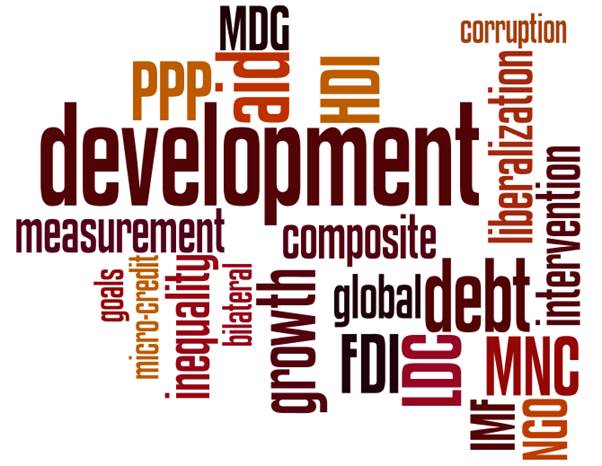
The aims of the economics course at HL and SL are to enable students to:
- develop an understanding of microeconomic and macroeconomic theories and concepts and their real-world application
- develop an appreciation of the impact on individuals and societies of economic interactions between nations
- develop an awareness of development issues facing nations as they undergo the process of change.
Assessment Objectives
Having followed the economics course at HL or SL, students will be expected to:
- AO1 Demonstrate knowledge and understanding of specified content
- Demonstrate knowledge and understanding of the common SL/HL syllabus
- Demonstrate knowledge and understanding of current economic issues and data
- At HL only: Demonstrate knowledge and understanding of the higher level extension topics
- AO2 Demonstrate application and analysis of knowledge and understanding
- Apply economic concepts and theories to real-world situations
- Identify and interpret economic data
- Demonstrate the extent to which economic information is used effectively in particular contexts
- At HL only: Demonstrate application and analysis of the extension topics
- AO3 Demonstrate synthesis and evaluation
- Examine economic concepts and theories
- Use economic concepts and examples to construct and present an argument
- Discuss and evaluate economic information and theories
- At HL only: Demonstrate economic synthesis and evaluation of the extension topics
- AO4 Select, use and apply a variety of appropriate skills and techniques
- Produce well-structured written material, using appropriate economic terminology, within specified time limits
- Use correctly labelled diagrams to help explain economic concepts and theories
- Select, interpret and analyse appropriate extracts from the news media
- Interpret appropriate data sets
- At HL only: Use quantitative techniques to identify, explain and analyse economic relationships
Unit Four Structure
Unit four has 8 core sub-topics.
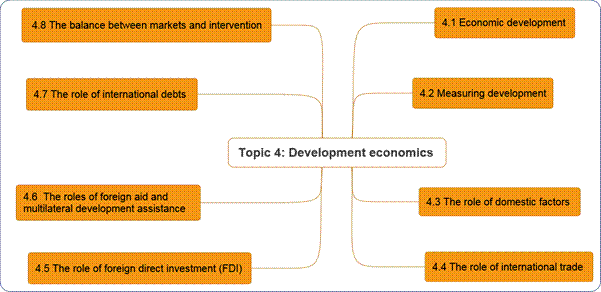
4.1 Economic development (notes)
In this section we will look at the nature of economic growth and economic development.
By the end of this section you should be able to:

- Distinguish between economic growth and economic development.
- Explain the multidimensional nature of economic development in terms of reducing widespread poverty, raising living standards, reducing income inequalities and increasing employment opportunities.
- Explain that the most important sources of economic growth in economically less developed countries include increases in quantities of physical capital and human capital, the development and use of new technologies that are appropriate to the conditions of the economically less developed countries, and institutional changes.
- Explain the relationship between economic growth and economic development, noting that some limited economic development is possible in the absence of economic growth, but that over the long term economic growth is usually necessary for economic development (however, it should be understood that under certain circumstances economic growth may not lead to economic development).
- Explain the relationship between economic growth and economic development, noting that some limited economic development is possible in the absence of economic growth, but that over the long term economic growth is usually necessary for economic development (however, it should be understood that under certain circumstances economic growth may not lead to economic development).
- Explain, using examples, that economically less developed countries differ enormously from each other in terms of a variety of factors, including resource endowments, climate, history (colonial or otherwise), political systems and degree of political stability.
- Outline the current status of international development goals, including the Millennium Development Goals.
Economic development - introduction
Introduction
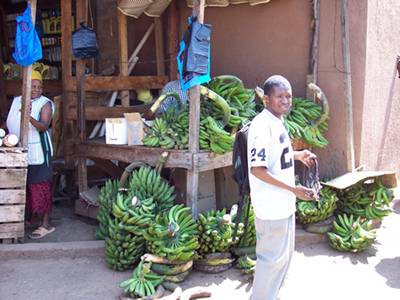 In this section we consider the following sub-topics in detail
In this section we consider the following sub-topics in detail
- The nature of economic growth and development
- Common characteristics of economically less developed countries
- Diversity among economically less developed nations
- International development goals
Economic growth is covered in detail in the Triple A Learning BACCpack on Macroeconomics. Economic growth is vital to delivering improvements in standards of living and many of the policies pursued by national governments and international groupings are concerned with driving this growth. So how does economic growth differ from concept of the development of an economy? Well, development is a much broader concept than economic growth and may mean different things to different people. For some, development literally means access to shelter, health care and some form of employment. At the macro level, development tends to concentrate on promoting growth, increasing access to education and other essentials of life that for most in developed economies are taken for granted.
It is also important to distinguish between economic growth and economic development, because a rapidly growing economy does not necessarily lead to rapid economic development. We will examine this in greater detail as we move through this pack.
Development - pause for thought

Brazil is a South American country that has experienced high levels of economic growth over the last ten years. Look at the photograph below of Sao Paulo in Brazil.

- Identify three pieces of evidence suggesting that Brazil is a developed economy and three pieces of evidence that also shows a lack of economic development.
- Examine the strength of evidence in both cases.
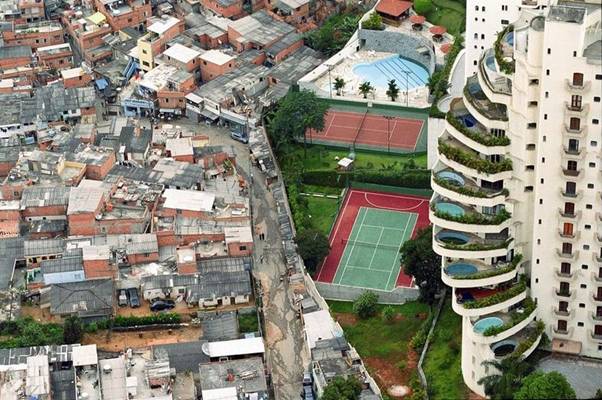
Economic growth and economic development

Economic growth
This occurs where there is an increase in the productive potential of the economy and is best measured by the increase in a country's real level of output over a period of time, i.e. the increase in real Gross Domestic Product (real means adjusted for inflation).

Economic development
Economic development, on the other hand, is a process where there is improvement in the lives of all people in the country. This involves not only living standards, such as greater availability of goods and services (and also the ability to purchase them) but also the promotion of attributes such as self-esteem, dignity and respect, and the enlarging of people's freedom to choose and to take control of their own lives. While a country may grow richer therefore, through the growth of its real output, it does not necessarily mean that it will develop.
For a long period of time economic development was seen to be a factor of economic growth. It was believed that economic development occurred when there was a high level of industrialisation and economic growth; social factors, such as poverty and unemployment were of lesser importance. It was also believed that the material benefits of growth would trickle down from the better off to the rest of the population, causing development. However, many developing nations have managed to achieve high rates of economic growth, yet failed to experience any positive change in standards of living for the majority of their people. It was realised, therefore, that the definition of economic development had to be changed. As Dudley Seers says: "if one or two of the central problems (poverty, unemployment or equality) have been growing worse, especially if all three have, it would be strange to call the result 'development' even if per capita income doubled"(from D.Seers, 'The meaning of economic development').
According to Professor Michael Todaro, development should involve the following objectives:
- "To increase the availability and widen the distribution of basic life-sustaining goods such as food, shelter, health and protection.
- To raise levels of living including, in addition to higher incomes, the provision of more jobs, better education, and greater attention to cultural and humanistic values, all of which will serve not only to enhance material well-being but also to generate greater individual and national self-esteem.
- To expand the range of economic and social choices available to individuals and nations by freeing them from servitude and dependence not only in relation to other people and nation-states but also to the forces of ignorance and human misery."
(from M.P.Todaro 'Economic development')
There are several measures that are used to measure economic development such as GNP/GDP per capita, population growth and structure, health, education, technology, employment, rural/urban migration, rights of women and distribution of poverty and income. Statistically, GDP per capita is generally acknowledged as the best single indicator but composite indicators of development are also used. One such index is the Human Development Index (HDI) which includes GDP per capita, life expectancy and literacy rates.
Sustainability

Sustainability
Sustainability is the ability of the environment to survive its use for economic activity.
 For economic growth to be sustainable, it must have a neutral effect on resources. Any resources used must be renewable and there must be no lasting impact on the environment. It is important that development is sustainable to ensure that it can endure in the long-term and is not built on the exploitation of natural resources that may run out in the future.
For economic growth to be sustainable, it must have a neutral effect on resources. Any resources used must be renewable and there must be no lasting impact on the environment. It is important that development is sustainable to ensure that it can endure in the long-term and is not built on the exploitation of natural resources that may run out in the future.
Some doubt if this is really possible, but to achieve it means investing more in such ventures as:
- Recycling
- Using alternative methods and resources to generate power
- Watching our biodiversity
- Admitting to both social costs and benefits and accepting that someone has to pay the true cost of resource allocation.
Achieving this may mean developing ways of:
- Extending property rights - this means extending ownership of resources to allow people to protect the environment and other resources more effectively.
- Taxing the polluter - if a tax is imposed that is equal to the external cost of an activity, this should ensure that resources are allocated in the interests of society.
- Issuing permits to pollute (tradable permits) - these allow firms to pollute a certain amount, but if they exceed their limit, they have to buy more permits. Firms which under-use their permits can sell them. This effectively taxes poorly performing organisations and subsidies firms using best practice.
- Introducing congestion charges and other road pricing policies to combat traffic congestion.
- Using direct controls and regulations on certain types of economic activity.
The sources of economic growth and economic development
 The sources of growth in a less developed economy are no different from those in the advanced industrialised countries. There are four basic requirements, which are:
The sources of growth in a less developed economy are no different from those in the advanced industrialised countries. There are four basic requirements, which are:
- Natural resources - land, minerals, fuels, climate; their quantity and quality.
- Human resources - the supply of labour and the quality of labour.
- Physical capital and technological factors - machines, factories, roads; their quantity and quality.
- Institutional factors - which may include the banking system, the legal system and important factors like a good health care system. We look at this in more detail in Section 4.3.
Economic growth is caused by improvements in the quantity and quality of the factors of production that a country has available, i.e. land, labour, capital and enterprise. Conversely, economic decline may occur if the quantity and quality of any of the factors of production falls. In this section we look at approaches that developing countries could take to improve the quantity and quality of factors of production. We consider the following topics in detail:
- Natural factors
- Human factors
- Physical capital and technological factors
- Institutional factors
Natural factors
Improving the quantity and quality of land resources
 Increases in the quantity of land available for agriculture will increase economic growth. However, the extent to which this happens is limited by the extent to which bush land can be converted to agricultural land (this process may have negative effects on soil erosion and quality, and contribute to deforestation globally). All economic resources are scarce and have an opportunity cost. As bush land is increasingly used for agricultural purposes, it is no longer a habitat for wildlife.
Increases in the quantity of land available for agriculture will increase economic growth. However, the extent to which this happens is limited by the extent to which bush land can be converted to agricultural land (this process may have negative effects on soil erosion and quality, and contribute to deforestation globally). All economic resources are scarce and have an opportunity cost. As bush land is increasingly used for agricultural purposes, it is no longer a habitat for wildlife.
The relative scarcity of land in the face of a growing population means that the law of diminishing returns might also become relevant. This law predicts that, if an increasing amount of labour is applied to a fixed quantity of land, the marginal productivity of the labour will fall. This was the basis of the argument put forward by the Reverend Thomas Malthus. To prevent this loss in productivity, the quality of the land must be improved. This can be done through the application of better technology through improved irrigation, fertilisers and pest control.

Pause for thought
The concept of opportunity cost is an important one in economics. Production inevitably involves making sacrifices. Consider the ethical issues involved in the arguments about whether land should be used for agriculture and food production for humans or for wildlife habitats.
Importance of agriculture
For many developing economies, agriculture is the largest single sector in the economy. For the 70% of the world's poor who live in rural areas, agriculture is the main source of income and employment. However, depletion and degradation of land and water pose serious challenges to producing enough food and other agricultural products to sustain livelihoods in rural areas and to meet the needs of urban populations.
Click on the this World Bank link to access data on agriculture and rural development with measures of agricultural inputs, outputs, and productivity compiled by the UN's Food and Agriculture Organization.
An excellent source of interactive economic data is the Gapminder site which allows you to explore economic trends through visualisations, showing changes through time and options to examine both global and national data. It also allows comparisons between countries.
This visualisation demonstrates the decline over time in the agriculture sector as a percentage of national GDP in most countries. You can look at the agricultural sector visualisation in the window below or click on the previous link to open it in a new web window:
You can select particular countries to highlight from the bar on the right hand side of the page. You can also select different axes for your visualisation by clicking on the arrow on either or both of these axes.
N.B. If the visualisation does not come up with Agriculture (% of GDP) on the vertical axis and Income per person (GDP/capita, PPP$ inflation-adjusted) on the horizontal axis, then simply select these by clicking on the arrows.

- Run the visualisation for ALL countries
- Select Tanzania and India in the box on the right of the visualisation and rerun the visualisation
- Comment on what the visualisation shows for India and Tanzania
- Search the internet for background to these trends and write a short summary explaining the differences between the two countries

You could start your research by looking at the following:
- CIA factbook
- TANZANIA: 50 YEARS OF INDEPENDENCE Economic development mismatches population rise
- Economy of India
- India May Overtake China in GDP Growth by 2012

So why are natural resources such an important issue in developing countries and what can be done to improve the situation? Summarise what we have considered above and then follow the natural resources link below to see the major issues
Gapminder also has an excellent presentational tool, called Gapminder desktop which allows you to download visualisation sets onto your computer for use in presentations, even when there is no internet access. The following video provides useful instructions and hints on how to incorporate visualisations into your presentations.

Using Gapminder desktop
Externalities
This section links with the discussion of externalities in theTriple A Learning microeconomics BACCpack, Section 1.4 (reasons for market failure). It would be useful if you thoroughly revised this part of the course before proceeding with this section. Can you, for example, accurately define the term 'negative externality' and distinguish negative externalities from social cost?
All of us have recently become aware of the real cost of resource usage. We now need to be conscious of externalities. How will the developing world control air pollution, or the risk of deforestation? Will they simply become the dumping ground for rich nations' waste?
Another negative externality from growth might be soil erosion and degradation. There are also the issues of water scarcity, pollution and waste disposal. All of these challenges face countries in the developed world but those experiencing the challenges of economic development have to 'balance' their desire to grow against the possible problems that might arise. The reduction in their biodiversity might also need to be addressed, as will atmospheric changes. Do the developing countries:
- Ban certain activities or impose strict rules and controls?
- Extend property rights and force private enterprise to pay more for the problems they cause?
- Impose taxes on pollution and other externalities?
- Subsidise non-pollution methods of production?
- Award permits to pollute?

Pause for thought
All developed countries have achieved rapid growth at some point in their history and in doing so have incurred significant external costs to society.
- Should less developed countries also not be entitled to grow in such a manner until they are in a better position to invest in technologies that reduce these external costs and are more sustainable?
- To what extent are the rich countries applying double standards when arguing that LDC should restrict production that involves negative externalities?
To achieve their goals, the developing countries will also need to address problems of:
- Land ownership and reform
- Involving local communities in their own development
- Engaging the poor and making them feel that opportunities will come their way
- Pricing in ways that include the real costs of development
So externalities need to be taken into account when considering development, but for many developing countries there will be a significant opportunity cost if they try to grow economically while minimising externalities, because this requires investment and perhaps reform - both of which are expensive.
Case study - farming in Kenya


The video clips highlight the problems experienced by a Kenyan farmer and look at some of the practices that he has introduced that enables him to overcome them.
Part 1
Part 2

You may want reflect upon the following questions whilst you are watching the video and to make some brief outline notes during and after the video for revision purposes.
- To what extent does the farm differ from those in your own country?
- Identify and explain the problems that farmers face in Kenya.
- Describe how this farmer attempted to overcome these problems?
- To what extent to you think the farmer is practicing sustainable agriculture?
You might want to review the section on sustainable development to help you draw your conclusion.
Human factors
Improving the quantity and quality of human resources
The quantity of labour is important. Increases in the population can increase the number of young people entering the labour force and these increases in the supply of labour can increase economic growth. Increases in the population can also lead to an increase in market demand thus stimulating production. However, if the population grows at a faster rate than the level of GDP, the GDP per capita will fall. This can be seen from the two charts below.
Chart 1 Average GDP growth 2006-9
There is also a static version of this chart available.
Chart 2 Average GDP growth per capita 2006-9
There is also a static version of this chart available.
Note the difference between these last two graphs. The first shows average GDP growth over the last two decades and the second shows the same figure, but adjusted to show how much GDP per capita (per person) has changed. This effectively adjusts for changes in the population. Where there is little or no change in population the difference is small (e.g. the UK), but where population is growing fast (e.g. Tanzania) the difference is greater.
However, it is not simply the amount of labour that will lead to economic growth. It is also the quality of that labour. This will depend on the educational provision in countries. Improving the skills of the work force is seen as being a key factor in promoting economic growth. Many LDCs have made enormous efforts to provide universal primary education. As more and more capital is used, labour has to be better trained in the skills to use the capital, such as servicing tractors and water pumps, running hotels and installing electricity. It should always be remembered that education spending involves an opportunity cost in terms of current consumption and thus it is often referred to as investment spending on human capital.
So what we can be done to improve the quality of labour and boost economic growth? Think through some ideas and then follow the link below to see how your answers compare.
Human resources
The enrolment in education and illiteracy levels in selected countries can be seen in charts 3 and 4 below.
Chart 3 Primary and secondary enrolment in education (% age group)
There is also a static version of this chart available.
Chart 4 Illiteracy (illiterate % age 15 and above)
There is also a static version of this chart available.
The quantity of labour is affected by the labour supply and, as we have seen in the previous section, this will depend on changes in the population. In this section we look at some background to population and the factors that will affect it.
Population
Population will be an important part of the development of many of the economies we are looking at.
Chart 1 Total population
There is also a static version of this chart available.
Chart 2 Population growth
There is also a static version of this chart available.

For further information on population and world population data, population pyramids and a world population clock, it may be worth looking at the World Population Information site provided by the US Census Bureau.
To see the trend in population growth watch this visualisation on the Gapminder site. You can select the specific countries that interest you on the right hand bar.
The net population increase figure (births - deaths + migration) will be an important factor as it is this that determines the growth rate of the population - the quantity of labour as a resource. In some developing economies, population growth is still around 4% per annum. In the short run, this will put pressure on education and employment but eventually social provision for the elderly will have to be financed. Population growth also impacts on the:
- Supply of food - although little starvation exists in the developing world, malnutrition (see chart 3 below) is a major problem in many countries. It adds to the size of infant mortality.
- Environment - food pressure puts pressure on land and takes valuable resources away from other sectors. Intensive methods require inputs that might damage the environment. GM crops are thought by some to be a major reducer of poverty whilst for others they threaten our very survival.
Chart 3 Child malnutrition - weight for age (% of under 5)
There is also a static version of this chart available.
Age is also an important consideration when looking at the population and its structure. We need to consider the dependency ratio - the proportion of those of working age to those who are dependent. The dependent population will include those of school age and those over the age of retirement. The dependent population will, by definition, need to be supported by those who are actively working but, in the longer term, economic development will be crucially determined by the quality of education and training received by the younger element of the dependent population. Often, however, in developing countries, children do not receive an appropriate education on account of the following:
(a) Inadequate education systems
(b) The need to keep children away from school to work on the land
(c) A lack of adequate jobs for those who have received a more formal education. The lack of jobs may lead to crime and increasing drug abuse, and an unwillingness to attend school in the first place.
For many young women, the only way to guarantee some form of security is to accept early marriage and child bearing.
Government and the birth rate - development implies better health, education etc. and a fast growing population makes this more difficult. So, should government try to influence the size of families? China tried this with its one child policy. Some of the problems associated with this form of population manipulation are not attractive.
Whatever the government decides to do, one fact is agreed upon by most, namely, that as an economy develops, so the number of conceptions per female declines. It therefore follows that policies designed to raise the living standards of the poor, e.g. redistributive fiscal policy, are likely to be the most effective way to reduce the rate of population increase - certainly more effective than just handing out contraceptives!
Chart 4 Fertility rate (births per woman)
There is also a static version of this chart available.
Chart 5 Contraception (% aged 15-49 using contraception)
There is also a static version of this chart available.
Education - health care and family planning can feature in government-sponsored programmes. As mentioned earlier fiscal (tax) incentives can be used to encourage families to have fewer children.
The role of women in society - if women can earn some money - say by a female only micro loan and then save this in a women-only bank, then they can gain some financial independence. This seems to be a successful way of reducing family sizes.
Migration - the pull of cities continues to cause large numbers to move to urban areas. Some argue that agricultural workers have low productivity and that they should be encouraged to move to cities and to take the higher productivity jobs to be found there. However, they create little, if anything, if all they drift into is unemployment, underemployment, poverty, crime and often prostitution.
Many of those who migrate to the cities do so on the expectation that eventually they will earn more than in the rural areas. Perhaps it might be best if some government funding went to the rural areas, so making life in those regions more closely resemble what the rural dwellers perceive urban life to be? This would take both money and time, as schools, hospitals, roads etc would be needed to offer a similar lifestyle to that which the urban dweller supposedly has access to.
The question of land ownership is also likely to be a crucial factor in preventing rural-urban migration, and policies which redistribute land from absentee landlords to landless peasants, although politically controversial, are likely to be a key factor in reducing the 'push' off the land and the 'pull' of the city.
Chart 6 Urban population as a % of total population
There is also a static version of this chart available.
Physical capital and technological factors
Improving the quantity and quality of capital resources
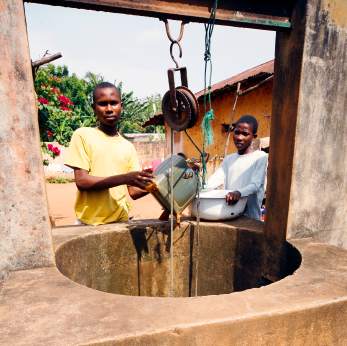 When looking at capital resources (machinery, equipment and so on), it is important to distinguish between:
When looking at capital resources (machinery, equipment and so on), it is important to distinguish between:
- Directly productive capital - plant and equipment, e.g. factories
- Indirectly productive capital - infrastructure or facilitating capital, e.g. roads and railways.
The process of acquiring capital is called investment. However, like many economic decisions, there is an opportunity cost involved in any investment decision. The opportunity cost of capital investment is the current consumption foregone. This makes it tempting not to invest, but the level of investment and the quality of investment will directly affect the level of economic growth - particularly in the long term. The efficiency of the labour force and the other factors of production will depend upon the amount and quality of capital they have. In LDCs, some investment comes from abroad in the form of foreign direct investment (FDI). This is usually through multinational enterprises locating in a country. There has been criticism of some investment in LDCs as to whether it is appropriate, but this is an issue we will look at later. If production moves from being labour intensive to capital intensive, unemployment and poverty may increase, so there may be a difficult transition process for an economy aiming to develop through investment which is not geared towards the needs of the population.
The need to invest in improved infrastructure becomes clear when we look at the provision of basic roads, telecommunications systems and other vital infrastructure requirements in developing countries.
For more detail on capital formation and the issues associated with raising money for this investment follow the link below.
Capital formation
Technology and its use is another important aspect of development and countries have to try to keep up with technological change, wherever possible. Have a careful think about the issues that are associated with this technological change and then follow the link below to compare the issues that you have identified with ours.
Technological change and innovations
Institutional factors
 As we saw in the introduction to this section, it is no good just improving the factors of production. A country also needs a good quality infrastructure to support them. This means having a suitable financial, legal and social institutional framework. Important institutional factors are therefore:
As we saw in the introduction to this section, it is no good just improving the factors of production. A country also needs a good quality infrastructure to support them. This means having a suitable financial, legal and social institutional framework. Important institutional factors are therefore:
- The banking system - a good banking system provides the financial infrastructure that enables businesses to flourish and grow. This makes it an important driver of economic growth. Often such a system is lacking in developing countries.
- The educational system - this could also be included under the human resources heading above. Growth requires a high quality, well educated workforce. This in turn needs a good educational system to provide for as many people as possible.
- Health care - a healthy workforce and population is just as important as a well educated one. This means a good health care system.
- Infrastructure - economic activity needs an infrastructure to support it. Roads, ports, telecommunications networks - all these are vital elements to support economic development.
- Political stability - without political stability there will not be certainty and businesses require certainty to enable them to plan for the future. A stable political environment is likely to be a key factor in determining whether or not businesses are prepared to undertake major investment projects.
However, in some developing countries the infrastructure, governance and financial and social institutions present are poor and present significant barriers to growth and development. The next section highlights some of the barriers to growth and development associated with poor governance and institutions. Many of the issues raised will be discussed in more detail later in the pack.
As we have seen many developing countries have a poor institutional framework. They may face a range of barriers to growth. These may include:
- Ineffective taxation structure - in many developing economies, governments face enormous problems in collecting tax. These may be physical problems (actually accessing the communities in rural areas) or simply data information problems - poor records of the population. This makes it very difficult to collect tax revenue and low tax revenue makes it difficult to develop the required institutions.
- Lack of property rights - many developed economies lack a well-developed system of property rights. Property is allocated on traditional or tribal grounds or ownership is perhaps even unknown. This can prevent economic development as growth is stimulated by the trading of the factors of production.
- Political instability - if there is political instability then it is very difficult for economic activity to develop and grow. If businesses are to grow, then they need stability and a reasonably consistent or predictable political structure. Without this, development becomes a lot more difficult as there will be an unwillingness to engage in capital investment.
- Corruption - this almost speaks for itself. Corruption makes development difficult and can certainly act as a barrier for overseas firms investing in an economy.
- Unequal distribution of income -income distribution will tend to widen as economies grow. This can act as a barrier to growth. Those on the lowest income levels will often have the highest marginal propensity to consume and therefore if they get an increase in their incomes, they are likely to spend it. This will help drive demand growth. However, if growth simply means that the rich get richer (and perhaps even move their money overseas) this will act as a constraint on development.
- Formal and informal markets - in the developed world most activity takes place in formal markets - that is organized markets where money is exchanged. However, in the developing world much of the economic activity takes place in informal markets. No money is exchanged and economic activity goes unrecorded.
- Lack of infrastructure - a good quality social infrastructure is vital for economic development, but in the developing world the infrastructure is often very poor. This is a significant barrier to growth and development and we look at this in more detail below.

Building a development Database (Part 1)
Often data speaks louder than words. We can see use data to see the differences in the infrastructure between developing and developed countries. In the rich world infrastructure quality and reliability is taken for granted. The lack of social infrastructure significantly impedes the level of economic growth and development in LDCs. For example:
- LDCs lack human capital in sufficient supply to be able to develop their resources and add value to them.
- High population places enormous strain on facilities and in many LDCs standards of living are actually getting worse. The 'dependency rates' are becoming larger as those in work become responsible for more who are not directly contributing to the economy.
- High population growth also places enormous burdens on the health facilities and infant deaths remain very high in many LDCs.
- With so many people living in LDCS, finding a job can be difficult. This leads to both high unemployment and underemployment (when people have a job, say selling single cigarettes, but which does not constitute a formal full-time form of employment).
- Go to the World Bank data site http://data.worldbank.org/ and find figures for a selection of the following variables:
- Agriculture irrigated land (% of total agricultural land)
- Improved sanitation facilities
- Electric power consumption (kWh per capita)
- Fixed broadband internet subscribers
- Improved water source, rural (% of rural population with access)
- Improved water source, urban (% of rural population with access)
- Motor vehicles (per 1,000 people)
- Roads, paved (% of total roads)
for the following countries:
- Australia
- China
- Romania
- Ecuador
- Italy
- Thailand
- Uganda
- USA
- Enter the data into a spreadsheet.
- Analyse the differences in infrastructure revealed by the data.
The consequences of growth for Development
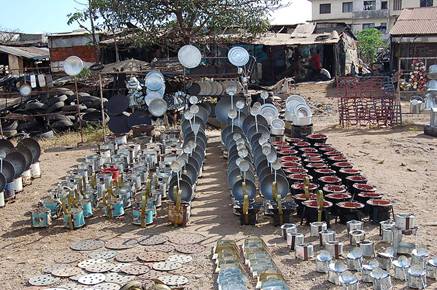 'Growth is good'. This is the standard view of economic growth, and it tends to be treated as the 'Holy Grail' of economic policy for both developed and developing countries. It may be possible for some limited economic development to take place in economies that are not experiencing economic growth. Nevertheless, over the longer term economic growth is probably necessary for development to take place. However, the impact of growth on development may not always be good. Possible costs of growth include:
'Growth is good'. This is the standard view of economic growth, and it tends to be treated as the 'Holy Grail' of economic policy for both developed and developing countries. It may be possible for some limited economic development to take place in economies that are not experiencing economic growth. Nevertheless, over the longer term economic growth is probably necessary for development to take place. However, the impact of growth on development may not always be good. Possible costs of growth include:
- Inequality of income - growth rarely delivers its benefits evenly. It often rewards the strong, but gives little to the economically weak. This will widen the income distribution in the economy. In developing economies, income distribution is frequently unequal and many of the benefits of growth may go to the better-off in society and flow overseas in the form of increased profit for multinational corporations.
- Pollution (and other negative externalities) - the drive for increased output tends to put more and more pressure on the environment and the result will often be increased pollution and resource degradation. This may be water or air pollution, but growth also creates significantly increased noise pollution. Deforestation and environmental degradation are likely to result from growth. This is particularly true in developing countries as they tend to have little legal protection of the environment.
- Loss of non-renewable resources - the more we want to produce, the more resources we need to do that. The faster we use these resources, the less time they will last.
- Loss of land - increased output puts further pressure on the available land. This may gradually erode the available countryside. In many developing economies there will also be additional problems resulting from the movement of people from country to urban areas.
- Lifestyle changes - the push for growth has in many areas put a great deal of pressure on individuals. This may have costs in terms of family and community life in many economies.

UN opens conference on unlocking economic potential of world's poorest countries
Common characteristics of economically less developed countries
In the previous section we have reviewed the factors that drive economic growth and development and the costs associated with economic growth on a country's economic development. There is often a tendency for people to make sweeping generalizations about the nature of less developed countries, the level of development that is taking place and how people lead their day to day lives. In reality, it is simply impossible to identify common characteristics that are typically found in every less developed economy. Indeed, we must be careful to recognise the considerable diversity between less developed countries in terms of their economies and the economic problems they face. Nevertheless, there are some common features that appear to be shared by many LDCs
- Low GDP per capita
- High levels of poverty
- Dependence of agriculture and the export of primary products
- Higher rates of population growth
- Low levels of productivity
- High levels of unemployment and underemployment

Pause for thought
It is very easy to lump all less develop countries together and assume that they all exhibit the same characteristics. For example, how many times do you hear people refer to Africa as a country rather a continent made up of over 50 different countries? Similarly it is often assumed that the way of life of inhabitants of these countries also tends to conform to certain stereotypical ideas. What preconceived ideas do we have about the way people in less developed countries live? Why not try to ask your friends about what they think the similarities and differences might be for young people living in less developed countries. When you have put together a list of similarities and differences you might then try to find some evidence to support or reject such assertions.
Many of these common characteristics contribute to what is known as the vicious cycle of poverty or the poverty cycle. Before we look at the cycle in more depth it may be worthwhile pausing to consider what we mean by poverty. When we talk of poverty we usually distinguish between absolute poverty and relative poverty.

Absolute poverty
Absolute poverty refers to being unable to afford basic human needs, such as clean and fresh water, nutrition, health care, education, clothing and shelter. About 1.7 billion people are estimated to live in absolute poverty today.

Relative poverty
Relative poverty refers to the lacking a usual or socially acceptable level of resources or income as compared with others within a society or country. What is considered 'acceptable' inevitably various from country to country and is significantly higher in developed countries than in developing countries.
The common international poverty line has in the past been roughly $1 a day. However in 2008, the World Bank revised this figure to $1.25 at 2005 purchasing-power parity (PPP).
Poverty cycle
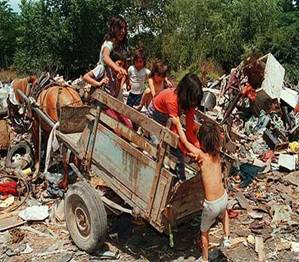 Earlier we noted that poverty and inequality are major factors holding back the development of many of the poorest countries on earth. Poverty is a grinding fact of life. Often, people receive little education, hope or access to any of the normal features of life. What value can be added to these people? They may be intelligent and gifted individuals but they will receive little, if any education. Health care will be non-existent. The inequalities apparent within their economy will breed resentment. This can lead to hatred, ethnic violence, corruption and the undermining of the democratic process. Those thinking of investing in such an economy will probably decide not to. If you earn little, say just a few dollars a day, what chance do you have of saving any money, or owning a bank account? The acquiring of capital is impossible and that precludes you from passing wealth to your direct descendants.
Earlier we noted that poverty and inequality are major factors holding back the development of many of the poorest countries on earth. Poverty is a grinding fact of life. Often, people receive little education, hope or access to any of the normal features of life. What value can be added to these people? They may be intelligent and gifted individuals but they will receive little, if any education. Health care will be non-existent. The inequalities apparent within their economy will breed resentment. This can lead to hatred, ethnic violence, corruption and the undermining of the democratic process. Those thinking of investing in such an economy will probably decide not to. If you earn little, say just a few dollars a day, what chance do you have of saving any money, or owning a bank account? The acquiring of capital is impossible and that precludes you from passing wealth to your direct descendants.
Poverty cycle
Poverty can be very difficult to reduce as many economies struggle to develop and find themselves in what is known as the 'poverty cycle'. This can be seen as a spiral of deprivation. To develop economically, countries need to invest in new and improved capital. However, investment needs funding and this requires savings. Countries with low income and low savings levels have a lack of funds for investment, which in turn leads to lower incomes. This is, in essence, a downward spiral of cumulative causation. Low incomes lead to low investment levels, which mean even lower incomes. Less developed countries need to break the cycle to develop, but how can this be achieved? This poverty cycle is shown in diagrammatic form in Figure 1 below.
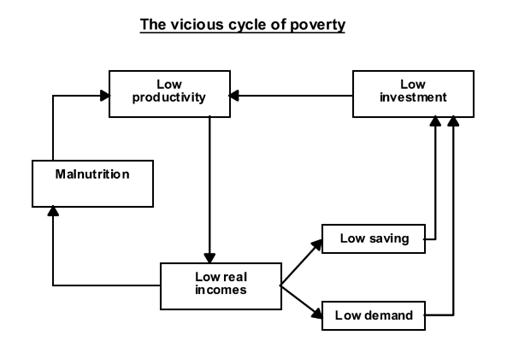
Figure 1 The vicious cycle of poverty
The poverty cycle is an example of a vicious cycle. However, it can be turned on its head and the process viewed from a positive perspective; a so called virtuous cycle. In a virtuous cycle, higher incomes will lead to higher savings and demand, enabling and encouraging more investment, raising productivity and thus increasing income. When it comes to strategies and policies to encourage economic development, it is consider how the vicious cycle of poverty can be halted and a virtuous cycle put in its place.

This poverty is clearly shown in link below to Human Poverty Index (HPI) data. The HPI is a composite index measuring deprivations in the three basic dimensions captured in the human development index-a long and healthy life, knowledge and a decent standard of living.
The 2010 Human Development Index (HDI) Report introduced three new indices to capture important aspects of the distribution of well-being for inequality, gender equity and poverty. This composite index includes:
- The Inequality-adjusted Human Development Index
- The Gender Inequality Index (GII)
- The Multidimensional Poverty Index (MPI)
Diversity among economically less developed nations
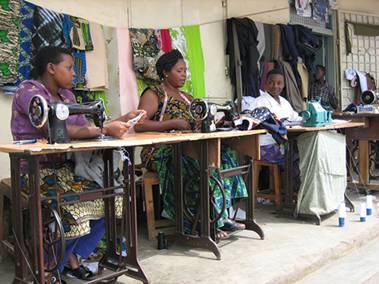 In this section, we highlight the considerable diversity between less developed countries. If we examine the four basic requirements for growth and development that we considered earlier in the section it is clear the availability and quality of each may vary enormously from one country to another. Some less developed countries such as Botswana are very well endowed as far as raw materials are concerned, some are not. The climates of some countries are conducive to high levels of agricultural productivity others constantly are have to battle again drought and irregular rain patterns. Some have large and ready supplies of labour whilst others do not. Some countries have a transport infrastructure than enables them to more readily engage in trade of goods whilst others have road and rail systems that are run down and lack sufficient capital investment. Understanding the context in which development is taking place is very important.
In this section, we highlight the considerable diversity between less developed countries. If we examine the four basic requirements for growth and development that we considered earlier in the section it is clear the availability and quality of each may vary enormously from one country to another. Some less developed countries such as Botswana are very well endowed as far as raw materials are concerned, some are not. The climates of some countries are conducive to high levels of agricultural productivity others constantly are have to battle again drought and irregular rain patterns. Some have large and ready supplies of labour whilst others do not. Some countries have a transport infrastructure than enables them to more readily engage in trade of goods whilst others have road and rail systems that are run down and lack sufficient capital investment. Understanding the context in which development is taking place is very important.
- Natural factors
- Human factors
- Physical capital and technological factors
- Institutional factors
Throughout the sections of the pack you will come across many case studies, data sets and examples taken from different developing countries. What should be becoming apparent is whilst there may be some common issues facing some of these countries, the problems they face and the solutions that may or may not be available will be very particular to a specific country.
Some economists would argue that enormous damage has been done to some countries (and their citizens) that have been pressurized to follow growth and development policies required by the multilateral agencies such as the World Bank and the IMF as conditions for loans. The variation in the natural, human, physical and technological and institutional factors affecting countries will mean that 'one size fits all' growth and development policies and approaches may make matters worse and paradoxically be anti-developmental.
International development goals
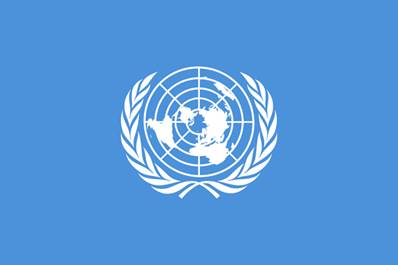 In 1970 the General Assembly of the United Nations made a commitment to the developing countries of the world that:
In 1970 the General Assembly of the United Nations made a commitment to the developing countries of the world that:
"Each economically advanced country will progressively increase its official development assistance to the developing countries and will exert its best efforts to reach a minimum net amount of 0.7 percent of its gross national product at market prices by the middle of the decade"
Over the past 40 years, since the original agreement, the members of the UN have repeatedly reiterated this commitment. However there has been disagreement from some of the richest countries such as the USA who argue that this is unfair and discriminates against the larger economies as 0.7% of a large GNP constitutes a much large sum of money that 0.7% of a small GNP.
There is still however a commitment amongst many of the richer countries to work towards achieving this goal.
Millennium Development Goals
At a Millennium Summit in 2000 the leaders of the richest countries present adopted the United Nations Millennium Declaration.
The Declaration asserts "that every individual has the right to dignity, freedom, equality, a basic standard of living that includes freedom from hunger and violence, and encourages tolerance and solidarity."
It had been realized by many including the multilateral agencies such as the UN, OECD, The World Bank and IMF that if these human rights were to be achieved a set of goals with measurable targets focusing on improving social and economic conditions in the world's poorest countries needed to be set.

Pause for thought
It has sometimes been stated that "what gets measured gets done". What is the basis for this argument and do you agree with it? If not, why not?
This realization led to the establishment of the Millennium Development Goals (MDGs) in 2001.
By setting targets and indicators for poverty reduction on a set fifteen-year timeline, ending in 2015, it was hoped that the human rights highlighted in the Declaration would be achieved. There are eight goals with 21 targets and a series of measurable indicators for each target.
Case Study - Millennium Development Goals

Read the article 'Uneven Progress of UN Millennium Development Goals' (you can do this in the window below or follow the previous link to read the article in a separate window) and then consider answers to the questions below.

You may also find the UN Millennium Development Goals and Millennium Development Goals monitor websites helpful in answering the questions below. For more details on the background to the Millennium Development Goals, see the UN Millennium Development Goals background site.
You can also find out how different countries are performing in terms of meeting the Millennium Development Goals by visiting the Aid Flows website (from the OECD and the World Bank). The site allows you to look at how the country's key development indicators change over time and arranges these according to the MDGs. It is a great resource.

- Outline the eight Millennium Development Goals.
- Why do you think the Goals have been broken down into specific measurable targets?
- Analyze the extent to which the Millennium Development Goals are currently being met.
4.1 Economic development (questions)
In this section are a series of questions on the topic - economic development. The questions may include various types of questions. For example:
- Short-answer questions - a series of short-answer questions to help you check your understanding of the topic
- Case studies - questions based around a variety of information
- Long answer - questions requiring an extended/essay type response
- Data response - responding to data or topical economics news articles
Click on the right arrow at the top or bottom of the page to work through the questions.
Short questions

Question 1
Explain the importance of human capital in contributing to economic development.
Question 2
Explain the difference between economic growth and economic development.
Question 3
Discuss the view that the achievement of higher economic growth rates should be the priority of developing economies.
Question 4
Explain what is meant by sustainable development.
Question 5
Explain how extending property rights and land ownership can help bring about more sustainable development.
Data response question (1)
As the 1970s evolved, so Nigeria was seen as one of the great hopes of the developing world. It had oil and a population that was being educated to international standards. As a consequence, bankers liked lending to such a prosperous nation. Then the oil price started to fall and lenders wanted their money back. Africa's largest country became riddled with debt, poverty and corruption. Now, despite being beset with many, there are at least some encouraging signs.
Key data - Nigeria
| Data type | 1997 | 2000 | 2001 | 2009 |
|---|---|---|---|---|
| Life expectancy (years) | 50.1 | 46.8 | 46.1 | 48 |
| Infant mortality rate (per 1,000 live births) | 111.2 | 110.0 | 110.0 | 86 |
| Under 5 mortality rate (per 1,000 children) | ... | 184.0 | 183.0 | 138 |
| GDP growth (annual %) | 2.7 | 3.8 | 3.9 | 6 |
| Exports of goods and services (% of GDP) | 45.0 | 52.3 | 48.3 | 36 |
| Imports of goods and services (% of GDP) | 37.8 | 41.1 | 49.0 | 27 |
| Total debt service (% of exports of goods and services) | 7.8 | 7.9 | 12.0 | 1 |
| Short-term debt outstanding (current US$) | 5.5 billion | 1.1 billion | 1.7 billion |
Oil prices Crude spot price US$
| 1980 | 36.86875 |
|---|---|
| 1985 | 27.18333 |
| 1990 | 22.87917 |
| 1995 | 17.18333 |
| 2000 | 28.22972 |
| 2005 | 53.39102 |
| 2010 | 79.04077 |
| 2011 | 104.7124 |

Question 1
Explain using supply and demand diagrams why in the last two decades of the 20th century the long term price of commodities such as oil fell.
Question 2
Explain how falling commodity prices can impede economic development.
Question 3
Using the data above, comment on the economic development process in Nigeria over the period 1997 to 2009.
Question 4
Examine the factors that might have caused the fall in the economic potential of a country as rich as Nigeria?
Question 5
From the early 2000s the price of oil has risen again. Using appropriate diagrams, evaluate the impact of an oil price increase on the economy of Nigeria.
Data response question (2)
Read the article Losing Thousands of Hectares of Forests Each Year and then answer the questions below.
The effect of clearing of forests to increase the amount of arable crops that can be grown is an example of a negative externality.

Question 1
Explain what is meant by a negative externality
Question 2
Using supply and demand diagrams, explain how negative externalities result in market failure.
Question 3
Examine why an increase in the level of poverty within Burkino Faso contributes to environmental degradation.
Question 4
Discuss strategies that the government of Burkina Faso could introduce to reduce the extent of forest degradation.
Data response question (3)
Read the article Small-Scale Farmers Bear the Brunt of Rapid Climate Change and then answer the questions below.

Question 1
Using supply and demand diagrams, explain what will happen to the price of tea and the revenue of tea farmers as a consequence of the drought.
Question 2
Explain the effect of farmers switching from subsistence agriculture (where they produce food for their own household consumption) to the production of cash crops for sale.
Question 3
Analyse the long term effects of recurrent droughts on small scale farming.
Question 4
Examine economic and social policies that the government of Kenya could introduce to support small scale tea farmers during periods of drought.
Long questions (1)

Question 1
Explain the concept of sustainable development and why it may be threatened by economic growth.
Question 2
Discuss the view that economic growth will inevitably conflict with sustainable development.
Long questions (2)

Question 1
(a) Using diagrams and examples where appropriate, explain what is meant by the poverty cycle.
(b) Evaluate alternative ways in which the poverty cycle can be broken.
Question 2
With reference to examples from specific countries, explain why the savings gap is considered to be an important concept when analysing development.
4.2 Measuring Economic Development (notes)
In the previous section, we looked at the nature of economic growth and economic development. In this section we will examine methods of measuring development.
By the end of this section you should be able to:

- Distinguish between GDP per capita figures and GNI per capita figures.
- Compare and contrast the GDP per capita figures and the GNI per capita figures for economically more developed countries and economically less developed countries.
- Distinguish between GDP per capita figures and GDP per capita figures at purchasing power parity (PPP) exchange rates.
- Compare and contrast GDP per capita figures and GDP per capita figures at purchasing power parity (PPP) exchange rates for economically more developed countries and economically less developed countries.
- Compare and contrast two health indicators for economically more developed countries and economically less developed countries.
- Compare and contrast two education indicators for economically more developed countries and economically less developed countries.
- Explain that composite indicators include more than one measure and so are considered to be better indicators of economic development.
- Explain the measures that make up the Human Development Index (HDI).
- Compare and contrast the HDI figures for economically more developed countries and economically less developed countries.
- Explain why a country's GDP/GNI per capita global ranking may be lower, or higher, than its HDI global ranking.
Measuring Economic Development - introduction
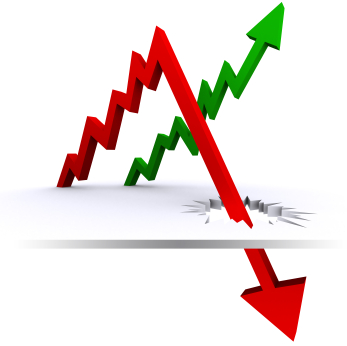 In this section we consider the following sub-topics in detail
In this section we consider the following sub-topics in detail
- Single indicators
- Composite indicators
Single indicators
As we saw in Section 4.1, there are various measures of national income and economic growth. GDP and GNP are two of these single indicators. GDP considers all output that has been domestically produced, whereas GNP, now often referred to as GNI (or Gross National Income) takes into account net property income from abroad or paid abroad.
Few less developed countries (LDC's) have national companies operating in overseas markets, but there is a good chance that they will have foreign multinational companies (MNCs) operating in their country. Developing economies often offer a good low cost base for production for MNCs, which attracts them to locate there. However, MNCs tend to return profits overseas to where the parent company is located, rather than reinvesting in the local economies where they are located and operate. This can mean large net outflows of profit from developing economies making GNP lower than GDP. In addition, the large overseas debts of many LDC's results in further large outflows in the form of interest repayments. So, if we want a measure of national income to focus on domestic development, it may be better to look at GDP figures, rather than GNP. However, for many reasons this measure may not be adequate.
This section is going to require you to build a database of key development indicators for a number of countries. Having done this, you will be asked to analyse the data you have gathered and draw some conclusions. The questions you will be offer guidance on how the data should be analysed and the areas where conclusion and insights should be offered.
Building a development Database (Part 2)

- Go to the World Bank data site http://data.worldbank.org/ and find GDP, GNP and GDP per capita figures for the following countries:
- Australia
- China
- Romania
- Ecuador
- Italy
- Thailand
- Uganda
- USA
- Enter the data into a spreadsheet.
- Produce a list showing the countries in rank order based on GDP per capita.
- Choose two countries with a marked difference in GDP per capita and see if you can find out what factors cause the differences in their GDP per capita.
- To what extent do you think the list from question 3 gives an accurate picture of the living standards of the respective population?
In Section 2.1 you came across some of the problems of using GDP and GNP data as reliable indicators of welfare and living standards. We saw that increases in population will reduce per capita GDP and per capita GNP figures, suggesting that living standards may have fallen because national income is divided between more people.
Similarly, inflation will increase the value of GDP in nominal terms, but not in real terms. Indeed, if the rate of inflation is growing faster than the countries' national income, then real GDP figures will fall and possibly reduce peoples' living standards. However, even using real GDP figures as an indicator of economic development and welfare is not without its problems.
Limitations of using GDP to compare welfare
 We need to be careful when looking at growth and what it tells us about an economy. Simply because a country appears to be getting wealthier does not actually mean that it is. Indeed, using national income figures, such as GDP, as measures of living standards may be inappropriate. An increase in real GDP denotes an increase in the output of goods and services of the economy, but does this necessarily lead to a corresponding increase in welfare?
We need to be careful when looking at growth and what it tells us about an economy. Simply because a country appears to be getting wealthier does not actually mean that it is. Indeed, using national income figures, such as GDP, as measures of living standards may be inappropriate. An increase in real GDP denotes an increase in the output of goods and services of the economy, but does this necessarily lead to a corresponding increase in welfare?
When comparing economic growth or GDP figures between countries consider:
- What the figure measures, e.g. GDP per head per year.
- How the GDP is distributed.
- The type of economy under consideration, e.g. developed or developing,
- The costs of basic commodities in certain economies, e.g. housing in UK against an housing in Uganda.
- How taxes are charged and who actually pays them.
- What level of social benefits are paid, and to whom.
- Life expectancy, protein intake and years in education.
- Access to basic amenities, such as clean water.
- The proportion of goods and services that are not traded, e.g. home-grown food, bartered services. The presence of these can distort national income figures significantly as they are not recorded in the data. As we shall see later, many developing countries have large informal sectors, where the goods and services are produced without government knowledge and/or control.
- The problem of comparing national incomes expressed in different currencies and the use of the official exchange rate for this purpose.
- The composition of the output, e.g. in terms of armaments and welfare services.
- The extent to which additional output has generated negative externalities, which may affect the quality of life.
Comparing welfare
Allowances for differences in purchasing power when comparing welfare between countries
We saw in the previous section that GDP alone is not a completely adequate measure of the standard of living, though it is often used as a proxy for it. If we do use GDP as a measure of standard of living, then we also need to take account of differences between the purchasing power of GDP. If you have travelled much, you will be aware that prices of goods in other countries often appear cheaper / more expensive. This may appear the case to us as tourists, but not always to the people living there. This may be the case for a number of reasons. Certainly, changes in the exchange rate will affect purchasing power of foreign visitors, but other economic factors are at play.
It may be that a lower GDP per capita will provide the same standard of living compared to a country with a higher GDP per capita, because the same level of income can buy more in that country - in other words real prices are lower. So when comparing GDP between countries it is necessary to adjust for the purchasing power of the GDP. Differences in purchasing power often relate to exchange rate differentials. Although purchasing power is one factor affecting exchange rates, there are many others as well and a country's exchange rate may well be out of line with what is called the purchasing power parity (PPP) exchange rate.
Purchasing power parity (PPP) exchange rates are used for currency conversion allowing for differences in price levels between countries. Normally they are given in national currency units per US dollar. We begin the process by identifying a set basket of goods and comparing the cost of this basket between countries and then using this comparison to adjust the official exchange rate. If, for example, this basket costs $100 in the US and 1000 rupees in India; it would indicate that one dollar provides exactly the same purchasing power as 10 rupees. The purchasing power parity (PPP) exchange rate is, therefore, defined as US$1=10 rupees.
This method more accurately compares incomes across countries. It converts income in each country from that country's domestic currency to US dollars using purchasing power parities rather than the usual method of using official exchange rates or market exchange rates. Purchasing power parity adjusts official exchange rates for cost-of-living differences between the US and the country in question.
When comparing GDP levels we should always compare GDP per capita translated at purchasing power parity rates.
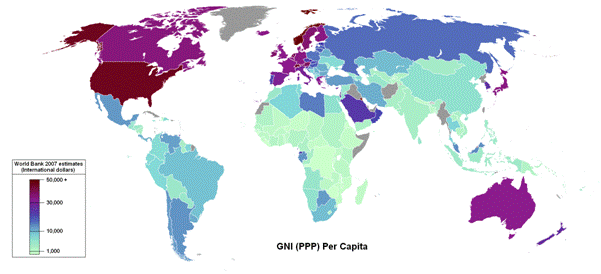
GNI per capita (purchasing power parity) 2007

You may find the following world Bank publication helpful in understanding purchasing power parity.
Building a development database (Part 3)

- Return to the World Bank data website site and find GDP, GNP and GDP per capita figures for the following countries expressed in terms purchasing power parity and add them to your economic development spreadsheet:
- Australia
- China
- Romania
- Ecuador
- Italy
- Thailand
- Uganda
- USA
- Explain the effect of valuing GDP, GNP and GDP per capita in terms of purchasing power parity (PPP), rather than simply expressing them in US dollars.
- Identify the values which are greater and whether this is the case for all countries.
- Produce a list showing the countries in rank order based on GDP per capita (PPP).
- Are the figures the same? Which countries show the largest variation between the two values? Can you offer some reasons why this might be the case?
- How does it compare with the list expressed in terms of GDP per capita (US dollars) Is the rank order the same? If not, why do you think this is?
Alternative single indicators
 We have identified the problems of using GDP and GNP figures as the basis for comparing living standards and economic development between countries. The quality of life comes from a combination of many factors, such as:
We have identified the problems of using GDP and GNP figures as the basis for comparing living standards and economic development between countries. The quality of life comes from a combination of many factors, such as:
- Access to health care - a good measure of this is doctors or nurses per 1,000 people, though there are others.
- Infant mortality - what proportion of children live beyond their fifth birthday?
- Maternal mortality - how many mothers die in childbirth?
- Life expectancy - how long are people expected to live and are there differences between genders and/or regions?
- Access to safe water - is the water supply safe and how far do people have to travel to get to obtain water?
- Agriculture as a percentage of GDP - many developing economies are heavily reliant on their primary sectors.
- Child malnutrition - how much nutrition are children receiving in their diet? Although difficult to quantify, this is a vital indicator of the standard of living.
- Environmental measures - emissions, air quality, pollution indicators, cleanliness of water supply, quality of beaches and so on.
- De-forestation rate - how rapidly is an economy using up its resources?
- Expenditure on social security - social security is a vital safety net for the less well-off, but many developing economies have very poorly developed social security systems, if any.
- Food aid - how much food and other overseas aid is being received?
- Households with electricity - this is a useful measure of how well developed the infrastructure is.
- Transport infrastructure - transport is vital to economic development and trade.
- Poverty - how many people are living below the poverty line?
- Access to education - one measure is the pupil/teacher ratio (number of teachers per 1000 etc.), but we could also look at the proportion of the population enrolled at primary, secondary and tertiary levels of education.
- Leisure - access to leisure services, Internet connectivity and so on.
To this standard of living list can be added political factors such as:
- Open government
- Democracy
- Accountable government
- Civil rights
- Rights of women and minority groups

We have to be careful not to confuse the cost of living with the standard of living. The cost of living depends on the rate of change of prices and the standard of living will partly depend on income levels combined with the factors considered above.
As you can see, GDP alone is a fairly inadequate measure of welfare - other factors need to be considered and be even more important.
Building a development database (Part 4)

- For the following countries find out the values for indicators relating to the relating to development and living standards and add them to your database. There are often a number of different indicators that you could use so choose one you consider appropriate. A list of possible measures is included below.
- Australia
- China
- Romania
- Ecuador
- Italy
- Thailand
- Uganda
- USA
- access to health care
- nutrition
- infant mortality,
- maternal mortality,
- life expectancy,
- access to education,
- access to safe water,
- Outline how these indicators differ from the GDP per capita (PPP) data you found earlier.
- Analyse the reliability of GDP per capita (PPP) as an indicator of development.
- Prepare a rank ordered list of the countries in terms of their level of economic development. Discuss the problems you found in doing this.
Perspectives on development (videos)
For some interesting insights and perspectives into development and how data can be used to show how development is taking place across over the world and over time you may want to have a look at these two clips of Hans Rosling professor of global health at Sweden's Karolinska Institute. Follow the links below the videos to open them in a new web window.

http://www.ted.com/talks/hans_rosling_shows_the_best_stats_you_ve_ever_seen.html
http://www.ted.com/talks/hans_rosling_reveals_new_insights_on_poverty.html

Pause for thought
Clearly there are a number of ways of "measuring" development. What criteria could we use to determine whether a particular way of measuring development is effective or not? Talk this through with other people in your class. Is there agreement? If not, why not?
Gapminder data
Having looked at the videos you may want to explore the dynamic data sets that Rosling has developed using the excellent comparative data Gapminder site mentioned in section B6. Why not have a look at the site in the window below and the first comparison made by Rosling between life expectancy and fertility rates?
Alternatively, follow the previous links to open the site in a new window.
When looking at the site, click on the either the Gapminder world or data tabs to start. Bear in mind the following:
- each bubble represents a country
- the position of the bubble is determined by the indicators on the axes
- the size of the bubble represents the population of the country
- the colour represents the country's geographic region by default, but it can be changed to show indebtedness or income group instead
To help you understand the data and appreciate what is being shown, why not try:
- Clicking on a bubble(s) to view a particular country or countries
- Drag the timeline at the bottom to view how the data has changed (or press the play button)
- Change the variables you are viewing to compare different relationships (see some suggestions below)
- Uncheck the 'Show nonselected' box at the bottom right to view just the countries you have selected (by clicking on them)
- Click on the 'map' tab top left to view the data geographically
Why not try comparing:
- Income per capita and life expectancy - is there a correlation?
- Income per capita and carbon dioxide emissions
- Income per capita and child mortality
- Economic growth and carbon dioxide emissions - should there be a relationship here?
- Income per capita and internet users
Note: you can achieve this most easily by clicking on the arrow on each of the axes to see the alternatives.

Reflect on what you would expect in each case before running the visualisation, and see if that relationship you imagined actually appears. If it does not, investigate the reasons for any differences.
Composite indicators
If you would prefer to view this interaction in a new web window, then please follow the link below:

Task (1)
Using a web search (perhaps using Google as a starting point), record the figures you find for the MEW.

Task (2)
Visit the Friends of the Earth site and build an appropriate ISEW. Experiment with changing different indicators and see which make the most difference to the ISEW. Try also clicking on the titles of the indicators to check what they each mean.
Building a development database (Part 5)

- Go to the World Bank data site and add the figures for the Human Development Index to your economic development spreadsheet for the following countries.
- Australia
- China
- Romania
- Ecuador
- Italy
- Thailand
- Uganda
- USA
- Identify the elements that make up the HDI.
- Explain how the HDI figures differ from the single indicators you found earlier.
- Using the HDI data, produce a rank order list of the above countries. Comment on the differences is the order of this list from the one you found when you listed countries in order of the GDP per capita (PPP).
- To what extent is using a composite indicator, such as the HDI, better than using a single indicator when assessing the level of economic development.
By looking at this broader interpretation of development we can begin to consider such issues as:
- Waste control and pollution
- Poor water supplies
- High real population growth
- Living standards
- Civil liberties
- The status of women
- Access to education

Pause for thought
What you would do if you were responsible for raising the living standards of people in one of the low income countries from your development database? You might like to try to decide on priorities and how these would be funded. Discuss your ideas with your fellow students.
Problems of measuring development
 While GDP provides a somewhat limited measure of economic growth and living standards, it does have the advantage of being fairly easily obtained and is based on three variables only - income, expenditure and output. In contrast to this, as can be seen from the HDI, HPI, MEW and ISEW, development is a multi-dimensional, complex process which can only be judged against a variety of criteria, using composite indices. This may give rise to various problems involving subjective, value judgments on behalf of the statisticians who construct the indices. For example, how should factors such as life expectancy and literacy be weighted within an index? Which factors should be included and which should be excluded?
While GDP provides a somewhat limited measure of economic growth and living standards, it does have the advantage of being fairly easily obtained and is based on three variables only - income, expenditure and output. In contrast to this, as can be seen from the HDI, HPI, MEW and ISEW, development is a multi-dimensional, complex process which can only be judged against a variety of criteria, using composite indices. This may give rise to various problems involving subjective, value judgments on behalf of the statisticians who construct the indices. For example, how should factors such as life expectancy and literacy be weighted within an index? Which factors should be included and which should be excluded?
So while the HDI, for example, may provide a fairly sophisticated indicator of living standards, it omits some very important components, such as environmental quality; but to construct a development index which is all-embracing would be a statistically awesome task!
Building a development database (Part 6)

- Visit the World Bank data site and add the figures for other composite indices to your economic development spreadsheet for the following countries:
- Australia
- China
- Romania
- Ecuador
- Italy
- Thailand
- Uganda
- USA
- On the basis of what you have found, compare and contrast the use of single and composite indicators as accurate and reliable measures of economic growth and development.
4.2 Measuring development (questions)
In this section are a series of questions on the topic - measuring development. The questions may include various types of questions. For example:
- Short-answer questions - a series of short-answer questions to help you check your understanding of the topic
- Case studies - questions based around a variety of information
- Long answer - questions requiring an extended/essay type response
- Data response - responding to data or topical economics news articles
Click on the right arrow at the top or bottom of the page to work through the questions.
Short answer questions

Question 1
Explain why is the GDP per capita of low income countries is generally higher that their GNP per capita.
Question 2
Identify the component indicators that make up the Human Development Index.
Question 3
Distinguish between wealth, income and welfare.
Question 4
Critically assess the view that an increase in the national income will lead to a corresponding increase in welfare.
Question 5
Explain the advantages of using composite indices of welfare in addition to the GDP figures.
Data response (1)
Source: http://www.iza.org/conference_files/worldb2006/verick_s872.pdf
The World Bank as part of its work on benchmarking business regulations has developed a measure of the size of the informal economy. The methodology for estimating this indicator is based on the study by Schneider (2002). Using this data, Figure 1 graphs the size of the informal economy as a percentage of gross national income (GNI), which ranges from under 30 percent in South Africa, the continent's largest economy, to almost 60 percent in Nigeria, Tanzania and Zimbabwe. The average in sub-Saharan Africa (SSA) is 42.3 percent.
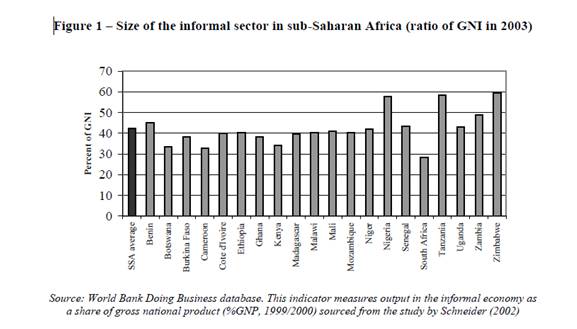
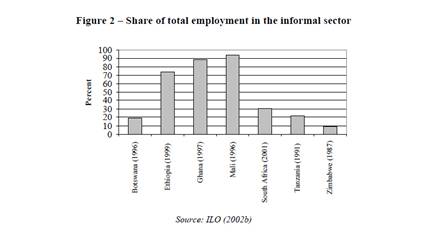
Turning to the labour market, based on figures reported in ILO (2002a) the informal sector in SSA is estimated to represent around three-quarters of non-agricultural employment. According to ILO (2002c), the sector amounts to 72 percent of employment in sub-Saharan Africa, 78 percent if South Africa is excluded. Statistics reported in Chen (2001) suggest that 93 percent of new jobs created in Africa during the 1990s were in the informal sector, reflecting the impact of globalization, economic reforms and competitive pressures on the labour market in recent years.
ILO (2002b) reports on the share of employment in the informal sector for a number of African countries based on the harmonised and national definitions.1 Figure 2 presents the share of total employment in the informal sector using the national definition for a number of African countries. Though the figures are for different years, it is clear that the share of informal employment varies considerably within Africa, ranging from 8.8 percent in Zimbabwe to 94.1 percent in Mali.

Question 1
Define the term 'informal sector'.
Question 2
Identify the type of activities provided by the informal sector?
Question 3
Examine the impact of a strong informal sector impact on the reliability of GDP figures as an indicator of economic development.
Question 4
Analyse the benefits and the costs of African governments encouraging the growth of the informal sector.
Data response (2)
Source: World Press Review (VOL. 50, No. 12) December 2003
The Secrets of Cuban Medicine
Aleksei Aleksandrov, Argumenty i Fakty (mass-circulation weekly), Moscow, Russia, Sept. 17, 2003

In the Havana airport, pale people in wheelchairs and groups of children with a feverish glint in their eyes are barely noticeable among noisy crowds of tourists. There are not too many of them, but there are some on almost every foreign plane landing at the airport of the Cuban capital. These are the people who have come to Cuba seeking medical treatment. It is hard to believe, but even now, as Cubans-living in poverty and cursing the delights of the socialist economy-stand jammed in lines at stores to exchange food stamps for groceries, numerous Cuban clinics and sanitariums are successfully treating thousands of cancer patients every year. In a period of 10 years, 18,000 modest citizens of Russia and Ukraine have undergone treatment in Cuba without having to pay a single kopeck. How did a small tropical republic manage to create the best health-care system in Latin America?
"You are asking where the billions of dollars we receive from foreign tourists go? You think the money is spent on new uniforms and false beards for Fidel?" laughs a government official in Havana. "Take a tour of our hospitals, clinics, and rehabilitation facilities-you will find the answer to your question there. Exactly half of all the currency earned in our country goes toward the health-care system, and it is our policy to spare no expense for that purpose. Maybe there is no gasoline in Cuba to fill the car up before heading off to work in the morning, and they don't have meat for lunch everywhere, but at least the people are healthy."
The successes of Cuba in the area of health care are, in fact, amazing, especially if you take into account that the country was on the verge of economic collapse after the Soviet Union ended its generous financial aid program. Physicians from leading clinics in the United States come here in secret (officially it is forbidden for U.S. citizens to visit Cuba) to acquaint themselves with Cuban experience and practices, say officials at the Russian Embassy in Havana. They illegally buy medications, such as the famous Cuban vaccine for meningitis, which is produced nowhere else in the world. Then there are the Cuban physicians who have developed a drug to treat hepatitis B. Regarding treatment for cancerous tumors, the Cubans are well ahead of many of the world's developed countries.

Question 1
Identify the indicators of development the article identifies as priorities for the Cuban government.
Question 2
Examine the evidence in the article that suggests the inhabitants of Cuba experience low livings standards.
Question 3
Analyse the advantages and disadvantages to the Cuban economy as a result of allocating resources to the health sector.
Data response (3)
Source: the Namibia pages of the CIA World Fact Book
Labor force - by occupation:
agriculture: 16.3%
industry: 22.4%
services: 61.3%
note: statistics are for the formal sector only; about half of Namibia's people are unemployed while about two-thirds live in rural areas; roughly two-thirds of rural dwellers rely on subsistence agriculture (2008 est.)
Unemployment rate:
51.2% (2008 est.)
country comparison to the world: 193
36.7% (2004 est.)
Population below poverty line:
55.8%
note: the UNDP's 2005 Human Development Report indicated that 34.9% of the population live on $1 per day and 55.8% live on $2 per day (2005 est.)

Read the article Economic Recovery Not Up to Speed and then answer the questions below.

Question 1
According to the article economic growth in Namibia in Southern Africa is slowing down. Describe how economic growth measured.
Question 2
Although the Central Bank of Namibia may adjust its growth forecast downwards the rate of economic growth in Namibia may still be positive. To what extent does this indicate that welfare of it population is improving?
Question 3
Namibia is heavily dependent on the production and export of primary products. Analyse the possible effects of a slowing of growth in the primary industry and agricultural sectors of the economy.
Question 4
Evaluate alternative measures of development that the government of Namibia could target to measure improvements in the welfare of its citizens.
Long Question (1)

Question 1
Using examples to illustrate your answer, explain the problems of measuring GDP in developing countries.
Question 2
Analyse the advantages and disadvantages of using the HDI and GDP per capita as indicators of development.
Long Question (2)

It is argued that economic development is a more complex concept than economic growth. Discuss the extent to which economic development can be satisfactorily measured.
4.3 The role of domestic factors in economic development (notes)
In the previous sections, we looked at the nature of economic growth and economic development and examined methods of measuring development. In this section we consider the role of domestic factors in economic development.
By the end of this section you should be able to:

- With reference to a specific developing economy, and using appropriate diagrams where relevant, examine how the following factors contribute to economic development.
- Education and health
- The use of appropriate technology
- Access to credit and micro-credit
- The empowerment of women
- Income distribution
Domestic factors - introduction
Domestic factors and economic development
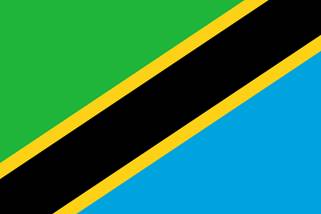 Section 4.3 will take a slightly different approach to the other sections, in that it will focus on a number of domestic factors that relate to economic development in one particular country. The section will focus on the East African country of Tanzania and use it to highlight a number of important issues that have a significant impact on the economic development of that country. Exploring the domestic factors of one country will emphasize their interconnectedness and how this impacts on the lives of Tanzanians. However many of the questions posed and the issues raised throughout the section will also apply to other developing countries. Indeed, the questions at the end of the section will ask you to apply some of the ideas you have come across in Tanzania to understand economic problems in other developing countries.
Section 4.3 will take a slightly different approach to the other sections, in that it will focus on a number of domestic factors that relate to economic development in one particular country. The section will focus on the East African country of Tanzania and use it to highlight a number of important issues that have a significant impact on the economic development of that country. Exploring the domestic factors of one country will emphasize their interconnectedness and how this impacts on the lives of Tanzanians. However many of the questions posed and the issues raised throughout the section will also apply to other developing countries. Indeed, the questions at the end of the section will ask you to apply some of the ideas you have come across in Tanzania to understand economic problems in other developing countries.
In this section we consider the following sub-topics in detail
- Education and health
- The use of appropriate technology
- Access to credit and micro credit
- The empowerment of women
- Income distribution
An introduction to Tanzania
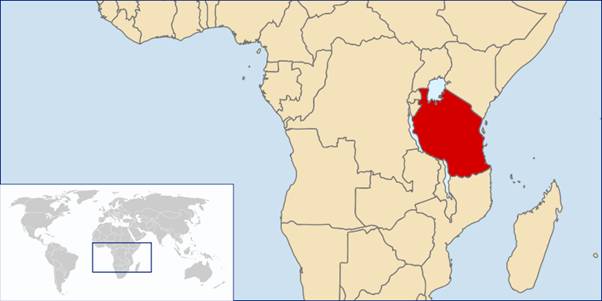
Map of Tanzania
We suggest you first gain some background info about the country by looking at the following links.
You might want to look at the following video to get a sense of the country. In addition to giving some idea of what parts of Tanzania look like, it offers some background on the role that education plays in influencing the level of development within the country.


Having watched the video we suggest that you review the following websites to gain further background information.
Education
We saw in Section 4.1 that both the quality and quantity of the factors of production are influential in determining the level of economic growth and development. The quality of labour will depend on the educational and healthcare provision in the countries. Many economists believe that the quality of labour inputs is the single most important barrier to economic growth. Virtually every other ingredient in production - capital goods, raw materials and technology - can be bought or borrowed from advanced countries. But the application of high-productivity techniques of production to local conditions almost always requires management, production workers and engineering know-how found only in an educated, literate and skilled workforce.
Improving the skills of the work force is seen as being a key factor in promoting economic growth and development. Improving education, reducing illiteracy and training workers in the skills needed for production and enterprise will allow workers to make better use of capital, adapt to new technologies more easily and become more productive.
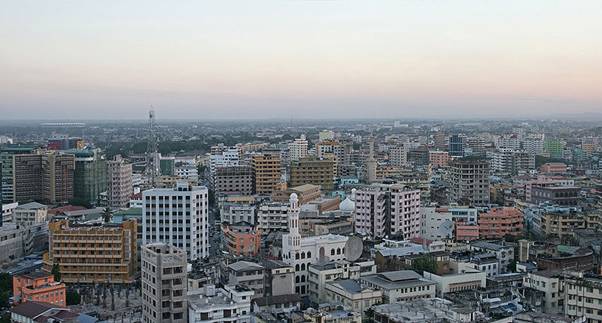
Dar Es Salaam
Millennium Development Goals
One of the UN's Millennium Development Goals for 2015 focus on education
GOAL 2 Universal Education
Achieve Universal Primary Education
Target
Ensure that, by 2015, children everywhere, boys and girls alike, will be able to complete a full course of primary schooling
Key questions for Tanzania
- Will Goal 2 on universal education be achieved by 2015?
- Is universal primary education sufficient for its economic growth and development?
- Is completing a course in primary education the best indicator of its effectiveness and impact?
Primary, secondary or tertiary education?
 Many LDCs have made enormous efforts to provide universal primary education. As more and more capital is used, labour has to be better trained in the skills to use the capital, such as servicing tractors and water pumps, running hotels and installing electricity. Countries, such as Tanzania, have successfully increased the numbers of people enrolling into primary schools. However it is difficult to determine the impact of this educational provision as it is the quality of the education that is important in term of improving the life chances of the young people who attend the schools.
Many LDCs have made enormous efforts to provide universal primary education. As more and more capital is used, labour has to be better trained in the skills to use the capital, such as servicing tractors and water pumps, running hotels and installing electricity. Countries, such as Tanzania, have successfully increased the numbers of people enrolling into primary schools. However it is difficult to determine the impact of this educational provision as it is the quality of the education that is important in term of improving the life chances of the young people who attend the schools.
It should always be remembered that education spending involves an opportunity cost in terms of current consumption and thus it is often referred to as investment spending on human capital.
You discovered in Section 4.2 that one of the Millennium Development Goals, Goal 2, advocates universal primary education and aims to "ensure that, by 2015, children everywhere, boys and girls alike, will be able to complete a full course of primary schooling".
Organisations, such as the World Bank, have tended to encourage less developed countries to invest resources into the development of the primary and secondary educational sectors, but less so in the tertiary sector. Economists are now challenging the wisdom of this philosophy. They argue that in a world increasingly reliant on new technologies, developing skills and competencies to utilise these technologies effectively is as important in developing economies as in developed economies. A higher level of education leads to higher levels of income and savings and consequently, growth and development. Thus one question that has emerged for less developed countries relates to the targeting of educational expenditure. Given the scarcity of resources and the significant opportunity costs incurred the question many are asking is it better to direct the resources into primary, secondary or tertiary education?
Kofi Annan, the former Secretary General of the United Nation went on record as saying

The university must become a primary tool for Africa's development in the new
century. Universities can help develop African expertise; they can enhance the analysis of African problems; strengthen domestic institutions; serve as a model environment for the practice of good governance, conflict resolution and respect for human rights, and enable African academics to play an active part in the global community of scholars.
A successful higher education sector also has the effect of reducing the 'brain drain', where the more educated members of society attend universities abroad and often end up remaining overseas and contributing to the growth and development of other countries
Advanced learning in science, engineering, medicine and management allows countries to benefit by sending their best minds abroad to bring back the newest advances in their fields of expertise.
A dependent population
We saw in Section 4.1 that that the size and growth of the population and the labour force would have an impact on a country's economic growth and development. Age is also an important consideration when looking at the population and its structure and it affects the dependency ratio - the proportion of those of working age to those who are dependent on them. The dependent population will include those of school age and those over the age of retirement. The dependent population will, by definition, need to be supported by those who are actively working, but in the longer term, economic development will be crucially determined by the quality of education and training received by the younger element of the dependent population. In many developing countries, children do not receive an appropriate education on account of the following:
- Inadequate education systems
- The need to keep children away from school to work on the land
- A lack of adequate jobs for those who have received a more formal education, which may lead to crime and increasing drug abuse, and an unwillingness to attend school in the first place.

Dependency ratio
The dependency ratio is an age-population ratio of those typically not in the labour force (the dependent part) and those typically in the labour force (the productive part). It is used to measure the pressure on productive population.
In published international statistics, the dependent part usually includes those under the age of 15, and over the age of 64. The productive part makes up the population in between, ages 15 - 64.
Source: Wikipedia
The dependency ratio is normally expressed as a decimal or a percentage:
![]()

How do the dependency ratios of less developed countries compare with those of the developed world?
Dependency ratio - selected countries
There is also a static version of this chart available.
You will see that the dependency ratio of Tanzania and similar less developed countries such as Malawi are very high in comparison to developed countries such as the UK indicating that their economies have got to support a significant dependent population in terms of health care and educational provision.
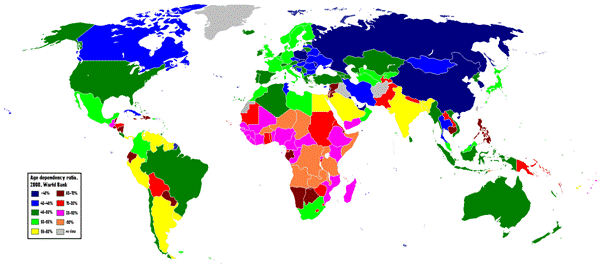
Age Dependency Ratio by country, 2008. World Bank data

Further details on the trends in the age dependency ratio in Tanzania can be found on the trading economics site. You can read these in the web window below, or follow the previous link to open the article in a new web window.
Tanzanian database
We saw that in Section 4.2 that there are both single and composite indicators that are used to gauge the level of economic development. In this section, we will highlight the economic problems that Tanzania faces by using various development indicators. By way of comparison, we will also look at the equivalent indicators for other developed and less developed. At this stage, you may want to have a look through the following data sources to review other development indicators and to build up a picture of the economy of Tanzania.

Two excellent sources of data relating to development in Tanzania are provided by UNICEF and the World Bank. The following websites will give you access to a wide range of health and education indicators and other relevant information.

Pause for thought
- In all cases when using indicators of development take time to reflect upon the appropriateness of the indicators and whether other measures would be better.
- Would it be a good idea to build a broader picture by using a range of indicators? Would a composite indicator be better than a single indicator?
- Are there fundamental weaknesses in using certain statistical measures to make judgments?
- Where does the data come from and how accurate and current do you think it is?
Exploring education in Tanzania - data
So what is school and school life like in Tanzania, and what role does education play in transforming the lives of young people?
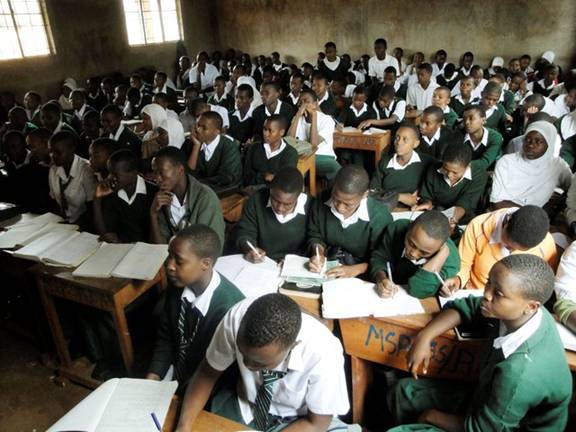

What the data shows
Let's first take a look at some key educational indicators in Tanzania and other countries. This may give us some clues about the factors that lead to, and/or potentially slow, economic development in the country.
Illiteracy rates (% - selected countries)
There is also a static version of this chart available.
Primary enrollment rates (% - selected countries)
There is also a static version of this chart available.
Exploring education in Tanzania - Maua and Namyani (video)
Watch the two video clips that illustrate the life of Two Tanzanians, Maua and Namayani.

Exploring education in Tanzania - lost dreams
Exploring education in Tanzania - reflection

Having looked at the data, watched the video clips and read the article, reflect upon the following questions:

- How are the schools you see in the videos similar, or different, to your own?
- How does improving the quality of education contribute to the breaking of the poverty cycle?
- What evidence is there that the educational provision for boys and girls is a) different and b) insufficient?
- Why is the education of girls considered important as far as reducing poverty and stimulating development is concerned?
- One important question for Tanzania is whether government spending on education should focus on primary, secondary or tertiary education. Can you come up with arguments for each?
Exploring health in Tanzania - data
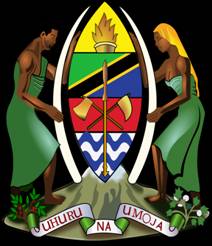 As with education the quantity and quality of health care provision clearly has a direct impact on the extent to which a country's labour force is productive and capable of providing the essentials for economic development and growth. Education and health are of course interconnected. Those people who are educated are more able to utilise health care and refrain from those activities that are likely to cause poor health, such as HIV and Aids. You will remember that in the vicious cycle of poverty covered in Section 4.1, we saw how low incomes meant that people had few financial resources to spend on education and health thus continuing the cycle of low levels of productivity and income.
As with education the quantity and quality of health care provision clearly has a direct impact on the extent to which a country's labour force is productive and capable of providing the essentials for economic development and growth. Education and health are of course interconnected. Those people who are educated are more able to utilise health care and refrain from those activities that are likely to cause poor health, such as HIV and Aids. You will remember that in the vicious cycle of poverty covered in Section 4.1, we saw how low incomes meant that people had few financial resources to spend on education and health thus continuing the cycle of low levels of productivity and income.
Many people in less developed countries fight an on-going battle against disease, ill health and malnutrition. Tanzania is no exception.
Controlling disease and improving health facilities will improve life styles, make people happier and increase productivity. So, the provision of a sewerage system or a health centre is not a luxury, but a necessity. What is being provided is an essential part of the country's' social capital.
Millennium Development Goals
Three of the UN's Millennium Development Goals for 2015 focus on health related issues
Goal 4 Child Health
Reduce by two thirds, between 1990 and 2015, the under-five mortality rate
Goal 5 Maternal Health
Reduce by three quarters the maternal mortality ratio
Achieve universal access to reproductive health
Goal 6 Combat HIV, Malaria and other diseases
- Have halted by 2015 and begun to reverse the spread of HIV/AIDS
- Achieve, by 2010, universal access to treatment for HIV/AIDS for all those who need it
- Have halted by 2015 and begun to reverse the incidence of malaria and other major diseases

What the data shows
Let's first take a look at some key health indicators in Tanzania and other countries. This may give us some clues about the factors that lead to and slow down economic development in the country.
| Tanzania | Bangladesh | India | Indonesia | Malawi | Peru | UK | |
|---|---|---|---|---|---|---|---|
| Physicians (per 1,000 people) | .. | .. | .. | 0 | .. | .. | 2 |
| Nurses and midwives (per 1,000 people) | .. | .. | .. | .. | .. | .. | . |
| Improved sanitation facilities (% of population with access) | 24 | 46 | 25 | 44 | 50 | 62 | 100 |
| Improved sanitation facilities, rural (% of rural population with access) | 22 | 43 | 14 | 30 | 50 | 27 | 100 |
| Improved sanitation facilities, urban (% of urban population with access) | 29 | 57 | 52 | 63 | 51 | 77 | 100 |
| Improved water source (% of population with access) | 54 | 79 | 81 | 77 | 63 | 79 | 100 |
| Life expectancy at birth, female (years) | 52 | 62 | 62 | 69 | 53 | 73 | 80 |
| Life expectancy at birth, total (years) | 51 | 61 | 61 | 67 | 51 | 71 | 78 |
| Life expectancy at birth, male (years) | 50 | 60 | 60 | 66 | 49 | 68 | 75 |
| Malnutrition prevalence, weight for age (% of children under 5) | .. | 48 | .. | 25 | 22 | 5 | .. |
| Depth of hunger (kilocalories per person per day) | .. | .. | .. | .. | .. | .. | .. |
| Fertility rate, total (births per woman) | 6 | 3 | 3 | 2 | 6 | 3 | 2 |
| Contraceptive prevalence (% of women ages 15-49) | .. | 54 | 47 | .. | 31 | 69 | .. |
| Children (0-14) living with HIV | 140,000 | .. | .. | .. | 94,000 | .. | .. |
| Prevalence of HIV, female (% ages 15-24) | .. | .. | .. | .. | .. | .. | .. |
| Prevalence of HIV, male (% ages 15-24) | .. | .. | .. | .. | .. | .. | .. |
| Prevalence of HIV, total (% of population ages 15-49) | 7 | 0 | 0 | 0 | 14 | 1 | 0 |
Exploring health in Tanzania - videos
In developed countries we often tend to take health care for granted. Watch the following two video clips that consider a number of health related issues.

The first video looks at Kilema hospital near Arusha in Tanzania:
The second video consider the problems of Malaria in Tanzania
Exploring health in Tanzania - living with HIV

Read the article Living with HIV in Tanzania. You can do this in the web window below, or follow the previous link to open the article in a new web window.
Exploring health in Tanzania - reflection

Having reviewed the data, video clips and article reflect upon the following questions.

- How do the hospitals in Tanzania compare with hospitals in your country? What similarities and differences do you notice?
- What evidence does the data reveal about health provision in Tanzania compared with other countries?
- How do the conclusions you have drawn in question 2 impact on the poverty cycle?
- What are the health provision implications for a country like Tanzania with a high dependency ratio?
- What do you think will be the impact on the economy of Tanzania of having a high HIV infection rate?
Use of appropriate technology
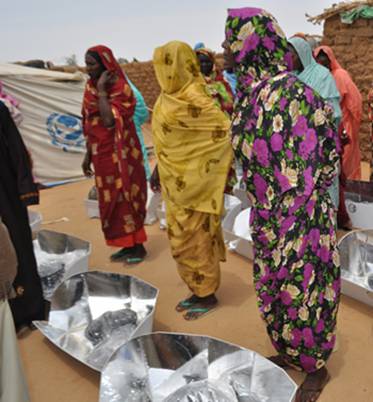 Improving the quality and quantity of capital resources available to the labour force will improve its productivity and lead to economic growth and development. One of the big question facing many less developed countries relates to the types of capital that are going to have the largest impact on the productivity of the labour force. We have seen in early sections that low levels of education will limit the extent to which labour can utilise capital to raise productivity. Investment in capital is expensive and the costs of maintaining and servicing equally so. It is argued by some development economists that given the large labour force, and high rates of unemployment, that using capital intensive production methods, is not the most cost efficient solution to low economic growth and indeed can worsen the levels of poverty.
Improving the quality and quantity of capital resources available to the labour force will improve its productivity and lead to economic growth and development. One of the big question facing many less developed countries relates to the types of capital that are going to have the largest impact on the productivity of the labour force. We have seen in early sections that low levels of education will limit the extent to which labour can utilise capital to raise productivity. Investment in capital is expensive and the costs of maintaining and servicing equally so. It is argued by some development economists that given the large labour force, and high rates of unemployment, that using capital intensive production methods, is not the most cost efficient solution to low economic growth and indeed can worsen the levels of poverty.
In the abstract to his article Choice of technology in small and large firms: Grain milling in Tanzania M. S. D. Bagachwa* from the University of Dar es Salaam, Tanzania observed that:

It is not uncommon to find many production units (firms) in low-income, labor-abundant and capital scarce economies, such as Tanzania, employing sophisticated and capital-intensive production techniques. In such circumstances, a technology choice problem exists in the sense that the technologies in use and more often the products being produced are not compatible with the resource endowment of the economy and the income levels of the majority of the population.
Some economists would argue that using labour intensive production incorporating more appropriate technologies is a better option for countries such as Tanzania.
What then are appropriate technologies?
In 1983, the OECD defined the term 'appropriate technology' as being characterized by:

"Low investment cost per work-place, low capital investment per unit of output, organizational simplicity, high adaptability to a particular social or cultural environment, sparing use of natural resources, low cost of final product or high potential for employment."

A useful background to appropriate technology can be found in Wikipedia. You can do this in the web window below, or follow the previous link to open the article in a new web window.
Technology - sawdust stoves and clean water (videos)
In developed industrialised countries, we tend to associate efficient production with advanced technology and highly capital intensive solutions. We have seen, that for a number of reasons, this may be inappropriate in the context of Tanzania.

Watch the following two video clips that illustrate the use of appropriate technologies.
The first video highlights a case where appropriate technology, in the form of sawdust stoves, is being produced in Tanzania in response to fuel shortages.
The second video is produced by WaterAid considers the problem of accessing clean water near Dodoma, the capital of Tanzania and highlights a community project that has made use of appropriate technology
Technology - building good roads

Read the article Villagers learn how to build good roads. You can do this in the web window below, or follow the previous link to open the article in a new web window.
Use of appropriate technology - reflection

Having watched the videos and read the article reflect answer the following questions:

- Define the term 'appropriate technology'.
- Using the the two video clips, explain why the technologies being used would be considered 'appropriate'.
- Analyse the economic arguments for and against using appropriate technologies in Tanzania.
Access to credit and micro credit
 To break the poverty cycle, those in poverty must find ways of generating income to allow them to save. Traditionally, borrowing from banks to kick-start small businesses has not been possible, because commercial banks have been reluctant to lend to the poor who are seen as 'high risk'. However, new institutions and technologies are creating innovative solutions to allow the poor to obtain credit
To break the poverty cycle, those in poverty must find ways of generating income to allow them to save. Traditionally, borrowing from banks to kick-start small businesses has not been possible, because commercial banks have been reluctant to lend to the poor who are seen as 'high risk'. However, new institutions and technologies are creating innovative solutions to allow the poor to obtain credit
Microcredit schemes are schemes that lend small amounts to the poor in a developing country. The loans may be as low as $1, but they are directly targeted at the needs of those people and reflect the circumstances in which they operate. These loans are often offered by Non-Governmental Organisations (NGO's) as the commercial financial institutions are not prepared to work in this way. They generally regard the poor as high risk, as they cannot offer any security for the loans.
Many economists argue that these loans are an excellent way to promote growth and development, as they are directly targeted at the people who need them the most, and help to promote an entrepreneurial culture from the 'bottom-up'. However, whether they are sufficient to boost an economy significantly is very debatable and they are likely to be most effective when combined with other development strategies.
With the advent of mobile phone technology, mobile phone banking has become increasingly important. Whereas in many less developed countries the inhabitants do not have bank accounts they do have a mobile phone. New businesses are starting to realise the potential for using such technologies to access and transfer money which offers a powerful driver for commerce and economic and social development.
Breaking the vicious cycle of poverty is clearly a major development goal. One way to do this is to provide opportunities for those that are economically inactive to become income earners and savers.
Microcredit in the community (videos)

Watch the following two video clips focus on micro credit systems.
The first video highlights a microcredit scheme introduced by a church based non-governmental organization in Iringa in Tanzania and explores the benefits to the local community.
The second video looks at a scheme called M-PESA, that has transformed commerce in poorer communities in Tanzania's neighbour Kenya and increasingly in Tanzania itself by using mobile telephones as a way of accessing and transferring money and credit.
Microcredit in the news

Read the article Oikocredit extends 700m/- loan to SACCOS. You can do this in the web window below, or follow the previous link to open the article in a new web window.
Microcredit - reflection
Reflection about accessing credit and microcredit

Having watched the videos and read the article answer the following questions.

- Describe how the principle of microcredit works.
- Explain why traditional commercial banks are reluctant to extend credit to those who benefit from microcredit schemes.
- Outline how micro credit schemes contribute to poverty reduction and economic development within Tanzania.
- Explain the potential hazards associated with microcredit schemes.
- To what extent would you consider mobile phones to be appropriate technology in Tanzania? Does your analysis change the way you think about appropriate technology?
The origins of microcredit
Professor Mohammad Yunus is a Bangladeshi economist and founder of the Grameen Bank, an institution that provides microcredit to help people in poverty establish creditworthiness and financial self-sufficiency. In 2006 Professor Mohammad Yunus and the Grameen bank were awarded the Nobel Peace prize for "... their efforts to create economic and social development from below".


The Grameen Bank website contains a great deal of information about microcredit and the role of the bank in providing this. You can access this information from the web window below, or follow the previous link to open the website in a new web window.
An excellent source for those wanting to find out more about microcredit is the microfinance gateway.
The FAQs are an excellent place to start
What are the pros and cons of microcredit?
In the current section on microcredit in Tanzania, we have seen that microcredit schemes can have a positive effect on breaking the cycle of poverty for some communities. However, such schemes are not without their critics.

You might want to take a look at the following video that draws upon microcredit experiences from other parts of the world and considers: Does Microfinance really work? The video looks at some of the problems associated with microfinance schemes as well as the benefits.
Empowerment of women
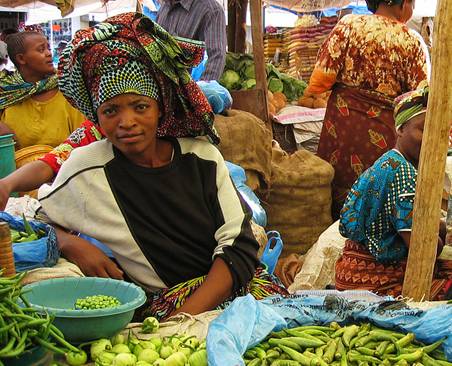 In the section on microcredit, we saw that one way in which women can be empowered is by providing schemes that lend money to them directly to fund start-up enterprises.
In the section on microcredit, we saw that one way in which women can be empowered is by providing schemes that lend money to them directly to fund start-up enterprises.
Earlier in this section we also considered the role of education generally in underpinning development. However, there is evidence that suggests that it is the lack of education for girls that is a particular constraint on economic development. Investment in girls' education does not just benefit the individual concerned, but has a positive impact of the wider society. For example, girls who are educated are less likely to be infected by AIDs or to be exploited by those who engage in human trafficking operations.
We have seen that the lack of education for girls can have a detrimental effect on a country's development. However, the lack of empowerment of women of all ages is also identified as a major constraint on development. Women often bear the disproportionate burdens of poverty, poor education, high unemployment and low social status and mobility and restricted access to birth control.
Characteristics of lack of empowerment include:
- High fertility rates
- High population growth
Many NGO initiatives are targeting their development efforts on activities that empower women by improving their status, providing access to health and education and by encouraging economic self-sufficiency. All of these initiatives lead to lower fertility rates, delayed marriage and lower population growth.
Millennium development goals
Two millennium goals specifically relate to the empowerment of women.
Goal 3: PROMOTE GENDER EQUALITY AND EMPOWER WOMEN
Target 3.A:
Eliminate gender disparity in primary and secondary education, preferably by 2005, and in all levels of education no later than 2015
Goal 5: IMPROVE MATERNAL HEALTH
Target 5.A:
Reduce by three quarters the maternal mortality ratio
Target 5.B:
Achieve universal access to reproductive health
Providing improved access to education and employment opportunities outside the home and enabling a greater degree of economic self-sufficiency allows women more choice of when, and to whom, they marry. The ability to earn personal income ensures greater financial independence from the male members of the family and necessity to be reliant on male members of the family for their financial security.
For many young women without employment and income, the only way to guarantee some form of security is to accept early marriage and child bearing.
Government and the birth rate: economic development implies better health, education, but a fast growing population makes this process more difficult. Some countries have, or have had, policies designed to influence the size of families. China tried this with its one child policy. Some of the problems associated with this form of population manipulation are not attractive.
Whatever the government decides to do, one fact is agreed upon by most, namely, that as an economy develops, so the number of conceptions per female declines. It therefore follows that policies designed to raise the living standards of the poor, e.g. redistributive fiscal policy, are likely to be the most effective way to reduce the rate of population increase - certainly more effective than just handing out contraceptives.

What the data shows
Let's begin our analysis of female empowerment in Tanzania by examining some key indicators which compare Tanzania with other countries .
| Tanzania 2009 | Bangladesh 2005 | India 2006 | Malawi 2009 | Indonesia 2008 | Peru 2008 | UK 2008 | |
|---|---|---|---|---|---|---|---|
| Literacy rate, adult female (% of females ages 15 and above) | 67 | 51 (2009) | 51 | 67 | 89 | 85 (2007) | .. |
| Literacy rate, adult male (% of males ages 15 and above) | 79 | 61 (2009) | 75 | 81 | 95 | 95 (2007) | .. |
| Primary completion rate, female (% of relevant age group) | 102 | 63 | 83 | 60 | 106 | 101 | .. |
| Primary completion rate, male (% of relevant age group) | 102 | 59 | 89 | 58 | 107 | 101 | .. |
| Primary education, pupils (% female) | 50 | 50 | 47 | 50 | 48 | 49 | 49 |
| Progression to secondary school, female (%) | 32 (2008) | 100 | 84 | 74 (2008) | 93 | 93 (2007) | .. |
| Progression to secondary school, male (%) | 40 (2008) | 95 | 86 | 75 (2008) | 91 | 94 (2007) | .. |
| Ratio of female to male secondary enrollment (%) | 78 | 106 | 83 | 88 | 99 | 99 | 102 |
| Ratio of female to male tertiary enrollment (%) | 48 (2005) | 52 | 72 | 51 (2007) | 92 | 106 (2006) | 140 |
| School enrollment, primary, female (% net) | 97 | 90 | 87 | 93 | 94 | 95 | 100 |
| School enrollment, primary, male (% net) | 96 | 85 | 91 | 88 | 97 | 94 | 99 |
| School enrollment, secondary, female (% gross) | 24 | 44 | 50 | 28 | 74 | 89 | 100 |
| School enrollment, secondary, male (% gross) | 31 | 42 | 60 | 31 | 75 | 89 | 98 |
| School enrollment, tertiary, female (% gross) | 1 (2005) | 4 | 10 | 0 (2007) | 20 | 36 (2006) | 67 |
| School enrollment, tertiary, male (% gross) | 2 (2005) | 7 | 14 | 1 (2007) | 22 | 33 (2006) | 48 |
Issues relating to empowerment of women (video)

Watch the following two video clips that consider a number of issues relating to the empowerment of women.

Whilst you are watching consider the following issues:
- What contributes to the empowerment of women?
- How important is education in the empowerment process?
The first video highlights how improving girls education in Tanzania can help empower women within society.
The second video produced by Women Craft looks at how developing practical and entrepreneurial skills, by enabling rural women to sell baskets and table mats, takes them out of poverty and break the vicious cycle of poverty.
Empowerment - in the news
Empowerment - reflection

Having watched the videos and read the article answer the following questions.

- Identify evidence from the data that supports the view that women are disadvantaged and provide three reasons why some women might be disempowered within Tanzania.
- Describe 5 economic and social problems that arise as a consequence of the lack of empowerment of women in Tanzania.
- (a) Identify 3 policies/activities which governments, NGOs and private firms can introduce to empower women
(b) Evaluate the policies/activities described in part (a) and select the policy/activity which you believe will have the greatest impact in terms of breaking the poverty cycle. Give reasons for your choice.
Income distribution
 In section 2, we said that even though a country is experiencing considerable economic growth, standards of living across the population may not rise if the gains from growth are unevenly distributed. The picture on Sao Paulo at the beginning of the pack illustrates this quite starkly, with the super-rich living in close proximity to a favela (shanty town).
In section 2, we said that even though a country is experiencing considerable economic growth, standards of living across the population may not rise if the gains from growth are unevenly distributed. The picture on Sao Paulo at the beginning of the pack illustrates this quite starkly, with the super-rich living in close proximity to a favela (shanty town).
Income distribution describes how the national income of a country is distributed between its citizens. An equal distribution of income would imply that that the national income is spread equally amongst its inhabitants. Although, there is not an example of a country with a completely equal distribution of income, some countries have considerably greater disparity and variation than others.
There are a number of reasons why a country's income may not be evenly distributed:
- The way in which a country's wealth is distributed. If tangible assets, such as land and buildings and intangible assets, such a human ingenuity, abilities and skills are not evenly distributed, then the income that those resources are capable of generating will not be evenly distributed either. Our understanding of the market place tells us that where something is in short supply relative to demand, its value goes up. This applies equally where there are skill shortages, thus guaranteeing higher incomes for skilled labour
- Long established historical and political reasons. Certain groups in society have managed to gain ownership of productive assets, such as agricultural land. In South Africa prior to the ending of apartheid (where the various racial groups were forced by the white ruling party to live in separate areas of the country), the majority black African population were excluded from much of the best agricultural land.
- Social factors such as religion, gender, class, race. It is common in most countries for certain groups to have restricted access to the wealth of a country. In Tanzania, as with many less developed countries, women are very often prevented from accessing the most productive assets of a country.
What policy options exist for Less Developed Countries that want to bring about a more equitable distribution of income?
- Reducing or removing distortions that affect the prices paid to factors of production. For example, it is argued that minimum wage policies which hold wages higher than the equilibrium wage will encourage the substitution of capital for labour; increasing the level of unemployment and reducing incomes. Allowing wages to be determined by the laws of supply and demand may bring down the price of labour in the short run, but will increase the level of employment and ultimately lead to higher wages in the longer term.
- Reducing inequalities in the ownership of assets. Some would argue that the only way to achieve a more equitable distribution of income is to ensure that a country's wealth creating assets are more equitably distributed. In the case of those countries where there is a large rural population, one of the main ways to bring this about is through a programme of land reform, giving land to those who previously worked as tenant farmers. Increasing private ownership of land should increase its productivity and the incomes of exponents. You should of course be remembered that the productivity of land is also dependent upon a range of other factors such as access to fertilizer and seed, education and credit. Unless these are in place, land reform may not lead to the benefits desired. Zimbabwe is a case in point: land reform was 'fast-tracked' with land being taken from experienced white farmers and given to individuals without much farming experience. However, whether or not this policy was a complete failure has been disputed.
- Reducing inequalities by progressively taxing those with higher incomes. Setting higher rates of income and wealth tax on those with higher income levels should allow governments to spend more on poor communities. However, it is often the case that those on very high incomes are able to find ways to reduce the level of their taxable income through creative accounting practices. It will be then left to the middle-income learners to bear much of the tax burden. In addition, high rates of tax may discourage entrepreneurship.
- Increasing transfer payments and subsidies to those on low incomes can also reduce inequalities. Similarly the provision of public goods such as health and education to those with lower incomes can reduce income inequalities.
Lorenz curve and Gini Coefficient
If you would prefer to view this interaction in a new web window, then please follow the link below:
Gini coefficient
If there is a completely equal distribution of income, then G=0 and the Lorenz curve is a diagonal line. The distribution of income becomes more unequal as G increases and gets closer to 1, and this could occur, for example, if more people received nothing, as the lower end of the Lorenz curve would move rightwards along the horizontal axis. As 100% of the population must receive 100% of total income, the top right hand end of the Lorenz curve must touch the top right hand end of the diagonal. However, if the top quintile groups obtain a higher proportion of income, the Lorenz curve will bulge further to the right in its upper regions before it reaches the top right hand corner. In the hypothetical extreme where one person earned all the money and everyone else obtained nothing, the area below the Lorenz curve would disappear and G would be very near to 1. Thus G will lie between 0 and 1, and the greater it is, the more the inequality.
The higher the Gini coefficient, the more unequally income is distributed.
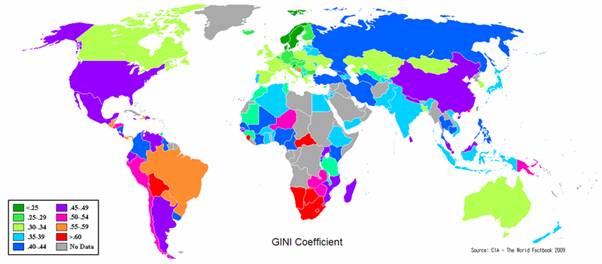
World Gini Coefficients 2009 (CIA World Factbook)
As economies grow and develop, income distribution is likely to widen. As economies grow, they tend to reward the economically strong rather than the weak. The rich get richer while the poor get poorer. In most developed economies, progressive tax systems and social security systems exist to help those at the bottom of the economic pile to varying degrees. However, many developing economies do not have the institutional framework required to achieve this redistribution and as a result, income distribution will often worsen during the process of economic growth.
An unequal distribution of wealth and income can act as a barrier to growth. Those on the lowest income levels often have the highest marginal propensity to consume and if they get an increase in their incomes, they are likely to spend most of this, if not all. This additional demand will help drive economic growth. However, if growth simply means that the rich get richer (and perhaps even move their money overseas) this will act as a constraint on development.
Income distribution - Tanzania

What the data shows
Let's first look at some key indicators that show how Tanzania's income is distributed in comparison with other countries.
| Bangladesh (2005) | India (2005) | Indonesia (2005) | Malawi (2004) | Peru (2005) | Tanzania (2007) | UK (1999) | |
|---|---|---|---|---|---|---|---|
| GINI index | 31 | 37 | 39 | 39 | 52 | 38 | 36 |
| Income share held by fourth 20% | 21 | 20 | 20 | 21 | 20 | 22 | 22 |
| Income share held by highest 10% | 27 | 31 | 32 | 32 | 41 | 30 | 28 |
| Income share held by highest 20% | 41 | 45 | 47 | 46 | 56 | 45 | 44 |
| Income share held by lowest 10% | 4 | 4 | 3 | 3 | 1 | 3 | 2 |
| Income share held by lowest 20% | 9 | 8 | 7 | 7 | 4 | 7 | 6 |
Income distribution - case studies
Examination of the data clearly shows that income is very unevenly distributed within Tanzania. There is a significant proportion of the population that shares a small proportion of the countries income. However there are certainly countries, such as Peru. with an even more uneven distribution of income.

Watch the following two video clips that consider two very different communities in Tanzania and reflect on
The first video follows Economist Jeffrey Sachs visiting Mbola in Central Tanzania to look at some of the causes and consequences of people living in poverty
The second video involves an interview with Modesta Lilian Mahiga, a young Tanzanian woman, who shows a very different face of Tanzania.
Income distribution - reflection

Having watched the videos and read the article answer the following questions:

- Using supporting information from the videos, explain why there are high levels of poverty in rural Tanzania.
- Describe how Modesta Lilian's standard of living differs from those in the village visited by Jeffrey Sachs.
- Examine the role of education as a means of bringing about a more equitable distribution of income within Tanzania.
- Answer the following questions:
- Using the article by FARAJA MGWABATI describe the policy the government is contemplating in an attempt to reduce abject poverty.
- Explain how this policy will impact on the distribution of income within Tanzania.
Building a development database (part 7)

The next stage in building you development database is to visit either, or both, of the following data sites. These sites will provide you with the data you require.
Find the data sets that relate to countries in your database and select the relevant and most recent income distribution data. For the moment, do not use the Gini Coefficient. Once you get the data, you can view it on screen, or download it as an Excel file. We suggest you add it to your spreadsheet.
- Australia
- China
- Romania
- Ecuador
- Italy
- Thailand
- Uganda
- USA
- Produce a rank order list of the countries in terms of their income distribution
- Identify the countries that have the most, and least, equitable distribution of income.
- To establish if there is a relationship between income inequality and economic development, compare the Human Development Index data with the income distribution data you have just found.
- Comment on the relationship between the indicators.
- Are there conclusions that can be drawn from the relationship you have observed?
- Find the most recent Gini coefficient figures for the countries. (If you cannot find the data on this site you may have to search elsewhere).
- Compare the Gini coefficient figures with the HDI data. Do the relationship between the indicators support any relationship you found in question 5?

Pause for thought
To what extent do think that the concept of economic development is culturally specific? Do you think that Tanzanians' view of about what is meant by development may be different from residents in your country? Discuss the concept of economic development with other people in your class. Is there a consensus on what it means?
4.3 The role of domestic factors in economic development (questions)
In this section are a series of questions on the topic - the role of domestic factors in economic development. The questions may include various types of questions. For example:
- Short-answer questions - a series of short-answer questions to help you check your understanding of the topic
- Case studies - questions based around a variety of information
- Long answer - questions requiring an extended/essay type response
- Data response - responding to data or topical economics news articles
Click on the right arrow at the top or bottom of the page to work through the questions.
Short questions

Question 1
Explain what is meant by appropriate technology.
Question 2
Explain why a more equal distribution of income will contribute to economic development.
Question 3
Analyse the advantages and disadvantages of microcredit in the process of economic development.
Question 4
Explain how a Gini coefficient illustrates how income is distributed within a country.
Question 5
To what extent can empowering women address the vicious cycle of poverty?
Data response (1)

Read the article Empowering Maasai Women in Tanzania and then answer the questions below. You can do this in the web window below, or follow the previous link to open the article in a new web window.

Question 1
The article considers how Maasai women in Kenya are becoming more empowered. Explain what is meant by the term empowerment.
Question 2
Explain why the lack of empowerment of women in traditional Maasai communities contributes to the lack of economic development in these communities.
Question 3
Examine the advantages of, and the problems of associated with, the introduction of policies and activities designed to empower women in Maasai communities.
Question 4
Evaluate the policies governments of developing countries can use to promote greater empowerment of women.
Data response (2)

Read the article Banks Making Big Profits From Tiny Loans and then answer the questions below.

Question 1
Explain how a microcredit system works.
Question 2
Examine the benefits of using microcredit systems in developing countries to promote economic development.
Question 3
Examine the problems associated with operating microcredit systems and whether these could contribute to a worsening in the levels of poverty.
Long answer question

Question 1
Explain how income distribution is measured.
Question 2
Using examples from a range of countries, explain what relationship exists between income distribution and economic growth or economic development.
Question 3
Using examples from different regions of the world, examine how domestic factors can impede the level of economic development.
4.4 The role of international trade (notes)
In the previous sections, we looked at the nature of economic growth and economic development, examined methods of measuring development and considered the role of domestic factors in economic development. In this section, we will reflect on the relationship between international trade and economic development.
By the end of this section you should be able to:

- With reference to specific examples, explain how the following factors are barriers to development for economically less developed countries.
- Over-specialization on a narrow range of products
- Price volatility of primary products
- Inability to access international markets
- With reference to specific examples, evaluate each of the following as a means of achieving economic growth and economic development.
- Import substitution
- Export promotion
- Trade liberalization
- The role of the WTO
- Bilateral and regional preferential trade agreements
- Diversification

- With reference to specific examples, explain how the following factor is a barrier to development for economically less developed countries.
- Long-term changes in the terms of trade
Role of international trade - introduction
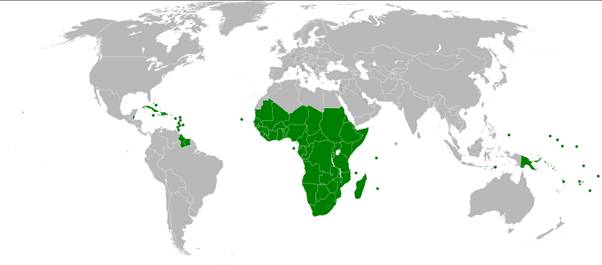
African, Caribbean and Pacific Group of States member nations
In this section we consider the following sub-topics in detail:
- Trade problems facing many economically less developed countries
- Trade strategies for economic growth and development
In section 4.3 we concentrated on looking at some of the domestic factors that can affect the level of economic development of a country and the livings standards of its citizens. Globalization has resulted in people, goods, capital and ideas becoming increasingly internationally mobile. Many of the factors that influence the level of a country's development are international by nature. In 4.3 we focused on the economy of Tanzania. As you read this you may very well be drinking a cup of coffee made from imported Tanzanian coffee beans. The impact of international trade on development cannot be underestimated.
World trade is very uneven and some countries rely more on it than others. The vast majority of trade coming in developed world relates to economic relationships with other developed economies. However, less developed countries trade mainly with developed economies. Trading by less developed countries has been growing faster than that by developed economies, but the individual, country-by-country growth rates have differed considerably. Despite the financial crises of the late 1990s and the first decade of the 2000s, many of the 'Tiger economies' have continued to grow, while in most of Africa lower growth rates have been recorded.
This section considers a number of problems that affect the capacity of less developed countries to make the gains from international trade are enjoyed by more developed countries.
Trade problems (LDCs)
Trade problems facing many economically less developed countries
Overspecialization on a narrow range of products
Developing economies mainly trade in primary exports. The money raised from their sale pays for manufactured imports. Diversification has been a slow process and it has a strong geographic bias. The Far Eastern economies have been able to move up through the categories of exports to command increased market shares of low and medium technology goods. Alas, for many of their poorer African cousins, the reliance on low-valued primary exports has not fallen by a significant amount in the sources of foreign exchange earnings.
In 1970, primary exports constituted 72% of total developing country exports. By 1999, this had fallen to 48% for low-income countries and 32% for middle-income countries. Nevertheless, this proportion still contrasts noticeably with only 18% for advanced economies. The percentage remains exceptionally high for many of the poorest African countries at over 90%.

What the data shows
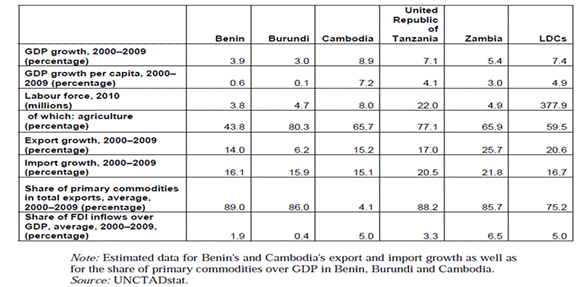
Examine the data above. What conclusions can you draw about the reliance of less developed countries on primary commodities?
Problems - over-dependence on primary products
If you would prefer, you can open the interaction in a new web window by following the link below:
Price volatility of primary products
If you would prefer to view this interaction in a new web window, then please follow the link below:
If you would prefer to view this interaction in a new web window, then please follow the link below:

What the data shows
| Copper | Coffee | Cocoa | Oil | |
|---|---|---|---|---|
| Copper, $/mt, current | Coffee, Arabica, cents/kg, current | Cocoa, cents/kg, current | Crude oil, avg, spot, $/bbl, current | |
| 1960 | 678.7558 | 92.35167 | 58.90167 | 1.63 |
| 1961 | 633.0842 | 89.55417 | 47.85583 | 1.57 |
| 1962 | 645.1433 | 83.25917 | 45.79667 | 1.52 |
| 1963 | 645.9508 | 80.57417 | 55.23417 | 1.5 |
| 1964 | 969.7533 | 100.9758 | 50.57417 | 1.45 |
| 1965 | 1292.844 | 100.035 | 36.53083 | 1.42 |
| 1966 | 1531.513 | 92.8725 | 51.76333 | 1.36 |
| 1967 | 1134.773 | 86.42083 | 59.81167 | 1.33 |
| 1968 | 1241.952 | 86.7 | 72.08833 | 1.32 |
| 1969 | 1467.34 | 87.6725 | 89.77167 | 1.27 |
| 1970 | 1415.7 | 114.6617 | 67.5 | 1.21 |
| 1971 | 1081.417 | 99.1875 | 53.8 | 1.69 |
| 1972 | 1057.675 | 110.9592 | 64.4 | 1.82 |
| 1973 | 1785.358 | 137.345 | 113.1 | 2.8075 |
| 1974 | 2058.5 | 145.1533 | 156.1 | 10.975 |
| 1975 | 1234.75 | 144.2125 | 124.6 | 10.4325 |
| 1976 | 1400.75 | 314.6658 | 204.575 | 11.63 |
| 1977 | 1308.75 | 516.8867 | 379.0067 | 12.565 |
| 1978 | 1364.833 | 358.9992 | 340.3158 | 12.91667 |
| 1979 | 1985.258 | 382.6133 | 329.2833 | 30.96458 |
| 1980 | 2182.092 | 346.6283 | 260.3492 | 36.86875 |
| 1981 | 1741.95 | 286.855 | 207.955 | 35.485 |
| 1982 | 1480.442 | 308.7558 | 173.5617 | 32.64722 |
| 1983 | 1591.925 | 291.1258 | 211.9867 | 29.65778 |
| 1984 | 1377.317 | 318.8658 | 239.5992 | 28.5575 |
| 1985 | 1417.383 | 323.0792 | 225.445 | 27.18333 |
| 1986 | 1373.782 | 429.2583 | 206.9617 | 14.35 |
| 1987 | 1782.503 | 250.4983 | 199.4217 | 18.14583 |
| 1988 | 2601.672 | 303.3708 | 158.46 | 14.71806 |
| 1989 | 2848.41 | 238.7308 | 124.1033 | 17.83889 |
| 1990 | 2661.483 | 197.22 | 126.6667 | 22.87917 |
| 1991 | 2338.783 | 187.3392 | 119.5058 | 19.37083 |
| 1992 | 2281.157 | 141.1917 | 109.9567 | 19.02083 |
| 1993 | 1913.077 | 156.02 | 111.6925 | 16.84167 |
| 1994 | 2307.418 | 330.7642 | 139.5967 | 15.88667 |
| 1995 | 2935.606 | 333.2325 | 143.2425 | 17.18333 |
| 1996 | 2294.857 | 269.4208 | 145.5567 | 20.42 |
| 1997 | 2276.767 | 416.7942 | 161.8733 | 19.17104 |
| 1998 | 1654.058 | 298.1317 | 167.6383 | 13.06444 |
| 1999 | 1572.861 | 229.0583 | 113.5317 | 18.07139 |
| 2000 | 1813.469 | 191.9667 | 90.57917 | 28.22972 |
| 2001 | 1578.288 | 137.3117 | 106.8733 | 24.35183 |
| 2002 | 1559.478 | 135.6608 | 177.7858 | 24.92775 |
| 2003 | 1779.145 | 141.5385 | 175.0877 | 28.8989 |
| 2004 | 2865.885 | 177.3984 | 154.9849 | 37.73339 |
| 2005 | 3678.876 | 253.2171 | 153.812 | 53.39102 |
| 2006 | 6722.135 | 252.2104 | 159.1902 | 64.28826 |
| 2007 | 7118.226 | 272.3698 | 195.2269 | 71.11656 |
| 2008 | 6955.88 | 308.1599 | 257.7116 | 96.99045 |
| 2009 | 5149.739 | 317.1143 | 288.875 | 61.75692 |
| 2010 | 7534.78 | 432.01 | 313.2988 | 79.04077 |
| 2011 | 9475.87 | 632.6995 | 324.9374 | 104.7124 |
Enter the above commodity price data into a spreadsheet and plot the price data for each commodity over time. (Look out for cyclical movements, trends, patterns, relationships). For convenience, you may prefer to download a csv version (suitable for use in any spreadsheet program.

- Describe how price data for each of the commodities shown varies over time.
- Identify and explain relationship between the price data of the four commodities.
Consequences of price volatility
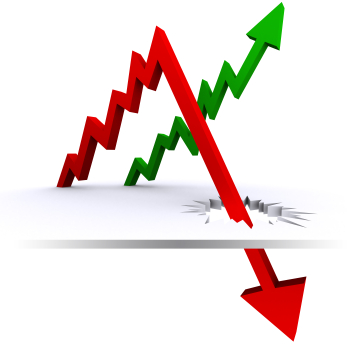 Many developing economies produce mainly primary exports and also tend to specialise in a relatively small range of these products. This leaves them heavily reliant on the world prices of relatively few products, which can be a real barrier to economic development. Most exported commodities are relatively inelastic in supply in the short run and once the crop is planted, there is little else to do but accept whatever the world price is at the time of harvest. With volatile market prices and consequential unreliable flows of earnings, it is difficult to put aside monies for investment in diversification - so the problem of specialisation is compounded. Some economists have advised the creation of sellers' agreements, which would be an effective cartel in all but name. However, problems arise when trying to keep individual countries loyal to such agreements, with difficulties regarding:
Many developing economies produce mainly primary exports and also tend to specialise in a relatively small range of these products. This leaves them heavily reliant on the world prices of relatively few products, which can be a real barrier to economic development. Most exported commodities are relatively inelastic in supply in the short run and once the crop is planted, there is little else to do but accept whatever the world price is at the time of harvest. With volatile market prices and consequential unreliable flows of earnings, it is difficult to put aside monies for investment in diversification - so the problem of specialisation is compounded. Some economists have advised the creation of sellers' agreements, which would be an effective cartel in all but name. However, problems arise when trying to keep individual countries loyal to such agreements, with difficulties regarding:
- Overproduction, which puts pressure on that country to accept whatever price they can get.
- Failure to get all producers to join the 'club'.
- Storage of some commodities may be both difficult and expensive, so fluctuations cannot be evened out.
- 'Floor prices' are too high and encourage overproduction. This then requires precious funds to buy up surpluses and so the investment funds begin to disappear.
The heavy reliance by developing countries on primary exports can lead to considerable changes in revenues, which means that current account balances can vary at alarming speed; import costs can quickly exceed export revenues. This can lead to increased borrowing or a running down of slender foreign exchange holdings. If such deficits persist, the developing countries may have to adopt deflationary policies, leading to higher unemployment and cuts in, what are at best, small-scale public services. The domestic currency will probably suffer a depreciation, which in turn can make imports even more expensive and destroy the chances of achieving a period of sustained economic growth. The impacts of these economic problems normally hit the poorest members of society. If deficits persist, major structural changes may be introduced. Imports are normally essential to growth planning and a failure to acquire the essentials of diversification further hampers the development process.
Price increases can also be problematic!
 Since 2005, the market for primary commodities including oil, metals and agricultural products has experienced a boom resulting in higher prices and consequently, higher national incomes for producing countries. Whilst this clearly benefits some less developed countries by reducing balance of payments and debt problems and providing funds for investment in infrastructure and poverty reduction, such booms can also create problems:
Since 2005, the market for primary commodities including oil, metals and agricultural products has experienced a boom resulting in higher prices and consequently, higher national incomes for producing countries. Whilst this clearly benefits some less developed countries by reducing balance of payments and debt problems and providing funds for investment in infrastructure and poverty reduction, such booms can also create problems:
- Leads to further dependence on the primary products as it removes the incentive to diversify into areas, such as manufacturing, which have higher potential for valued added production in the long-run.
- Puts an upward pressure on a country's exchange rate and disadvantages those non commodity export sectors of the economy that find themselves less competitive on the world market. This phenomenon is sometimes called the 'Dutch effect'.
- Leads to inflationary pressures within the economy reducing the real wages and incomes of many of the poorer member of society adding to the levels of poverty.
- Worsens corruption as those individuals benefiting from the boom in prices find ways of avoiding governments attempts to manage the economic effects of the boom. Indeed some of the corruption may very well involve members of the government who attempt to gain personally from supporting illegal activities.
Price volatility case study - tomatoes


The video clip below highlights the problems experienced by tomato farmers in Ghana from changes in tomato prices

Complete the following exercises while you are watching the video:
- Describe what has happened to the price of tomatoes over recent years.
- Explain the effects of rising tomato prices.
- Describe the impact of the subsequent fall in prices on tomato producers and on peoples' lives.
- Identify the farmers' solutions to the falling tomato prices.
- Using your knowledge of price stabilization schemes from section 1.3 explain how the price of tomatoes can be stabilised.
Price volatility case study - copper


The video clip highlights the problems facing the copper mining industry in Zambia from falling prices of copper and the country's overdependence on copper production.


Reflect upon the following questions whilst you are watching the video. You might want to make some brief outline notes during and after the video.
- Explain the importance of copper to the economy of Zambia.
- Using supply and demand curves, explain why the price of copper has fallen.
- Describe the effect of a fall in the price of copper on copper production.
- Examine how the fall in the price of copper has affected the lives of copper miners.
- Describe how the Zambian government responded to the fall in copper prices.
- Copper wire is used to transmit electricity. Using supply and demand diagrams explain the impact of improved glass fibre technology, and other materials for conducting electricity, on the market for copper.
Trade strategies for growth and development
By way of introducing this section, we suggest you watch the following introductory programme on international trade and trade strategies. The programme reviews the principles underlying trade and explores how these relate to less developed countries.
The following sections explore some of the trade strategies covered in the video.
Import substitution
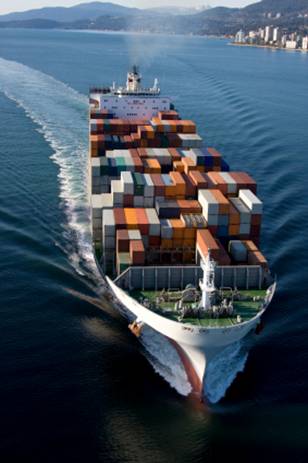 The protection of jobs and the promotion of growth in developing countries might be best served by concentrating on producing import substitutes. Countries need foreign exchange and if they can develop and produce substitutes for imports, this will release foreign exchange. To encourage import substitution, many countries adopt protectionist policies to reduce competition from imports. (See section 3.1 on the arguments for protectionism).
The protection of jobs and the promotion of growth in developing countries might be best served by concentrating on producing import substitutes. Countries need foreign exchange and if they can develop and produce substitutes for imports, this will release foreign exchange. To encourage import substitution, many countries adopt protectionist policies to reduce competition from imports. (See section 3.1 on the arguments for protectionism).
Critics of this suggest that there will be some short-term gains in job protection but, in the longer term, output will be lower than under a free system of exchanging trade. Comparative advantage allows gains from trade via specialisation. However, domestic producers may have little incentive from foreign competitors forcing them to be dynamic. Countries, which have adopted import substitution policies have tended to record lower growth rates than those who have selected the export-led strategy. (See section 3.1 on the arguments against protectionism).
Many developed economies have strict protection policies in place to stop cheaper imports coming in from less developed economies. In general, less developed economies have a comparative advantage in many agricultural markets. Increasingly, they are also gaining similar advantages in a number of low and middle group manufacturing. The developed world has agricultural policies, such as the Common Agricultural Policy (CAP), which protects EU-based farmers and subsidises EU food exports to developing countries. The US has similar protection for its farming community and demands that the World Trade Organisation (WTO) adopt policies that safeguard the US agricultural sector. Textiles from developing countries face a similar battle to access markets in major developed economies to overcome a range of protectionist measures, including health and safety regulations. However, as some Far East economies have proven, the right product at the right price can break into the lucrative markets of North America and Europe, e.g. electronics.
Import substitution case study - sorghum


The video clip below highlights a project that attempts to encourage farmers to produce locally produced sorghum and supply it to the multinational corporation, Diageo in order to make beer rather than rely on imported cereals.


Reflect upon the following questions whilst you are watching the video. You might want to make some brief outline notes during and after the video for revision purposes.
- Explain why Diageo using the locally produced cereal, sorghum, rather than using an imported cereal such as barley in the production of beer.
- Identify the benefit to the country of this import substitution policy.
- Discuss potential hazards associated with such a policy.
Export promotion
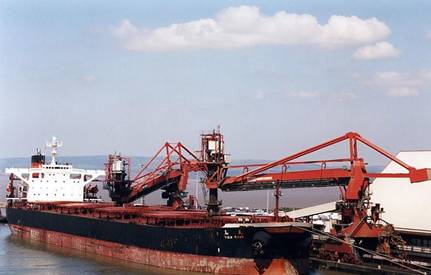 The majority of trade generated by the less developed economies goes to the developed world. Less developed countries seldom trade with other less developed countries. Exporting to the more sophisticated markets of the developed world, forces them to satisfy higher quality and health and safety standards to ensure their goods are internationally competitive. Trade encourages information and technology transfers from more developed to less developed economies, resulting in higher productivity in less developed countries.
The majority of trade generated by the less developed economies goes to the developed world. Less developed countries seldom trade with other less developed countries. Exporting to the more sophisticated markets of the developed world, forces them to satisfy higher quality and health and safety standards to ensure their goods are internationally competitive. Trade encourages information and technology transfers from more developed to less developed economies, resulting in higher productivity in less developed countries.
Being involved in export trade also promotes the ending of domestic protectionist policies. Domestic industry are forced to become competitive and not hide behind protectionist barriers. Resources will flow to those industries that have a comparative advantage. These tend to be labour intensive and low technology industries. In the early stage of diversification, government can offer incentives to business to switch away from commodity exports and into manufactured goods.
Export-led demand can be an important source of growth for developing countries in the early stages of their development, particularly given their reliance on primary exports (see earlier in this section). However, countries may also try to export manufactured goods as a growth strategy. This is often termed an outward-oriented strategy. Much of the growth and development associated with the Asian Tiger economies was fuelled by export promotion, which had a number of benefits:
- Comparative advantage - resources are used more efficiently by replacing imports with domestic goods.
- Increased investment - outward-oriented policies may help encourage inward investment and therefore improve domestic productivity.
- Economies of scale - the increased sale of exports may help raise the domestic level of production and enable the country to gain from economies of scale and lower their costs of production.
- Increased employment - increased production should help boost the domestic level of employment.
- Greater equality of income distribution - increased demand for labour will help boost wages in a developing economy and this should help to make income distribution more even.
- Increased competition - an outward-oriented strategy will expose the country to the full weight of international competition. Domestic producers may struggle initially to compete, but productivity will rise much faster than if import substitution policies are followed.
However, the governments of less developed countries may regard these outward-oriented policies as too risky for their own industries and prefer to erect protectionist barriers, especially if opening up markets to foreign competition is deeply unpopular with the population. Countries adopting outward-oriented policies have often face civil unrest as a result.
Export promotion case study - Thai toy industry


The video clip below, produced by the Thai government's Department of Export Promotion, highlights the emphasis being placed on export promotion policy within the Thai Toy Industry. The video is clearly a promotional video however it is interesting to see how the Department is trying to promote Thai exports.

Reflect upon the following questions whilst you are watching the video. You might want to make some brief outline notes during and after the video for revision purposes.
- Who do you think is the intended audience for the video?
- What is the Department emphasizing as being important in the promotion of Thai Toy exports?

Read the article The Import Of Middle Income Status For Ghana and then complete the exercise below. You can do this in the web window below, or follow the previous link to open the article in a new web window.

Produce a 500 word summary of the article, identifying 5 key problems for Ghana and the author's proposed policy solutions for these.
Trade liberalization
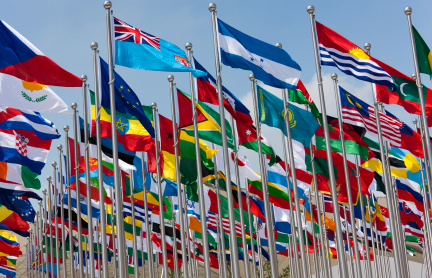 Trade Liberalization is a term used to describe trade strategies that attempt to open up the level of international trade, by the removal of trade restrictions, devaluation of currencies, promoting exports and freeing up controlled prices. Those institutions that support trade liberalization argue that such strategies result in rapid export and economic growth and provide a range of benefits including:
Trade Liberalization is a term used to describe trade strategies that attempt to open up the level of international trade, by the removal of trade restrictions, devaluation of currencies, promoting exports and freeing up controlled prices. Those institutions that support trade liberalization argue that such strategies result in rapid export and economic growth and provide a range of benefits including:
- The promotion of competition - LDCs specialize in the production and export of those goods and services where they hold a comparative advantage.
- Increases in efficiency as domestic exporters are forced to become more competitive.
- Increased profitability and higher incomes, inducing greater savings and investment.
- Encouraging foreign direct investment and inflows of overseas capital and enterprise.
- The freeing up of markets - the removal of subsidies and price controls reduces government costs, opportunities for corruption and growth in black markets.
These benefits appear positive for less developed countries and indeed such strategies have been very successful for a number of developing , that have demonstrated a capacity to compete in a competitive world market. However, there are strong economic arguments against such strategies.
- Slow growth in demand for the traditional exports keeps export prices and export revenues depressed
- Cutting back import restrictions, such as tariffs, results in increases in the volume of goods and services imported from non LDCs countries. As a result, growth may cause a considerable worsening of the balance of payments situation. Additionally, growth may have the effect of reducing export revenues from the exports of goods and services of LDCs to non LDCs, where the high price elasticity is fairly low.
- Export promoting policies, focusing on the traditional primary products where the LDC hold a comparative advantage, will tend to direct resources away from those areas of industrial production that enable LDCs to produce and export goods and services with a higher value added and build up the skills and enterprise within the domestic economy.
The reality is that by looking at the performance of different countries over time the only conclusion we can draw is that some have benefited from adopting trade liberalizing policies, whilst others have not. Indeed, the success of these policies for a particular country may also vary over time. It would appear that the success of the approach will depend upon where the country concerned is in their respective business cycle, the state of the global economy, the structure of productive sectors of the economy and the other macroeconomic policies that are being followed. Clearly what works for the goose, does not necessarily work for the gander!
Section 4.8 examines different development strategies using a number of case studies.
Multilateral agencies such as the World Bank, IMF and World Trade Organization are all advocates of trade liberalization. The next section specifically revisits the World Trade Organization, the role it plays in liberalizing world trade and its impact on global economic growth and development.
The role of the World Trade Organization
In section 3.1, the role of the World Trade Organization was considered in general terms. Now we will consider how the WTOs activities impact on global economic growth and development.
If you would prefer to view this interaction in a new web window, then please follow the link below:
Background information
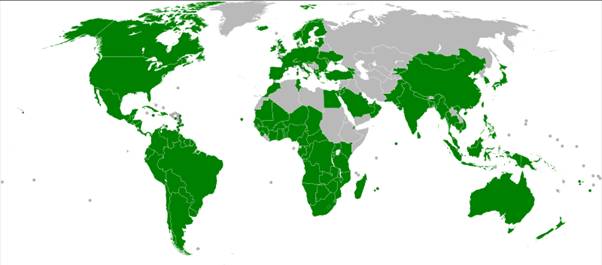
WTO members 2009

The following video gives some background information about the World Trade Organization and its predecessor, the General Agreement on Tariffs and Trade.

You might want to make some summary notes for revision purposes.
The Doha round
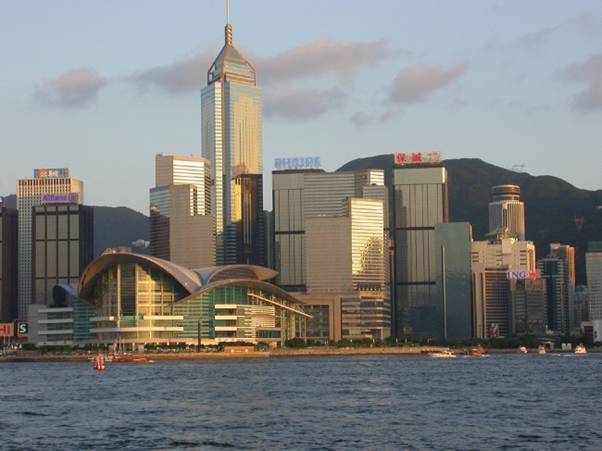
Site of WTO Ministerial Conference of 2005 (Hong Kong Convention and Exhibition Centre)
The WTO trade negotiations are organized in a series of Rounds. These rounds of negotiations were started under the General Agreement on Tariffs and Trade (GATT) and have continued since the establishment of the WTO. The most recent round of negotiation, started in 2001, is called the Doha Development Agenda (or Doha Round) and aims to improve the participation of the lowest income countries in world trade by reducing global trade barriers.
The Doha round has now been going for over 10 years and been be characterized by on-going disagreements between the developed world, particularly USA, European Union and Japan, and the developing countries, represented by Brazil, China, India, South Korea, and South Africa. Most of the disagreements have centred on the reduction of tariff and non-tariff barriers in the agricultural sector. All parties desire improved access into the markets of each other, but also wish to ensure their domestic producers are not harmed by an inflow of cheap imports. Additionally, the negotiations have been around the licensing of medical products, the provision of preferential treatment of developing countries and the problems that LDCs are having dealing with negative trade conditions.
The future of the Doha Round is uncertain, with many global leaders expressing frustration at the time taken to conclude the negotiation and reach agreement.
Case study - trade sanctions

Read the article Brazil slaps trade sanctions on US over cotton dispute and then answer the questions below. You can read the article in the web window below or follow the previous link to open it in a new web window.

- Explain why the US is subsidising its own cotton producers and why this action is considered illegal.
- Describe how Brazil is proposing to retaliate following the decision by the US to subsidise domestic cotton production
- Explain the position that the WTO is taking regarding this trade dispute.
Bilateral and regional preferential trade agreements
Prior to reading this section, you are advised to review Section 3.4 on Economic Integration
The principle of comparative advantages explains the potential gains to trading partners from freeing up trade by removing barriers, such as tariffs and other forms of protectionism. A liberalisation strategy to trade results in countries engaging in different degrees of economic cooperation and integration.

Economic integration
Economic integration refers to trade unification between different states by the partial or full abolishing of customs tariffs on trade taking place within the borders of each state.
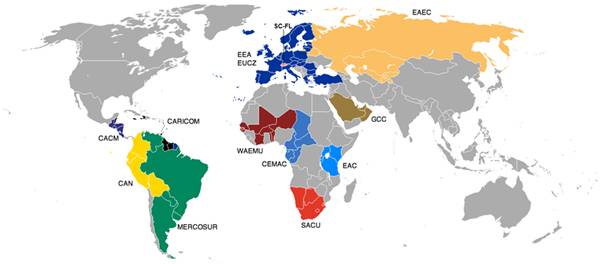
World Customs Unions
Economic integration can take a number of different forms including establishing a preferential trading area, free trade area, monetary union, customs union, common market, economic union, customs and monetary union and economic and monetary union.
This section focuses on how less developed countries attempt to stimulate trade and benefit from economic integration. Many less developed countries have set up preferential trade agreements in an attempt to free up trade between participating members.
Preferential trade agreements can be either bilateral or regional:
- Bilateral trade agreements exist where two countries establish a preferential trade agreement between themselves.
- A regional trade agreement is a multilateral arrangement that exists between a number of countries in a geographical region. Regional trade agreement are sometimes referred to as 'trading blocs'. These provide for preferential access to certain products from participating countries by reducing (although not abolishing) tariffs. The establishments of regional trade agreements are often the first stage of economic integration prior to becoming a free trade area.
Preferential trade agreements have created numerous departures from the most favoured trading nation (MFN) principle of the World Trade Organization, where members are expected to apply the same tariffs to imports from other WTO members.
Case study of a bilateral preferential trade agreement

The following case study examines a bilateral preferential trade agreement between India and its neighbour Nepal. The article highlights the main elements of the agreement and how these will impact on trade relations between the two countries. You can read the article in the web window below or follow the previous link to open it in a new web window.

Nepal is a much poorer country than India and faces more challenging economic circumstances.
- Explain how the preferential trade agreement between the two countries benefits the economy of Nepal.
- Explain how this preferential trade agreement between the two countries benefits the economy of India.
- Assess which country is likely to gain the most from such an agreement.
Case study of a multilateral preferential trade agreement

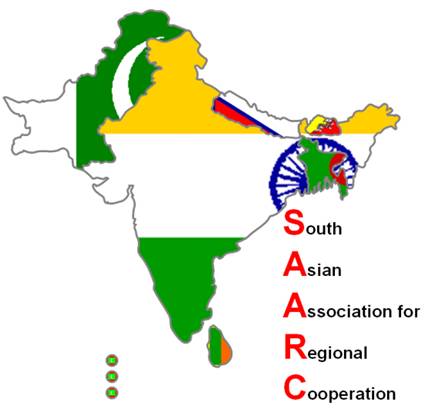 A multilateral preferential agreement has been established between a number of countries in South Asia. India, Pakistan, Nepal, Sri Lanka, Bangladesh, Bhutan and the Maldives. were the original members of the South Asian Association for Regional Cooperation (SAARC). They signed the SAARC Preferential Trading Arrangement (SAPTA) in 1993, with the intention that member states promote and sustain mutual trade and economic cooperation within the region through the exchange of concessions in terms of reductions in trade barriers.
A multilateral preferential agreement has been established between a number of countries in South Asia. India, Pakistan, Nepal, Sri Lanka, Bangladesh, Bhutan and the Maldives. were the original members of the South Asian Association for Regional Cooperation (SAARC). They signed the SAARC Preferential Trading Arrangement (SAPTA) in 1993, with the intention that member states promote and sustain mutual trade and economic cooperation within the region through the exchange of concessions in terms of reductions in trade barriers.
This preferential trade agreement was the a central element of the next stage of integration that took place in January 2004, when the member of SAPTA signed the Agreement on South Asian Free Trade Area (SAFTA), creating a free trade area of 1.6 billion people.
One of the questions that is often asked about such forms of economic integration, is the extent to which such agreements yield the benefits to the member states that they were originally intended. There have been a number of studies looking at the welfare and development gains from such agreements. In the case of SAFTA, the impact is subject to debate and reports have highlighted a number of barriers to the successful operation of the agreement and free trade area. Unresolved political tensions in the region such as the conflict between India and Pakistan, and the lack of inclusion of the most commonly traded goods within the agreement are both thought likely to impede the agreement's progress
There is some thought that whilst India may make gains from such an arrangement the smaller and poorer countries in the region may lose out in terms of trade flows, efficiency, and wellbeing. Several countries are responding by resorting to alternative means of trade liberalization. Establishing bilateral preferential trade agreements, such as that agreed between India and Nepal, may represent a more effective route to economic improvement and faster development. At best, it is argued that gains attributable to SAFTA will be small or non-existent for the region. At worst, SAFTA may result in trade diversion and leave some of the poorer countries worse off.

For those that are interested you can follow the link below and look at the terms of the agreement that established the SAFTA free trade area and examine what it intended to achieve.
Some background reading

The arguments for and against preferential trade agreements are complex. You might want to look at the following document.
The Director General of the World Trade Organization, Pascal Lamy in an address entitled "Multilateral and bilateral trade agreements: friends or foes?" at Columbia University in 2006, produced a clear account of the various costs and benefits associated with this growing area of trade relations.
Diversification
 We saw in an earlier section that a significant problem faced by many less developed countries is that of overdependence on one, or a few, primary products. This was identified as a high risk strategy on account of a tendency for the prices of primary products to fall over time and be susceptible to large fluctuation in prices: both of which have a negative effect on producers' incomes, savings, tax revenues and country's balance of payments situation.
We saw in an earlier section that a significant problem faced by many less developed countries is that of overdependence on one, or a few, primary products. This was identified as a high risk strategy on account of a tendency for the prices of primary products to fall over time and be susceptible to large fluctuation in prices: both of which have a negative effect on producers' incomes, savings, tax revenues and country's balance of payments situation.
As a consequence, many less developed countries governments want their economies to achieve greater sustainability through diversifying into new areas of production. It is recognised by economists that there is a link between economic diversity and sustainability, and a policy of economic diversification can reduce a nation's economic volatility and increase its growth.
Diversification can be considered on a number of levels:
- Diversification of production - where a country expands the range of goods and services that are produced by firms within the country.
- Diversification of exports - where a country expands the range of goods and services it exports abroad.
- Diversification of markets - where a country looks to sell its goods into different markets.
It is also possible to consider diversification in terms of being:
- Horizontal, where producers within a country expand the range of goods and services they already produce, thus spreading the potential risk.
- Vertical, where producers within a country expand to undertake other areas of production associated with an existing good or service, but closer to the consumer or the primary producer.
By diversifying countries and firms can:
- Reduce the risks associated with:
- reliance on one or a few products
- volatile prices
- downward long term trends in prices,
- resource exhaustion
- changes in consumption pattern.
- Expand production and exports by exploiting opportunities in new and growing sectors of economic activity.
- Expand production and exports in areas where there is greater opportunity for value added and income generation.
Given these clear economic benefits, why do some countries find diversification difficult?
- The discovery and exploitation of high price commodities, e.g. oil in Angola, reduces the pressure to diversify.
- Political unrest and conflict, e.g. in Ivory Coast, impedes diversification
- Lack of growing markets, e.g. Tunisia has been unable to diversify to take advantage of their proximity to a growing European market.
- Lack of a stable and sustained macroeconomic policy discourages diversification. Controlling inflation and exchange rates is essential if stability is to be achieved.
- Existence of a 'Dutch effect', when a buoyant primary sector exerts upward pressure on exchange rates and diverts resources from other sectors of the economy.
- Lack of finance available for public and private sector investment in productive and social infrastructure.
- Restrictive structural adjustment programmes, required by the World Bank and IMF, are thought to impede diversification as countries have to operate tight fiscal policies that discourage spending on infrastructure.
Case study - diversification

Conflict and diversification: the cases of Burundi and Rwanda
 The cases of Burundi and Rwanda offer a clear illustration of conflict undermining economic diversification. These countries have experienced several episodes of civil wars: the most devastating being the 1994 genocide in Rwanda and the war that erupted after the bloody military coup of October 1993 in Burundi. These two countries illustrate the extent to which conflict not only causes an immediate collapse of the production base, but also has severe long-term negative effects on the country's diversification process.
The cases of Burundi and Rwanda offer a clear illustration of conflict undermining economic diversification. These countries have experienced several episodes of civil wars: the most devastating being the 1994 genocide in Rwanda and the war that erupted after the bloody military coup of October 1993 in Burundi. These two countries illustrate the extent to which conflict not only causes an immediate collapse of the production base, but also has severe long-term negative effects on the country's diversification process.
Conflict undermines diversification through various channels. Firstly, conflict destroys economic activity in all sectors, especially trade-oriented activities and those that are heavily dependent on skilled labour and technology, such as manufacturing. In both Burundi and Rwanda, the manufacturing sectors suffered large declines in the conflict years: a staggering 39.7 per cent in Rwanda in 1994 and 18 per cent in Burundi in 1993. The already narrow production base was severely eroded follwoing the conflict.
Secondly, conflict retards the diversification process by destroying public infrastructure. During conflicts, not only existing infrastructure is destroyed (or not maintained), but also the capacity of the government to invest in new infrastructure is severely curtailed.
Thirdly, conflict creates a fiscal crisis by causing government revenue to shrink, and by displacing public expenditure from productive investment (including infrastructure) with military and security expenditure. In Rwanda, government revenue as a share of GDP, declined by 56.8 per cent in 1994. Most of this decline came from trade taxes, which dropped by 72 per cent (as a percentage of total trade). In Burundi, government capital expenditures declined by 9.5 per cent in 1993. The resulting fiscal crises explain the severe shortages in public infrastructure, water, and energy supply that the countries experienced in the post-conflict eras. These shortages constitute a severe constraint to investment in new activities.
Fourthly, by increasing uncertainty, conflict causes investors and lenders to shy away from long-term investment, such as in the industrial sector, and instead focus on short-term and speculative activities, such as commerce. In Burundi, the share of industry in total credit declined from 16 per cent in 1980-94 to 3.8 per cent in 2003-05, while that of commerce increased from 43 per cent to 72 per cent during the same period. At the same time, the share of long-term bank credit declined systematically from 17 per cent of total credit in 1993 to a meagre 2.5 per cent in 2004. The shift of resources away from long-term activities retarded economic diversification, undermined post-conflict economic recovery, and made it harder for the countries to achieve and sustain high rates of economic growth.
Sources: Ndikumana 2004; Bank of Burundi (various reports).
Taken from http://www.oecd.org/dataoecd/53/47/38975872.pdf
Diversification in Malawi - video

The video clip below highlights the economy of Malawi and they way it has diversified into sugar and cotton.


You may want reflect upon the following, while you are watching the video and to make some brief outline notes, during and after the video.
- Explain why Malawi is looking to diversify.
- To what extent do you think diversification in Malawi is an example of horizontal or vertical diversification?
- Identify the driving forces for diversification in Malawi
- Explain the problems Malawi faces in becoming more diversified
- Explain why foreign direct investment (FDI) can be important in promoting diversification.
Some background reading

Oxfam, a UK NGO, has a large library of research papers and resources relating to trade and development. You may like to browse these in the web window below, or follow the previous link to open the page in a new web window.
4.4 The role of international trade (questions)
In this section are a series of questions on the topic - the role of international trade. The questions may include various types of questions. For example:
- Short-answer questions - a series of short-answer questions to help you check your understanding of the topic
- Case studies - questions based around a variety of information
- Long answer - questions requiring an extended/essay type response
- Data response - responding to data or topical economics news articles
Click on the right arrow at the top or bottom of the page to work through the questions.
Short answer questions

Question 1
Identify the economic problems faced by developing countries when their economies are dependent on the export of primary products.
Question 2
Explain the likely impact of the rapid rise in metal prices on the terms of trade of developing countries, which have significant reserves of metals.
Question 3
Explain two reasons why it may be more beneficial for a country to specialise in the production of manufactured goods, rather than primary products.
Question 4
Describe the difference between a regional trade agreement and a bilateral trade agreement.
Question 5
Examine how developing countries, which rely on 'soft commodities' (e.g. sugar), have been affected by the rapid rise in metal prices on world markets.
Data response (1)

Read the article Doha trade round faces risk of collapse after 10 years of talks and then answer the questions below. You can do this in the web window below, or follow the previous link to open the article in a new web window.

Question 1
Describe the role of the World Trade Organization.
Question 2
Using diagrams to aid your explanation, analyse the impact of imposing a tariff on an imported good.
Question 3
Discuss why Brazil, China and India are reluctant to agree to the demands from the US and the EU to reduce the level of protection on their manufactured goods.
Data response (2)

Read the article India free trade agreement likely this year: Sharma and then answer the questions below. You can do this in the web window below, or follow the previous link to open the article in a new web window.

Question 1
Explain what is meant by a free trade area, such as EFTA?
Question 2
Analyse the benefits and costs of establishing a regional free trade area.
Question 3
Drawing upon real world examples, explain why bilateral trade agreements, such as that between EFTA and India, are becoming more popular.
Long answer questions

Question 1
(a) Discuss the advantages and disadvantages for developing countries of signing (i) bilateral trade agreements and (ii) regional trade agreements.
(b) Choose a specific regional trade agreement and assess the impact it has had on the member countries.
Question 2
(a) Explain what is meant by the 'terms of trade' and describe how a country's terms of trade index, is calculated.
(b) Using specific examples, discuss the effect of changes in the world prices of primary commodities on a developing country's terms of trade.
Question 3
Using examples for illustrative purposes, evaluate the arguments for and against import substitution and export promotion, as part of a developing country's trade policy.
4.5 The role of Foreign Direct Investment (FDI) (notes)
In the previous sections, we looked at the nature of economic growth and economic development, examined methods of measuring development and considered the role of domestic factors in economic development. We then reflected on the relationship between international trade and economic development. In this section we examine the role of FDI and describe the nature of MNCs.
By the end of this section you should be able to:

- Describe the nature of foreign direct investment (FDI) and multinational corporations (MNCs).
- Explain the reasons why MNCs expand into economically less developed countries.
- Describe the characteristics of economically less developed countries that attract FDI, including low cost factor inputs, a regulatory framework that favours profit repatriation and favourable tax rules.
- Evaluate the impact of foreign direct investment (FDI) for economically less developed countries.
Role of FDI - introduction
Foreign Direct Investment and Multinational Corporations (MNCs)
Wikipedia describes Foreign Direct Investment (FDI), or foreign investment as:

The net inflows of investment to acquire a lasting management interest (10 percent or more of voting stock) in an enterprise operating in an economy other than that of the investor. It is the sum of equity capital, reinvestment of earnings, other long-term capital, and short-term capital as shown in the balance of payments. It usually involves participation in management, joint-venture, transfer of technology and expertise. There are two types of FDI: inward foreign direct investment and outward foreign direct investment, resulting in a net FDI inflow (positive or negative) and "stock of foreign direct investment", which is the cumulative number for a given period. Direct investment excludes investment through purchase of shares.
Investopedia put it more succinctly as:

An investment abroad, usually where the company being invested in is controlled by the foreign corporation.

What the data shows
To get an idea of the magnitude of FDI visit the following World Bank website and review the data showing the net inflows of foreign direct investment.
Multinational Corporations
Foreign direct investment is mainly undertaken through multinational corporations (MNCs). An MNC is a firm that has productive capacity in a number of countries. The profit and income flows that they generate are part of the foreign capital flows moving between countries.

Multinational Corporation
An MNC is a company which possesses and controls the means of production or services outside the country in which it was established. Although MNCs operate in different countries, most of such corporations are controlled from a national base from which a global system of integrated production, sales, research, marketing and finance is facilitated.
The total value of MNC investment worldwide is over $1 trillion ($1,000,000,000,000), of which around one third is in the developing world. Given low levels of GDP in the developing world, this foreign direct investment (FDI) can mean that the MNCs can hold a disproportionate amount of power over the countries in which they operate.

A rough estimate suggests that the 300 largest MNCs own or control at least one-quarter of the entire world's productive assets, worth about US$5 trillion.
The Economist

Read the article Multinational Corporations & Their Effects on Developing Countries.
As countries adopt more open, outward-oriented approaches to economic growth and development, the role of MNCs or transnational corporations becomes more important. As local markets throughout the world are being deregulated and liberalized, foreign look to locate part of the production process in other countries, where there are cost advantages; these might be cheaper sources of labour, raw materials and components or preferential government regulation. Although developing countries may present high levels of risk, they also present the potential for higher levels of profit. Many developing countries, with growing economies and increasing incomes, may provide future growth markets and they will often offer significant incentives to try to attract the MNCs to locate there.
The benefits of MNCs
If you would prefer to view this interaction in a new web window, then please follow the link below:
The problems of Multinational Enterprises
If you would prefer to view this interaction in a new web window, then please follow the link below:
Growth of importance of MNCs in recent decades
 Increasingly, giant MNCs have come to dominate markets on a world scale, such that they now account for a significant proportion of the world's output. This increase in importance may be attributed to various factors, including:
Increasingly, giant MNCs have come to dominate markets on a world scale, such that they now account for a significant proportion of the world's output. This increase in importance may be attributed to various factors, including:
- The growth of international trade
- The trend towards globalisation
- The desire to achieve profit maximisation through economies of scale and strategies such as transfer pricing
- The growth of powerful economic blocs, e.g. the EU, NAFTA
- Advances in communications and information technology
- The liberalisation of former communist economies
Multinationals and monopoly power
 J K Galbraith on the multinational company
J K Galbraith on the multinational company

The two parts of the economy - the world of the few hundred technically dynamic, massively capitalised and highly organised corporations on the one hand and of the thousands of small and traditional proprietors on the other - are very different. It is not a difference of degree but a difference which invades every aspect of economic organisation and behaviour, including the motivation to effort itself. It will be convenient ... to have a name for the part of the economy which is characterised by the large corporations ... I shall refer to it as the Industrial System. The Industrial System ... is the dominant feature of the New Industrial State.
Source: John Kenneth Galbraith, The New Industrial State (1967).
In a world in which giant corporations control over 70% of the world's trade, carry out the bulk of new research and development (R&D), shape international markets through their advertising and exert a great deal of influence over price, it is difficult to find very much evidence of the perfectly competitive market of the economics textbook. The 19th century revolutionary, Karl Marx, was one of the few economists to correctly predict this growth of big business. While mainstream, orthodox economists mainly focused their attentions on markets with large numbers of buyers and sellers, with none large enough to influence price, Marx centred his attention on the likely growth of huge aggregates of capital having significant control over their markets, and with the ability to eliminate many of their smaller rivals: a process in which the stronger and more profitable 'mop up' the weaker, making for giant monopolies with enormous economic, and even political power.
FDI: good or bad?
Foreign Direct Investment: good or bad for less developed countries?
There are both costs and benefits associated with foreign direct investment and multinational corporations operating in less developed countries. Trying to gain an objective view can sometimes be quite difficult. Articles in the media are inclined to take a pro, or anti, FDI/MNC stance. In some countries, the benefits to the country may outweigh the problems, whilst in others it may be the reverse. Multinational corporations behave in very different ways with regard to their involvement in the economy or society of the host country.

Visit the two following websites and review the arguments from the two opposing perspectives.
The first is the website of Unilever, one of the world's largest companies, which highlights a number of case studies that showcase the positive impact of the mulitinational company on the economic development of a number of countries.
The second links to an article, Multinational Corporations: The New Colonisers in Africa written by Lord Aikins Adusei, who takes an opposing and critical standpoint against the role of foreign direct investment

You may want to surf the web and see if you can find some examples where foreign direct investment and multinational corporation activity has contributed positively to the economic development of the country, and some where it has not been a positive experience. In both cases, be careful to think whether the impact has been on economic growth or development. Remember they are not the same!
Chinese foreign direct investment in Africa (video)

The video clip below highlights the impact of Chinese foreign direct investment in Africa.

Answer the following questions:
- Analyse the pros and cons of the foreign direct investment for:
- China
- The African countries
- Assess, whether FDI is having a positive impact on the respective African economies.
Development - Pause for thought

During the course of working through this pack you have viewed a number of articles and video clips. As you have been watching them, have you been aware whether of any particular stand point or bias? Do you think bias is particularly prevalent in material relating to development economics? If so, why do you think this might be the case?
4.5 The role of foreign direct investment (questions)
In this section are a series of questions on the topic - the role of foreign direct investment. The questions may include various types of questions. For example:
- Short-answer questions - a series of short-answer questions to help you check your understanding of the topic
- Case studies - questions based around a variety of information
- Long answer - questions requiring an extended/essay type response
- Data response - responding to data or topical economics news articles
Click on the right arrow at the top or bottom of the page to work through the questions.
Short answer questions

Question 1
Distinguish between the terms 'foreign direct investment' and 'multinational corporations'.
Question 2
Examine possible reasons for the growth in importance of MNCs over the last half century.
Question 3
Discuss whether MNCs help or hinder the development of developing countries.
Question 4
Analyse the advantages and disadvantages of private capital flows for developing countries.
Question 5
Explain the term 'globalization' and how it relates to foreign direct investment.
Data response (1)

Read the article Beijing strengthens links with Latin America and then answer the questions below. You can do this in the web window below, or follow the previous link to open the article in a new web window.

You might also like to read the article New estimates of China's Foreign Direct Investment in Latin America.

Question 1
Define the term 'foreign direct investment'.
Question 2
Describe the extent of FDI involving China and Latin American Countries.
Question 3
From the article and the table shown above, discuss the benefits to China that result from the Chinese government and Chinese firms investing in Latin America.
Question 4
Evaluate the impact of inflows of FDI on a developing country of your choice.
Data response (2)

Read the article Upwardly mobile Africa: key to development lies in their hands and then answer the questions below. You can do this in the web window below, or follow the previous link to open the article in a new web window.

Question 1
Explain how improving infrastructure, like establishing mobile phone networks, can help to improve the rate of economic growth.
Question 2
Explain how improved mobile phone networks in developing countries in Africa can contribute to reductions in levels of poverty.
Question 3
Discuss the advantages and disadvantages of foreign direct investment for developing countries.
Long questions

Question 1
(a) Explain what is meant by the term 'multinational corporation'.
(b) Using examples, evaluate the impact of multinational corporations on the economic growth and development of developing countries.
Question 2
Discuss whether foreign direct investment is a force for good in developing countries. Use examples from different countries to illustrate your answer.
4.6 The role of foreign aid and multilaterial development assistance (notes)
In the previous sections, we looked at the nature of economic growth and economic development, examined methods of measuring development and considered the role of domestic factors in economic development. We then reflected on the relationship between international trade and economic development and examined the role of FDI and described the nature of MNCs. In this section we consider the role of foreign aid and multilateral development assistance.
By the end of this section you should be able to:

- Explain that aid is extended to economically less developed countries either by governments of donor countries, in which case it is called official development assistance (ODA), or by nongovernmental organizations (NGOs).
- Explain that humanitarian aid consists of food aid, medical aid and emergency relief aid.
- Explain that development aid consists of grants, concessional long-term loans, project aid that includes support for schools and hospitals, and programme aid that includes support for sectors such as the education sector and the financial sector.
- Explain that, for the most part, the priority of NGOs is to provide aid on a small scale to achieve development objectives.
- Explain that aid might also come in the form of tied aid.
- Explain the motivations of economically more developed countries giving aid.
- Compare and contrast the extent, nature and sources of ODA to two economically less developed countries.
- Evaluate the effectiveness of foreign aid in contributing to economic development.
- Compare and contrast the roles of aid and trade in economic development.
- Examine the current roles of the IMF and the World Bank in promoting economic development.
Role of aid and MDA - introduction
In this section, we consider the following sub-topics in detail:
- Foreign aid
- Multilateral development assistance
If you would prefer to view this interaction in a new web window, then please follow the link below:
Foreign aid
Aid may be official, in which case it is administered by government or government agencies. This is called official development assistance (ODA).

ODA is defined by the OECD as
those flows to countries and territories on the (DAC List of ODA Recipients) and to multilateral development institutions which are:
- provided by official agencies, including state and local governments, or by their executive agencies
and
- each transaction of which:
- is administered with the promotion of the economic development and welfare of developing countries as its main objective
- is concessional in character and conveys a grant element of at least 25 per cent
Source: OECD
Aid may also be unofficial, in which case it is administered by a non-government body, such as a charity. These are referred to as non-governmental organisations or NGOs. The aid offered by NGOs is usually on a relatively small scale and designed to achieve specific development objectives.
Grants might be directed at technical services, or scholarships for some students to study in a particular country, and grants do not have to be repaid. Aid might also be trade related, in that the monies will only be made available if the receiving country agrees to buy goods or services from the donor nation. This is called tied aid - the aid is tied to particular contracts, i.e. it has strings attached.
Successful aid should be an attempt to:
- Overcome the low savings ratios recorded in developing economies. Most poor people consume the vast majority of what they earn.
- Help reduce foreign exchange outflows, so allowing the domestic government to use such monies to build the necessary infrastructure for development.
- Reduce the dependency on private investment, which may not arrive or will only be found at a high price to the country seeking such funding.
Successful aid should also:
- Improve the living standards of the poorest people in the receiving country. This is not always possible, as government is normally based in the capital, which is by definition an urban centre. Like all political regimes, those in developing countries tend to serve those who elected them to office and power. Those who did not tend to receive little. If this persists, it can be a cause of unrest and even coups and military takeovers.
- Move with the times and accept that what was fashionable several years ago may no longer be. Local opinion and knowledge is increasingly used when deciding on what to invest in, and why.
- Not simply provide cheap food, except in an emergency, as this undermines the domestic agricultural sector. In some countries, once self-sufficient farming sectors have lost part of their domestic markets to food aid and now have to import part of their staple food crop.
- Allow choice to be exercised by the receiving country. A problem with tied aid is that it reduces choice and the developing economy may not be getting the best deal.
Aid - looking at the data

Visit the OECD statistics website(you can do this in the window below or follow the previous link to look at the page in a separate window).

- Find out about your country and its involvement in official development assistance. Is it an aid donor or receiver?
- How much aid does it give or receive?
- The United Nation recommends that donor countries should give 0.7% of their national income. If your country is a donor country, does it meet the United Nations target? If not, what proportion of the national income does it donate?
- How much above or below the UN target is it?
- Complete the same exercise for two other donor countries, so as to make a comparison.
- Are they above or below the UN level?
- Why does it matter if the majority of donor countries are below the UN target level?
Overseas development assistance
Who receives ODA?
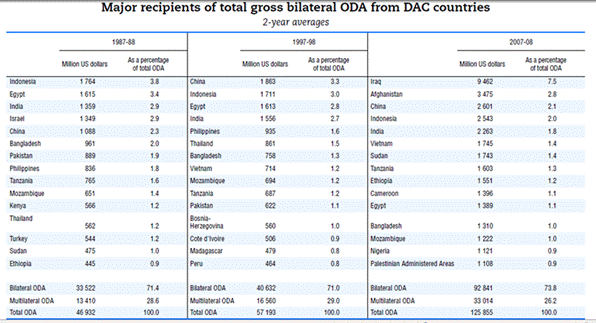
Source: OECD
Who gives ODA?
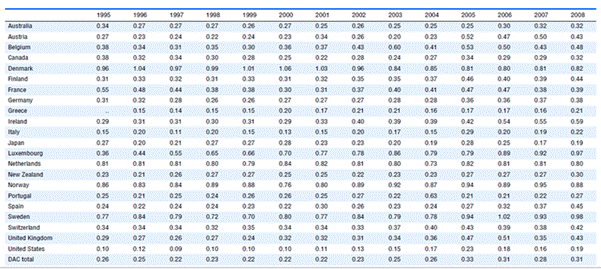
Net official development assistance as a % of gross national income (product)
Source: OECD
Arguments for aid
If you would prefer to view this interaction in a new web window, then please follow the link below:
Arguments against aid
If you would prefer to view this interaction in a new web window, then please follow the link below:
Where do you stand on aid?
It is possible to take various positions on aid, and those on the left and right of the political spectrum might both oppose it, but for different reasons.

Where do you stand?
Have a look at the table below and see if you can identify your position.
| Left | Left / Liberal | Liberal / Right | Right |
|---|---|---|---|
| No! | Yes, but ... | Yes and | No! |
| Aid is a hypocritical neo-colonialist device to make the rich richer | We have a moral duty to help those who, through unfair terms of trade, for example, have been the victim of economic injustice at our hands | It is in our interest to aid the poor - when they are richer they can buy more from us and help expand world trade. | If a country cannot develop without handouts it will not develop with them. What holds less developed countries back is the people who live there. |
| Aid is used to prop up repressive and reactionary regimes | Aid should be directed towards progressive countries | We should aid friendly countries, or ones of strategic defence importance. | Aid centralises money and power into a few government hands. It makes the possession if political office critical and leads to corruption, instability and coups d'etat. |
| Aid is creamed off by corrupt ruling elites in developing countries and therefore increases inequality | Aid projects should help the redistribution of wealth to the desperately poor. Only the adequately nourished and educated can demand structural changes. | Aid should be given to people who can use it effectively to modernise their society and work more efficiently. | Aid depresses individual initiative and reinforces torpor, fatalism and beggary. |
| Loans and grants tied to the purchase of Western goods distort economic development in poor countries - and increase their dependence on the rich. | Aid should be given as grants only and recipients should be free to import from wherever they like. | Sensible aid can benefit both donor and recipient. Tied aid reduces pressure on the donor's balance of payments and allows more to be given. | No 'lame duck' home industries should be subsidised - by tied aid or any other means. And if tax payers in the rich countries were actually consulted about aid they would refuse to give it. |
| Aid goes largely to governments sympathetic to capitalism. It paves the way for private investment that siphons wealth from poor countries. | Aid should be given solely on the basis of need and the potential for social change. Private investment is not aid and can be damaging. | Private investment is an excellent form of assistance. And aid can help it function properly by providing economic and political stability. | If capital is required, and can be profitably used, it will be available commercially. Grants and interest-free loans only encourage inefficiency and waste. |
Official development assistance - case studies

Read the following two articles that highlight a number of issues relating to official development assistance. The first explores the impact of a donor country, the UK, cutting foreign aid to Malawi. The second looks at the effect on the economy of Ghana of USAID increasing the amount of foreign aid into the country.


Having read them, reflect upon the following questions:
- Compare and contrast the nature of foreign aid provided by the UK and US governments for Malawi and Ghana respectively?
- Why has the UK government decided to cut its foreign aid assistance to Malawi?
- How has the government of Malawi responded?
- What is the likely impact of cutting of UK foreign aid on the economic development of Malawi?
- Do you think the US aid to Ghana is primarily targeting growth or development? Explain your answer.
- How might USAID impact on the poverty cycle?
Non-governmental organizations
In recent years, one of the biggest growth industries in developing economies has been that of the NGOs - the non-governmental organisations. They undoubtedly do a very fine job (in most cases), but they can become almost a de facto government and exercise huge influence. They are 'guests' in a country and need to think carefully about the projects they select, and how they employ nationals. Many are essential to the fabric of the country in which they operate.
They work best when:
- Allowed to tackle issues at local level
- Encouraged to employ as many local workers as possible
- Specialised in specific and often rural-based project work
- Project monitoring is done very carefully
- Relations with governments are cordial, but not too friendly

You may like to have a browse around the web sites of some of these NGOs to see the sort of work and projects they are involved in:
- Oxfam
- Save the Children
- Action Aid
- Caritas which includes CAFOD
- Christian Aid

The following websites may be useful to find out more about NGOs:
Multilateral development assistance
Large-scale organizations also work in the field of development by providing development assistance, either though the provision of grants, or through concessional loans i.e. those with less stringent interest rates or repayment times than would be required in the case of commercial loans.
Many of these organizations come under the umbrella of the UN and emerged as part of the discussions held towards the end of the Second World War. Amongst the largest are the:
- International Monetary Fund (IMF) and
- The World Bank
We look at these two organisations in more detail on the next couple of pages.
International Monetary Fund (IMF)
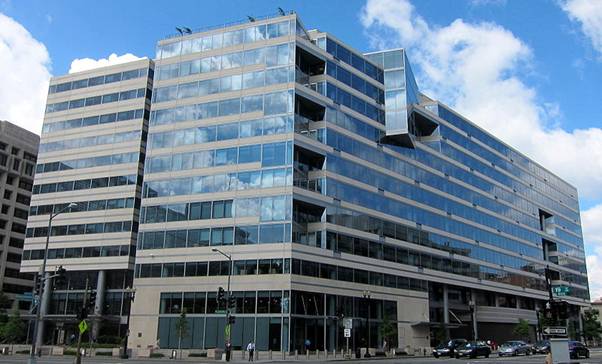
IMF headquarters
The IMF is an international organization of 184 member countries. It was established to: promote international monetary cooperation; exchange rate stability and orderly exchange arrangements; to foster economic growth and high levels of employment; and to provide temporary financial assistance to countries to help ease balance of payments adjustment.
While the IMF was set up to oversee currency values and act as a kind of 'credit union' from which national governments could obtain short term finance to overcome their balance of payments difficulties, it has now developed into an 'international judge' of countries' economic policies - it offers loans conditional on the implementation of a prescribed set of free market policies.
The main purposes of the IMF are given on their web site.

Watch the following video clip produced by the IMF to gain an understanding of how the IMF works:
The following video highlighting the views of Nobel Peace prize winner Joseph Stieglitz takes an opposing and critical view of the IMF and the World Bank and their role in economic development in the less developed countries.

Summarize the arguments that Stieglitz puts forward.
The World Bank
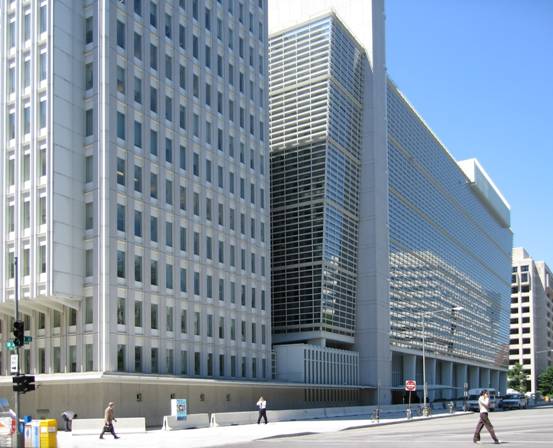
The World Bank building in Washington
The World Bank is not a bank, but rather a specialised agency. The World Bank is not a "bank" in the common sense. It is one of the United Nations' specialised agencies, and is made up of 184 member countries. These countries are jointly responsible for how the institution is financed, and how its money is spent. Along with the rest of the development community, the World Bank centres its efforts on reaching the Millennium Development Goals, agreed to by UN members in 2000 and aimed at sustainable poverty reduction.
Whilst the IMF was concerned with stabilising the international finance system through short term lending to those countries with balance of payments deficits, the World Bank's role was concerned with financing reconstruction and development through the construction of national infrastructure such as roads and dams. By supporting projects through funding, and providing technical assistance, the World Bank considered that it would bring about increases in productivity, output and incomes and self-sustaining economic growth.
The "World Bank" is the name that has come to be used for the International Bank for Reconstruction and Development (IBRD) and the International Development Association (IDA). Together these organizations provide low-interest loans, interest-free credit, and grants to developing countries as follows:
-
The International Bank for Reconstruction and Development (IBRD)
This IBRD lends money at commercial interest rates to governments or private firms, guaranteed by their governments. -
The International Development Association
The IDA lends money, called credits, to the poorest countries on concessionary terms i.e. the repayment periods are longer than the IBRD's loans and the loans are interest free. These are called 'soft loans'.
In addition, the International Finance Corporation (IFC) is closely affiliated to the World Bank. It was started up to enable funds to be lent to, or used to purchase shares in, private firms engaged in activities that would lead to development, but not needing a government guarantee.
Up until the 1970s, much World Bank lending was targeted at projects primarily concerned with building energy and transportation infrastructure in developing economies. Its early history had been concerned with similar projects in reconstructing war torn Europe. The poor economic performance and continued lack of development of many of the countries that had received World Bank assistance resulted in a rethink of the approach of the IBRD and the IDA. The new approach involved identifying specific needs of regions within developing countries, and invariably this meant targeting smaller scale development projects, often of a very diversified nature.
Many of these were concerned with funding agricultural projects, and usually those that stimulated the growth of cash crops. The intention was that such support would raise the incomes of smaller scale farmers and encourage food production. Projects aimed at the tourist industry, education, water supply and health care have also been supported.
Since the 1980s many World Bank loans have, like the IMF, been tied to certain strict conditions laid down in structural adjustment programmes.
A mighty wind of change (video)

Watch the following video A Mighty Wind of Change - Colombia. You can do this in the web window below, or follow the previous link to open the video in a new web window.
It considers the impact of building a wind powered electrical generation plant developed with the support of the World Bank.

- Identify the benefits of a wind farm to the people in the vicinity.
- Assess the benefits of the wind farm to the wider economy of Colombia.
- In addition to providing source of electricity, explain how the project will contribute in other ways to the economic development of Columbia.
Structural Adjustment Programmes

Structural Adjustment Programmes
SAP's are programmes of free market and supply side reforms that multilateral agencies such as the IMF lay down as conditions for lending funds. This is required as conditionality for the loan.
One major area of contention with the two main 'economic' agencies mentioned above (IMF and World Bank) is their application of Structural Adjustment Programmes. These are part of any 'rescue package' a developing country may ask for. Normally, they require the receiver to accept that:
- They cut, or even drop all subsidies and price controls, even on basic foodstuffs
- They cut public expenditure
- They reduce the quantity of money in circulation
- They reduce those employed in the public sector
- They quickly reduce domestic inflation
- They open up home markets
- They privatise essential utilities such as gas, water and electricity, as well as other industries
- The move from a fixed to a floating exchange rate regime thus making the domestic currency convertible
Non-convertible currencies versus convertible currencies
 Non-convertible currency mainly applies to developing countries, whose exchange rates are fixed (usually against the dollar), rather than floating, and whose currencies are therefore not freely convertible through the financial markets.
Non-convertible currency mainly applies to developing countries, whose exchange rates are fixed (usually against the dollar), rather than floating, and whose currencies are therefore not freely convertible through the financial markets.
As the fixed rate is usually one that would be greater than the free market equilibrium rate, the exchange rates have tended to be overvalued. This may act as a barrier to development as it makes exports more expensive, causing yet another problem for exporters of primary commodities, while at the same time making imports cheaper.
Usually a pre-condition of the IMF when it gives loans to heavily indebted developing countries is that they devalue their currencies and allow them to float.
You might want to review Section 3.2 to consider the costs and benefits of fixed and floating exchange rate regimes and the impact these have on a country's balance of payments situation.
There is little doubt that such projects will make any economy 'leaner and fitter', but in the short to medium term, the cost in human terms can be considerable. In fact, the 'medicine' has often almost killed the 'patient'! However, it's difficult to gain loans from both the IBRD and IMF without agreeing to the drastic measures outlined above.
There is considerable debate around the policies pursued in recent years by the IMF and the World Bank, particularly in relation to their SAPs for developing countries.

There are several useful web sites and articles that provide a flavour of this debate. A selection of these are included below and are worth reading:
- Poisoned chalice - George Monbiot (The Guardian 19th August 2003)
- Logic that leads to a plundered world - Herman Daly (The Guardian 1st September 2003)
- IMF's four steps to damnation - Gregory Palast (The Observer 29th April 2001)
- What has the IMF done for you lately? - Christopher Lord (Freezerbox.com 9th May 2000)
- Seven arguments for reforming the world economy - Kevin Danaher (Globalexchange.org 9th June 2003)
- IMF's 'one size' fits few - Nick Mathiason (Guardian 28th April 2002)
More general analysis on the role of the IMF and the World Bank can be found on two useful web sites:
Problems of SAPs (video)

Martin Khor, the Executive Director of the South Centre an intergovernmental organisation of developing countries based in Geneva, Switzerland talks about the problems of structural adjustment programmes.
4.6 The role of foreign aid and multilateral development assistance (questions)
In this section are a series of questions on the topic - the role of foreign aid and multilateral development assistance. The questions may include various types of questions. For example:
- Short-answer questions - a series of short-answer questions to help you check your understanding of the topic
- Case studies - questions based around a variety of information
- Long answer - questions requiring an extended/essay type response
- Data response - responding to data or topical economics news articles
Click on the right arrow at the top or bottom of the page to work through the questions.
Short questions

Question 1
Explain the different types of aid which a developing country might receive.
Question 2
Critically evaluate the role of foreign aid in promoting development in the poorer countries.
Question 3
Explain the role of NGOs in providing foreign aid.
Question 4
Distinguish between the World Bank and IMF in terms of the multilateral development assistance they provide.
Question 5
Explain why loans offered by governments on concessional terms to less developed countries are considered foreign aid, whilst commercial loans to the same countries are not.
Data response (1)

Read the article Asian countries fear drop in aid funding from Japan and then answer the questions below. You can do this in the web window below, or follow the previous link to open the article in a new web window.

Question 1
Distinguish between foreign aid and foreign direct investment
Question 2
Explain why the earthquake and tsunami in Japan is likely to affect Japan's capacity to donate foreign aid.
Question 3
Explain how reductions in Japanese foreign aid might affect the economic development of the recipient nations.
Question 4
Evaluate the arguments for and against foreign aid.
Data response (2)

Read the article Africa: Higher and Volatile Food Prices and Poor Rural People and then answer the questions below.

Prior to answering this question you might want to check Section 4.1 on Organizations to find a little more about International Fund for Agricultural Development (IFAD).

Question 1
Distinguish between the terms: foreign aid and multilateral development assistance.
Question 2
Using supply and demand diagrams, explain why the prices of primary commodities are both increasing and volatile.
Question 3
Explain how commodity price changes affect consumers and producers in the developing world.
Question 4
To what extent will the assistance being offered by the International Fund for Agricultural Development help solve the problems associated with price volatility?
Long answers

Question 1
(a) Explain what is meant by structural adjustment programmes (SAPs) of the IMF and World Bank.
(b) Using illustrative examples, examine the role the World Bank plays in promoting economic development.
Question 2
Evaluate the arguments for and against the view that "Trade not aid" is the best strategy for promoting economic development.
4.7 The role of international debt (notes)
In the previous sections, we looked at the nature of economic growth and economic development, examined methods of measuring development and considered the role of domestic factors in economic development. We then reflected on the relationship between international trade and economic development, examined the role of FDI and described the nature of MNCs and then considered the role of foreign aid and multilateral development assistance.
In this section we look at the role of international debt and how this restricts economic development.
By the end of this section you should be able to:

- Outline the meaning of foreign debt and explain why countries borrow from foreign creditors.
- Explain that in some cases countries have become heavily indebted, requiring rescheduling of the debt payments and/or conditional assistance from international organizations, including the IMF and the World Bank.
- Explain why the servicing of international debt causes balance of payments problems and has an opportunity cost in terms of foregone spending on development objectives.
- Explain that the burden of debt has led to pressure to cancel the debt of heavily indebted countries.
Role of international debt - introduction
Foreign debt
 As well as receiving aid, most developing countries have borrowed on the international markets. In the period immediately after independence, many countries borrowed quite large amounts from commercial banks.
As well as receiving aid, most developing countries have borrowed on the international markets. In the period immediately after independence, many countries borrowed quite large amounts from commercial banks.
The oil price shocks of 1973-74 and 1978-79, the expansion of the Eurodollar, a rise in public expenditure by African governments following rising commodity prices in the early 1970s, the recession in industrial countries and the subsequent commodity price fall, and a rise in real world interest rate are usually identified as major factors underpinning the African debt crisis, although some observers believe that the causes were more entrenched in the history of Africa and its trading relationships with the rest of the world.
Clearly external shocks were a catalyst for the debt problems suffered by developing countries. Following the first oil-crisis in 1973-74, developing countries that were non-oil producers experienced a substantial increase in their debts levels. However, those developing countries that had oil reserves received large inflows of revenues a result of spiralling prices on world markets. They found that they could not spend the huge sums of money they were receiving and looked for opportunities to lend these newly acquired funds. As a consequence, many of the petro-dollars that appeared in the world banking system came from new, oil rich countries. Banks could find few takers for loans amongst developed economies, as they were trying to deflate to reduce inflationary pressures, so they turned to the developing world and offered them very competitive (some would argue unwisely competitive) terms to borrow money. These loans were often made with little regard to the ability of the developing countries to make the required repayments.
Then came the 1980s, and a new era of economics in the USA. Taxes were cut, but government spending was kept at previous levels. The shortfall was financed by a large increase in US government deficits and borrowing. Interest rates moved significantly upwards and the poorer nations found that their debt had risen in real value and many were unable to pay the interest on their loans, yet alone the capital repayments. Some developing countries were forced to reduce public spending, which further exacerbated the poverty problems they were experiencing.
In the new Millennium following pressure from developing countries, and from domestic political pressure groups, developed countries and multilateral agencies made some attempts to reduce the debt burden of the developing countries. However, despite some action on debt and some good intentions, the burden of foreign debt is still a very real problem for many developing countries.
The lenders
If you would prefer to view this interaction in a new web window, then please follow the link below:
International debt - case study


Read the article above and answer the following questions:
- Define the term 'vulture fund'.
- Explain why vulture funds are problematic to many in the developing world.
- Analyse the arguments for and against countries in the developed world cancelling the foreign debt of developing countries.
Who is borrowing - the debtors?

The Jubilee Campaign website profiles all of the countries that are current indebted. It classifies them according to where they are in terms of having their debt reduced or cancelled. Some of the lowest income countries have had their debts cancelled as part of the highly indebted poorest countries (HIPC) initiative, whilst others are currently taking part in or about to join this initiative.


2005 Niger famine
Niger is one of the poorest countries on the planet (168 out of 170 on the HDI), yet has substantial foreign debt. Watch the following video and reflect on the impact on domestic economy of large repayments of international debt. Examine the case of the 2005 famine in Niger and consider whether this was a natural, or man-made, disaster caused by the structural adjustment programmes forced on Niger by the IMF and World Bank, worsened by internal corruption and ineffective government.

You may also wish to investigate the case of debt in Niger further using GapMinder and reading the following articles:

Prepare a 500 to 1000 word report providing the background to Niger, the 2005 famine and its causes, the role of the World Bank and the IMF in Niger and concluding with an analysis of the present economic situation prevailing in the country.
The debt crisis
 Private sector banks make loans to developing countries at commercial rates of interest. As such, these loans become part of the debt of the poorer nations. The poorer nations found this private sector debt became a burden because of the following:
Private sector banks make loans to developing countries at commercial rates of interest. As such, these loans become part of the debt of the poorer nations. The poorer nations found this private sector debt became a burden because of the following:
- Increased interest rates meant that the debt that needed to be serviced increased.
- Increased value of the dollar, required less developed countries to sell more exports in order to pay back debt valued in dollars
- The recession in the developed world meant that they imported less from developing economies. As we saw in section 4.4, there has been a long-term decline in the real value of most commodities.
The debt crisis in the developing world still exists, although attempts to provide debt relief have reduced the indebtedness of some of the more indebted nations (referred to as Highly Indebted Poor Countries or HIPC).
The crisis hit the developing world in a number of ways. Particular problems related to:
- Net capital inflows reducing dramatically
- Many of the developing countries experiencing net outflows of money, in that they actually paid more to the developed economies than they received from them. So, the poorest nations were sending a substantial part of their income to the richer countries (the poor aiding the rich!).
- Total debt increasing 25 fold during the two decades of the 1980s and 90s.
- Debt-export ratio rising meaning developing countries having to earn more money from the sale of exports just to pay their debts.
- Debt to GDP ratio rising as a larger proportion of their national income is debt.
- Debt-service ratio rising. This shows the percentage of export revenue that has to be used to repay debt plus interest. This is not a problem if exports are rising faster in real terms, but they were not.
Many developing countries had borrowed believing their economies would grow allowing debts to be easily pay-off debts. Alas, the opposite happened. Such debts are of course a loan and not a gift. Interest as well as the capital sum has to be repaid. Failure to repay debts causes a loss of financial status which can have an adverse effect on future foreign investment flows. It also means that slender financial resources are used to pay debts and not to build schools, hospitals etc. so there is a substantial opportunity cost involved. The 'debt-crisis' is most serious in sub-Sahara Africa, though some Latin and Southern American countries also owe large sums of money. At present every child born in Mozambique owes several hundred dollars from the moment it arrives on this planet! Attempts have been made to reduce debt, but those loans removed tend to be in the 'unlikely to ever be repaid' category, and so the real impact on the developing economy is minimal.
Looking at the data on lending and borrowing
The following document gives an excellent summary of the level of indebtedness between 1980 and 2008 as well as identifying the principal creditors - those who are owed money. You can see, from the data the relationship between the budget dedicated to basic social services and to servicing the debt in 1992-1997 in both Tanzania and Niger, which we have focused in this pack.

- Identify the largest creditors and the biggest debtors (borrowers).
- Explain how the level of foreign debt is changing.
- Using data from the CADTM website, examine the level and significance of foreign debt in the highlighted developing countries.
- To what extent do you believe that the lenders of funds to developing economies were irresponsible in their lending policies?
Debt and debt relief (video)

Watch the following video highlighting the impact of debt and debt relief on the economies of Guyana and Uganda produced by the World Bank and answer the questions below.

- Explain the reasons why many less developed countries become indebted in the last decades of the 20th Century.
- Measure the total value of debt owed by the indebted nations.
- Examine the impact on the economies, and on the living standards, of the populations of Guyana and Uganda of being indebted.
- Explain how indebtedness reduced in both countries and the effect of the debt relief.
- Describe how the proportion of the countries' export earnings spent on servicing debt changed as a result of the debt relief.
- Describe the development initiatives that the debt relief allow the governments in both countries to follow.
- Discuss the view that developing countries chose to borrow huge sums and should be held accountable for their decisions.
Debt in Argentina - case study

The following examines the effect of debt on the economy of Argentina and how this debt contributed to economic crisis.
 An example of debt playing a role in economic crisis was the Argentine economic crisis. During the 1980s, Argentina, like many Latin American economies, experienced hyperinflation. As a part of the process put in place to bring inflation under control, a fixed exchange rate was put into place between Argentina's new currency and the US Dollar. This guaranteed that inflation would not restart, since for every new unit of currency issued by the Argentine Central Bank, the Central Bank had to hold a US Dollar against this - therefore in order to print more Argentine currency, the government required additional US Dollars. Before this currency regime was in place, if the government had needed money to finance a budget deficit, it could simply print more money (thus creating inflation). Under the new system, if the government spent more than it earned through taxation in a given year, it needed to cover the gap with US Dollars, rather than by simply printing more money. The only way the Government could get these US Dollars to finance the gap was through higher tax of exporters' earnings or through borrowing the needed US Dollars. Of course a fixed exchange rate was incompatible with a structural (i.e. recurrent) budget deficit, as the government needed to borrow more US Dollars every year to finance its budget deficit; eventually leading to an unsustainable amount of US Dollar debt.
An example of debt playing a role in economic crisis was the Argentine economic crisis. During the 1980s, Argentina, like many Latin American economies, experienced hyperinflation. As a part of the process put in place to bring inflation under control, a fixed exchange rate was put into place between Argentina's new currency and the US Dollar. This guaranteed that inflation would not restart, since for every new unit of currency issued by the Argentine Central Bank, the Central Bank had to hold a US Dollar against this - therefore in order to print more Argentine currency, the government required additional US Dollars. Before this currency regime was in place, if the government had needed money to finance a budget deficit, it could simply print more money (thus creating inflation). Under the new system, if the government spent more than it earned through taxation in a given year, it needed to cover the gap with US Dollars, rather than by simply printing more money. The only way the Government could get these US Dollars to finance the gap was through higher tax of exporters' earnings or through borrowing the needed US Dollars. Of course a fixed exchange rate was incompatible with a structural (i.e. recurrent) budget deficit, as the government needed to borrow more US Dollars every year to finance its budget deficit; eventually leading to an unsustainable amount of US Dollar debt.
Argentina's debt grew continuously during the 1990s, climbing above $120 billion USD. As a structural budget deficit continued, the government kept borrowing more, creditors continued to lend money, while the IMF suggested less state spending to stop the government's ongoing need to keep borrowing more and more. As the debt pile grew, it became increasingly obvious the government's structural budget deficit was simply not compatible with a low inflation fixed exchange rate - either the government had to start earning as much as it spent, or it had to start (inflationary) printing of money (and thus abandoning the fixed exchange rate as it would not be able to borrow the needed amounts of US Dollars to keep the exchange rate stable). Investors started to speculate that the government would never stop spending more than it earned, and so there was only one path for the government - inflation and the abandonment of the fixed exchange rate. In a similar fashion to Black Wednesday, investors began to sell the Argentine currency, betting it would become worthless against the US Dollar when the inevitable inflation started. This became a self-fulfilling prophecy, quickly leading to the government's US Dollar reserves being exhausted. The crisis exploded in December 2001. In 2002, a default on about $93 billion of the debt was declared. Investment fled the country, and capital flow towards Argentina ceased almost completely.
The Argentine government met severe challenges trying to refinance the debt. Some creditors denounced the default as sheer robbery. Vulture funds who had acquired debt bonds during the crisis, at very low prices, asked to be repaid immediately. For four years, Argentina was effectively shut out of the international financial markets.
Argentina finally got a deal by which 77% of the defaulted bonds were exchanged by others, of a much lower nominal value and at longer terms. The exchange was not accepted by the rest of the private debt holders, who continue to challenge the government to repay them a greater percentage of the money which they originally loaned. The holdouts have formed groups such as American Task Force Argentina to lobby the Argentine government, in addition to seeking redress by attempting to seize Argentine foreign reserves.
Source: Wikipedia
When does debt become a problem?
Foreign debt becomes a significant problem when:
- Scarce resources have to be devoted to interest / debt repayment instead of meeting the needs of the people, many of whom already live in a state of absolute poverty.
- The debt is so large that the rate at which the amount that has to be paid back grows more rapidly than inflows of foreign exchange with which to repay it.
- The debt shifts from being long-term official concessional borrowing to short-term market rate borrowing from commercial banks
- There is an external shock, such as an increase in the price of oil or a hike in world interest rates, which increases the scale of any commercial debt the country faces.
- The country faces severe longer term balance of payments problems as the prices of primary commodities fall, causing the terms of trade to worsen.
- Capital flight causes local residents to move large sums of foreign exchange out of the country.
- The country experiences a loss of freedom to determine its national economic and social policies.
- Domestic resource allocation is distorted to gear production towards foreign currency earning areas instead of, for example, food production to meet basic needs, e.g. cash cropping.
- The seriousness of the debt problem necessitates the intervention of the IMF, which inevitably administers a 'heavy dose of medicine' (which often makes the patient sicker!) in the form of their structural adjustment programmes.
How then can developing countries solve their indebtedness?
- They can attempt to expand GDP faster than their debt ratio. For a whole host of reasons that you have read about in preceding sections, trying to bring about significant economic growth in the short-run is very hard to achieve in practice.
- The richer nations could write-off debts. Supporters of this action argue that, once released from a burden they cannot afford to pay, developing economies would import more and so boost developed world trade. Such imports could raise living standards and allow for more investment. Opponents to writing off debt point to irresponsible borrowing being promoted if old debt is wiped off. Such arguments have very much less force since the advent of the 'credit crunch', which largely arose from the irresponsible lending of the financial institutions of the richest countries. The Highly Indebted Poor countries initiative of the EU and others has borne some fruit but, in reality, many of the debts cancelled would never have been repaid.
Another option open to debtor countries is to seek to have their debt re-scheduled; here the terms of the debt are renegotiated so they have a longer period to repay the loans and interest. They may seek a moratorium, while they adjust their economies to release the increased sums needed to be allocated to debt.
A further option is debt swaps, where a creditor country cancels a debt at its nominal value. In return, the debtor invests part of the cancelled amount in development projects according to conditions previously agreed by both parties. UNICEF's Debt for Child Relief is an example of how an organisation helped some developing countries with debt problems through a debt swap programme. UNICEF and international banks made a deal where some of the money that the poorer countries owed the banks was paid to UNICEF, rather than to the banks themselves. Instead of the money, the banks received tax deductions from their national governments. UNICEF collected the debt repayments in local currency, many of which are non-convertible (and crucially not the very scarce hard currency earned through exports) and then spent this money on soocial programmes to help children within the poorer countries.
- Structural adjustment programmes can be accepted as part of an IMF loan to clear debts. This scheme tends to impose heavy costs on economies. These are discussed in more detail in section 4.6.
Capital flight
 Capital flight is an aspect of the debt crisis of developing countries. Indebted countries have often borrowed more money to simply finance their debts but, rather than being used to repay these debts, much of this money has been put on deposit in foreign banks by firms and individuals, or has been put into stocks and shares and property.
Capital flight is an aspect of the debt crisis of developing countries. Indebted countries have often borrowed more money to simply finance their debts but, rather than being used to repay these debts, much of this money has been put on deposit in foreign banks by firms and individuals, or has been put into stocks and shares and property.
Capital flight occurs when firms or individuals speculate on the prospect of earning a higher return abroad. This will particularly occur when there is:
- Fear of devaluation / a belief that the exchange rate is overvalued
- High rates of inflation
- A low real rate of interest
- A need to 'launder' money abroad
- A poor domestic investment prospect
Developing countries generally suffer from a shortage of foreign exchange, so capital flight may be a serious financial barrier to development. It is likely to:
- Adversely affect the growth potential of the economy as domestic investment will be reduced by money flowing overseas.
- Reduce government revenues as money held overseas is not subject to tax by the developing country; this will make it more difficult to service debt and will increase the tax burden on people within the economy.
- Cause balance of payments problems on the capital account due to the money outflows.
- Make international agencies less well disposed to provide further financing to service the debts.
- Worsen the distribution of income as the poor will be the group most affected by the measures put in place to meet the country's debt servicing requirements, while the rich will receive interest from the foreign banks to which they have switched their money.
Can capital flight be tackled?
One way to tackle capital flight is for developing countries to impose strict exchange controls, but this would fly in the face of the world-wide movement towards liberalisation of capital markets.
Another approach would be to take measures, through sound economic management, to build investors' confidence, but this may be more easily said than done as people in a position to move money around the globe are often more influenced by 'herd instinct' than anything of a more rational and socially responsible nature.

Read the article Is Africa still a victim of capital flight? and answer the question below. You can do this in the web window below, or follow the previous link to open the article in a new web window.

The article finishes with the question: What do you think? Can Africa end capital flight? Research the issues surrounding capital flight from Africa and prepare your answer to this question
Debt relief
 During the debt crisis in the 1980s, the negative impact of debt on development in many of the less development countries was causing considerable concern as the full effects of the debt on poverty became more apparent. A number of campaigns were started by pressure groups to put governments and International financial institutions under pressure to relieve the problems of the highly indebted poor countries.
During the debt crisis in the 1980s, the negative impact of debt on development in many of the less development countries was causing considerable concern as the full effects of the debt on poverty became more apparent. A number of campaigns were started by pressure groups to put governments and International financial institutions under pressure to relieve the problems of the highly indebted poor countries.
The Heavily Indebted Poor Countries (HIPC) initiative was set up in 1996 by the World Bank and the IMF, to reduce the debt of the lowest income countries. The HIPC initiative is monitored and implemented by the World Bank and IMF. Most other creditors - foreign governments, regional development banks and some private creditors are encouraged to take part. Most, but not all, do. Commercial creditors often fail to deliver they share of debt cancellation they have agreed under HIPC.
The Jubilee 2000 campaign was one such attempt to put pressure on the governments of the world's richest countries to cancel the debts that were crippling the HIPC and their economic progress. As a result of this pressure a package of debt relief was agreed. While not cancelling debt completely, the level of debt was significantly reduced. As a consequence the countries concerned were able to direct funds into poverty reduction programmes. This, created a fiscal space, allowing developing governments to invest more in health and educational programmes and policies that directly addressed the cycle of poverty.
In 2005, the Make Poverty History campaign called for the reduction and cancellation of remaining debts. Again the governments of the richer nations appeared to respond and at the meeting of the G8 riches countries in London, cancelled debt worth $40 billion owed to the World Bank, IMF and African Development Fund by 18 of the HIPC nations. The effect was to save over US$ 1 billion per year. In addition, the ministers stated that twenty more countries, with an additional US$15 billion in debt, would be eligible for debt relief. However, this was conditional upon these countries meeting targets on fighting corruption and fulfilling the requirements of structural adjustment programmes, liberalising their economies, eliminating subsidies, and reducing budgetary expenditures. The agreement came into force in July 2006, and was referred to as the "Multilateral Debt Reduction Initiative", MDRI.
Debt relief campaigners are still trying to pressurize governments to enable the remaining debts of the poorest countries to be cancelled.
Goal 8 of the Millennium Development Goals, makes a commitment to deal comprehensively with developing countries' debt.

Refer to the OECD website to see whether these commitments are being met.

Useful websites
The Jubilee Debt Campaign website provides some excellent background information about Third World Debt and Debt Relief:
The Global Issues website provides a range of materials and insights relating to debt and debt relief:
4.7 The role of international debt (questions)
In this section are a series of questions on the topic - the role of international debt. The questions may include various types of questions. For example:
- Short-answer questions - a series of short-answer questions to help you check your understanding of the topic
- Case studies - questions based around a variety of information
- Long answer - questions requiring an extended/essay type response
- Data response - responding to data or topical economics news articles
Click on the right arrow at the top or bottom of the page to work through the questions.
Short questions

Question 1
Explain what is meant by the debt service ratio.
Question 2
Explain' vulture funds' and outline the problems they can create for indebted nations.
Question 3
Explain how the concept of opportunity cost is relevant when considering the servicing of the debts of less developed countries.
Question 4
Explain why less developed countries need to borrow from foreign creditors rather than from domestic creditors.
Question 5
Define the term 'debt swap'.
Data response (1)

Read the article The nation will not fall back into debt and then answer the questions below.

Question 1
The article refers to the government imposing a windfall tax on mining companies in Zambia. Explain the concept of a windfall tax.
Question 2
Identify the reasons why the Zambian government imposed a windfall tax on the mining companies.
Question 3
Explain, using evidence from the article, why the Zambian government does not consider its debt situation too problematic.
Question 4
Examine the conditions multilateral agencies, such as the IMF or World Bank, could require the Zambian government to adopt if they were approached for a concessionary loan, and the rationale for doing so.
Data response (2)

Read the article $4.3 billion debt hurdle in face of 2011/12 budget and then answer the questions below.

Question 1
Distinguish between 'internal' and 'external' debt.
Question 2
Using examples from the article and from your own knowledge, examine the problems associated with a developing country having a significant amount of external debt.
Question 3
Explain how inflation affects the external debt of a country such as Uganda.
Question 4
Evaluate the policies that a developing country, such as Zambia, can use to counter the effects of inflation.
Long questions

Question 1
(a) Explain the reasons for many developing countries having large amounts of external debt.
(b) Using illustrative examples, examine the impact that external debt has on the domestic economies of these developing countries.
Question 2
(a) Distinguish between multilateral, bilateral and private debt.
(b) Examine the costs and benefits of each of these debts for the economies of developing countries.
4.8 The balance between markets and intervention (notes)
In the previous sections, we looked at the nature of economic growth and economic development, examined methods of measuring development and considered the role of domestic factors in economic development. We then reflected on the relationship between international trade and economic development, examined the role of FDI and described the nature of MNCs and then considered the role of foreign aid and multilateral development assistance. We also looked at the role of international debt and how this restricts economic development.
In this section, we examine the balance between markets and intervention.
By the end of this section you should be able to:

- Discuss the positive outcomes of market-oriented policies (such as liberalized trade and capital flows, privatization and deregulation), including a more efficient allocation of resources and economic growth.
- Discuss the negative outcomes of market-oriented strategies, including market failure, the development of a dual economy and income inequalities.
- Discuss the strengths of interventionist policies, including the provision of infrastructure, investment in human capital, the provision of a stable macroeconomic economy and the provision of a social safety net.
- Discuss the limitations of interventionist policies, including excessive bureaucracy, poor planning and corruption.
- Explain the importance of good governance in the development process.
- Discuss the view that economic development may best be achieved through a complementary approach, involving a balance of market oriented policies and
- government intervention.
Balance between markets & intervention (case studies)
 In this section we consider the following sub-topics in detail:
In this section we consider the following sub-topics in detail:
- Strengths and weaknesses of market oriented policies
- Strengths and weaknesses of interventionist policies
As the grand finale to the IB development economics topic, this section do not involve any new body of knowledge (that's the good news!), but draws instead upon all the other sections of the economics syllabus (not such bad news!). In academic-speak, this is known as 'synoptic' - where assessment tests your understanding of the connections between the different elements of the syllabus content and requires you to demonstrate understanding of the inter-relatedness of different economic issues, theories, concepts and institutions.
To appreciate this inter-relatedness, we will identify what we believe are the key sections of the syllabus that enable you to evaluate development strategies. We will then direct you to some questions and outline answers, so that you can test your level of understanding.
Ultimately, the aim of this section is to build on your understanding of the often conflicting strategies of a market orientated and interventionist approaches to achieving economic growth and development. You will be encouraged to evaluate, to critique and to draw conclusions about preferred strategy options in different contexts. This will require you to compare and contrast the two approaches, by exploring their strengths and weakness in particular circumstances.
Market-oriented and interventionist strategies - an evaluation of these in terms of achieving growth and/or development really could be all embracing! Some possible sections to review include:
- Section 1.1 - rationing systems, free market versus mixed versus centrally planned economies (advantages/disadvantages of different forms of resource allocation) - markets/competition, functions of price in resource allocation (the role of markets) - productive and allocative efficiency (benefits of market oriented strategies)
- Section 1.2- elasticity
- Section 1.3 -government intervention / response (problems of market oriented strategies/need for government intervention)
- Section 1.4 - market failure
- Section 2.3 - unemployment/inflation as consequences of market oriented/interventionist strategies
- Section 2.3- income distribution
- Section 2.4 -fiscal policy (interventionist)
- Section 2.5 Monetary policy (interventionist),
- Section 2.6 Market oriented supply-side policies and interventionist supply side policies
- Section 3.1 - free trade (market oriented), protectionism (interventionist)
- Section 3.2 and 3.3 - exchange rates, balance of payments problems and terms of trade (impact of market-led/interventionist strategies on these?)
- Section 3.4 - globalisation (market oriented), forms of economic integration (combination of market-oriented and interventionist)
- Section 4.1,4.3 - barriers to economic growth and/or development (particularly the sections on international trade and international financial barriers)
- Section 4.4, 4.6 and 4.7 - growth and development strategies (particularly the sections on types of aid, export-led growth/outward-oriented strategies (market oriented), import substitution/inward-oriented strategies (interventionist) and foreign direct investment)
In this section, as with section 4.3, we will use a series of video clips, newspaper articles and case studies to illustrate some of the policies associated with these two strategies and use these to assist evaluation of their strengths and weaknesses. The section will end with a series of questions. We suggest that you look at the questions on market oriented and interventionist strategies. Try in each case to formulate a plan of how you would tackle them using bullet points. If you were writing an essay, or an answer to the final part of a data response question, each bullet should represent a paragraph, which you would use to fully expand upon each of the points in your list. Examiners are very keen on structure and the use of paragraphs. These questions are extremely open-ended, so there are no right or wrong answers as such (though they must have appropriate economic theory) - follow the links in each case for a selection of points you might have raised.
Strengths and weaknesses of market oriented policies


A number of case studies have been chosen to help you evaluate the impact of market orientated policies. Some focus on the strengths and some focus on the weaknesses. Each case study has accompanying set of points of reflection that can be used to focus on the issues.
Click on the next button to start working through the case studies.
Case study (1)

Kenya Should Sew the Torn Pockets!
Follow the link below if you would prefer to read the article in a new web window:

- Define the term Foreign Direct Investment (FDI).
- Is encouraging FDI more likely to be associated with a market oriented strategy or an interventionist strategy? Explain the reasons for your choice.
- Describe the factors identified in the article that impede FDI.
- Identify the sectors of the Kenyan economy that have attracted FDI in the current millennium.
- Analyse the costs and benefits to the Kenyan economy of encouraging FDI.
- Examine the contention that FDI is likely to have a greater impact on growth than development.
Case study (2)

Africa Reaping Dividends from Privatization
Follow the link below if you would prefer to read the article in a new web window:

In addition to opening up the economy to foreign direct investment many African countries have undertaken a wide programme of privatization.
- Explain what is meant by privatization.
- Is a policy of privatization more likely to be associated with a market oriented or interventionist strategy? Explain your answer.
- Identify the potential benefits to the country that the article suggests occur when privatization takes place.
- Examine whether privatization has been successful in the cases highlighted in the articles.
- Analyse the potential hazards from a programme of privatization in developing countries.
Case study (3)

How cashew production in Mozambique came to an end
Follow the link below if you would prefer to read the article in a new web window:
As part of a structural adjustment programme conditions for a World Bank loan, the Mozambique government was required to liberalize the trade arrangement for raw cashew nuts.

- Explain what is meant by liberalization.
- Would liberalization be considered a market oriented or an interventionist strategy? Explain your answer.
- Identify from the article the liberalization policies required of Mozambique by the World Bank as a condition for borrowing.
- Examine the effect of this liberalization policy.
- Outline other liberalization policies included in structural adjustment programmes by multilateral agencies such as the World Bank and the International Monetary Fund.
Case study (4)
Informal sector's role in economy
Opening up a country's economy and becoming more outward oriented and export led may create a dual economy.
Dual economy
A dual economy exists where there are two different economic systems operating within one country. This is more common in less developed countries, where one system, often referred to as the informal sector, aids local needs and another exists merely for global exportation purposes.
Source: Wiki answers
Many developing countries have large and burgeoning informal sectors. Read the article from Tanzania's Daily News and consider the questions below.

Follow the link below if you would prefer to read the article in a new web window:

- Explain why the informal sector is so called.
- Identify the types of goods and services that might be sold in the informal sector.
- Explain the reasons why a large informal sector may develop when a market oriented and export promoting strategy is being followed.
- In the case of Tanzania identify the proportion of the economy that is bought and sold within the informal sector. Explain how this figure affects the accuracy of using gross domestic product as a measure of the size of the economy and the scale of economic activity.
- Explain why governments might want to reduce the size of the informal sector.
- Analyse the reasons why governments might be prepared to allow a large informal sector to operate.
Case study (5)
Strengths and weaknesses of interventionist policies

The remaining case study focuses on a consideration of interventionist policies.
Follow the link below if you would prefer to read the article in a new web window:
This article considers agricultural policy within the Philippines and, in particular, examines government intervention to encourage a transition from rice consumption to corn consumption.

- Explain the problems associated with the Philippines relying on rice as a staple food crop.
- In the past in order to stabilize the price of rice the Filipino government had to intervene in the market by using a buffer stock scheme. Using diagrams examine how such a buffer stock arrangement can stabilise the price of commodity such as rice.
- Identify the reasons why the Filipino government want to encourage the replacement of rice production with corn.
- Describe the policies the government is adopting to bring about this transition from rice to corn.
- Would you consider the policies introduced by the government to be market oriented or interventionist? Explain your answer.
- The article states that eventually the government would want corn production to be in the hands of private farmers. Examine the reasons for wanting this.
Commodity agreements: intervening in the markets
These may take the form of attempts to stabilise prices, through the operation of a buffer stock scheme or attempts to raise prices by forming a producers' cartel and restricting supply through the use of quotas. Firstly, we will consider the operation of buffer stock schemes.
If you would prefer to view this interaction in a new web window, then please follow the link below:
If you would prefer to view this interaction in a new web window, then please follow the link below:
If you would prefer to view this interaction in a new web window, then please follow the link below:
Problems of a buffer stock scheme
There are a number of possible problems related to buffer stock schemes, which include the following:
- Storage, storage and administration costs and perishability, particularly if there are too many years of bumper harvests.
- Difficulty of setting appropriate floor and ceiling prices. If buffer stock managers have to intervene consistently at the floor price, they will have to keep buying and may run out of finance. If they have to keep intervening at the ceiling price, they will run out of stocks to put on the market.
- Inadequate supplies if there are too many years of bad harvests.
- Financing the buffer stock if there are too many years of good harvest - funds have to be contributed by the members.
- Keeping prices artificially high if there close substitutes are available, e.g. rubber/rubber substitutes
- Maintaining the agreement on prices if producers believe they can improve their individual position by cutting price and raising output. This is particularly the case where producers are scattered in different countries.
Cartel arrangements
If you would prefer to view this interaction in a new web window, then please follow the link below:
Case study (6)

Latin America urged to speed Infrastructure plans
Follow the link below if you would prefer to read the article in a new web window:

- Explain what is meant by the term infrastructure.
- Distinguish between public and private sector infrastructure.
- Analyse the impact of a lack of investment in infrastructure on economic growth and development in Latin America.
- Would investment in public sector infrastructure be more likely to be part of a market oriented or an interventionist strategy? Explain you answer.
- In a market oriented economy, explain the role of government in the provision of infrastructure.
- Using information from the article discuss policies to encourage quicker and larger investment in infrastructure in Latin America.
Case study (7)

Good governance
In countries where there is a more interventionist approach to growth and development, the role of government is crucial. Watch the video produced by Voice of America, which highlights the importance of good governance, controlling corruption and infrastructure if countries are to grow and develop.

- Explain what is meant by corruption.
- Is corruption more likely to happen in poor countries than in rich countries? Explain your answer.
- Is corruption more likely to happen in a country operating with an interventionist strategy rather than a market oriented strategies? Explain your answer.
- Examine the reasons why corruption impedes economic growth and development.
- One of the roles of good governance is to provide a stable macroeconomic environment in which businesses can operate efficiently. Comment on macroeconomic policies that governments can adopt to stabilise the economic environment.
- To what extent would such macroeconomic policies be considered market oriented or interventionist?
Case study (8)

Elderly people to be covered by pension
Follow the link below if you would prefer to read the article in a new web window:

This article highlights a scheme in Tanzania where the government provides a social pension for those people aged 60 and above. This section of the population is not provided for financially and, as a consequence, is often condemned to live in extreme poverty.
- Is the provision of a pension scheme, such as that described in the article, an example of a market oriented or an interventionist growth and development strategy? Explain your answer.
- Describe what is meant by market failure.
- To what extent do you think that the provision of a pension scheme is an attempt to resolve a case of market failure? Explain your answer.
- Identify problems the government of Tanzania will face when it extends such a pension scheme throughout the whole of the country.
- Examine the effect of this pension scheme on the informal sector within the country.
Case study (9)
Morocco
Several of these case studies suggest both advantages and disadvantages associated with market oriented and interventionist approaches to growth and development. Which approach is most appropriate and effective depends on the economic problem being addressed, the particular policy measure being considered, the state of the global economy, the stage of development that the economy is in and nature of the political system within the country. Clearly, both strategies can play an important role in bringing about growth and development. Countries that introduce policies drawing on both strategies may see their economies growing and developing more quickly than those that rely on single approaches.


Finally to illustrate this consider the following video produced by the World Bank looking at the economy of Morocco.

- Identify the economic problems that the economy of Morocco is facing.
- Describe the market oriented strategies that are being advocated.
- Describe the interventionist strategies that are being advocated.
- To what extent do you agree that combinations of interventionist and market oriented strategies should be adopted? Explain your reasoning.
Harrod-Domar Growth Model
In this section, we look at the different theoretical models that have been developed to explain the process of development and help construct suitable policies for growth. As you work through the section and examine different growth and development strategies, think critically about the appropriateness or otherwise of the models. .
Harrod-Domar Growth Model
The Harrod-Domar model is unsurprisingly named after two economists, RF Harrod and ED Domar, who were working in the l930s. The model suggests that the economy's rate of growth depends on:
- The level of saving
- The productivity of investment, i.e. the capital output ratio
They placed considerable emphasis on investment, savings and technology as the main agents of economic growth. Increased investment forces the production possibility curve outwards and create more wealth. The impact of this increased investment on the production possibility frontier is shown in Figure 1 below.
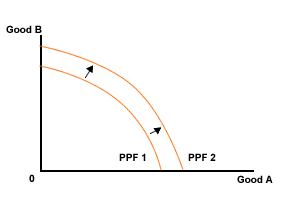
Figure 1 Increased investment shifting the production possibility frontier
The model concludes that:
- Increasing the savings ratio, or the amount of investment or the rate of technological progress are vital for the growth process
- Economic growth depends on the amount and quality of labour and capital.
- As developing countries often have an abundant supply of labour, it is a lack of physical capital that holds back economic growth and development.
- More physical capital generates economic growth.
- Net investment leads to more capital accumulation, which generates higher output and income.
- Higher income allows higher levels of saving.
The key to economic growth is therefore to expand the level of investment, both in terms of fixed capital and human capital. To do this, policies are needed that encourage saving and/or generate technological advances enabling firms to produce more output with less capital, i.e. lower their capital output ratio.
The model has been criticised for focusing on economic growth. Problems with the approach include:
- Economic growth and economic development are not the same. Economic growth is a necessary, but not sufficient, condition for development
- Savings and investment are a necessary, but not sufficient, condition for development
- On a practical level, it is difficult to stimulate the level of domestic savings, particularly in the case of developing countries where incomes are low.
- Borrowing from overseas to fill the gap caused by insufficient savings causes debt repayment problems later.
- The law of diminishing returns would suggest, that as investment increases, the productivity of capital will diminish and the capital to output ratio will therefore rise.
Structural Change Model
If you would prefer to view this interaction in a new web window, then please follow the link below:
Dual Sector Model
 Lewis Dual Sector Model
Lewis Dual Sector Model
This famous West Indian economist felt that productivity was central to the development of an economy. This was best achieved by encouraging migration of workers from the less productive sectors of the economy, for example agriculture, which is traditional, into the newer industries of manufacturing and the tertiary sector. The latter would be more productive and so accumulate greater wealth. In turn, this would generate greater funds for government through taxation, and enable them to spend on the essentials of development. Savings would be encouraged as rates of return would increase. Lewis felt that the marginal productivity of a rural worker was low.
However, the Lewis model also has problems which include the following:
- As increasing rural-urban migration takes place, a more unequal distribution of income is caused, as the rural migrants initially join the ranks of the urban poor.
- The idea that the productivity of labour in rural areas is almost zero may be true for certain times of the year. However, during planting and harvesting, the need for labour is critical to the needs of the rural areas.
- The assumption of a constant demand for labour from the industrial sector is questionable. Increasing technology may be labour saving, reducing the need for labour. In addition, if the industry concerned declines, again the demand for labour will fall.
- The idea of 'trickle down' has been criticised. Will higher incomes earned in the industrial sector be saved? If the entrepreneurs and labour spend their new found gains rather than save them, funds for investment and growth will not be made available.
- The rural urban migration has, for many LDCs, been far larger that the industrial sector can provide jobs for. Urban poverty has replaced rural poverty.
- The model ignores the cost of training and educating the surplus labour from the rural sector, who need to be equipped with new skills to work in the urban sector.
4.8 The balance between markets and intervention (questions)
In this section are a series of questions on the topic - the balance between markets and intervention. The questions may include various types of questions. For example:
- Short-answer questions - a series of short-answer questions to help you check your understanding of the topic
- Case studies - questions based around a variety of information
- Long answer - questions requiring an extended/essay type response
- Data response - responding to data or topical economics news articles
Click on the right arrow at the top or bottom of the page to work through the questions.
Short answers

Question 1
Evaluate the effects of schemes aimed at stabilizing the prices of primary commodity on producers and consumers.
Question 2
Explain the reasons for the growth, and increasing importance, of MNCs over the last half century.
Question 3
"The benefits of economic growth will, without any government intervention, trickle down to benefit the poor." Do you agree with this statement? Justify your answer.
Question 4
Analyse the advantages and disadvantages of foreign direct investment for developing countries.
Question 5
Explain why a floating exchange rate may be considered as a market oriented growth strategy.
Long answers

Try in each case to formulate a plan of how you would tackle them using bullet points. If you were writing an essay, or an answer to the final part of a data response question, each bullet represents a paragraph, which you expand upon in your final answer. Examiners are very keen on structure and the use of paragraphs. These questions are extremely open-ended, so there are no right or wrong answers as such (though they must have appropriate economic theory) - follow the links in each case for a selection of points you might have raised.
Question 1
Explain the main features of interventionist and market-led strategies to achieve growth and development.
Question 1 - answer
Question 2
Outline the various strategies which a country may deploy to achieve economic development.
Question 2 - answer
Question 3
Explain the likely changes in economic policy that would be necessary if a country moved from an interventionist to a market-oriented development strategy.
Question 3 - answer
Question 4
Discuss the arguments for and against completely unrestricted financial capital flows into, and out of, developing countries.
Question 4 - answer
Question 5
Discuss the advantages and disadvantages of interventionist growth and development strategies. Define growth and development.
Question 5 - answer
Question 6
Discuss the advantages and disadvantages of market-oriented growth and development strategies. Define growth and development.



